2019 Corrections and Conditional Release Statistical Overview
 2019 Corrections and Conditional Release Statistical Overview - PDF Version (5.4 MB)
2019 Corrections and Conditional Release Statistical Overview - PDF Version (5.4 MB)
Date: September 2020
© Her Majesty the Queen in Right of Canada, 2020
Cat. No.: PSI-3E-PDF
ISSN: 1713-1073
Corrections and Conditional Release Statistical Overview 2019
This document was produced by the Public Safety Canada Portfolio Corrections Statistics Committee which is composed of representatives of Public Safety Canada, Correctional Service Canada, Parole Board of Canada, the Office of the Correctional Investigator and the Canadian Centre for Justice and Community Safety Statistics (Statistics Canada).
Table of contents
- Preface
- Contributing Partners
- Section A. Context – Crime and the criminal justice system
- Police-reported crime rate has declined.
- Crime rates are higher in the West and highest in the North.
- Canada has a below average incarceration rate across Western European countries.
- Canada's incarceration rate has declined.
- The rate of adults charged has declined.
- Impaired Driving, Common Assault and Theft are the three most frequent cases in adult courts.
- Most adult custodial sentences ordered by the court are short.
- Few cases with guilty findings result in admissions to federal jurisdiction.
- The rate of youth charged has declined over the past ten years.
- The most common youth court case is common assault.
- The most common sentence for youth is probation.
- Section B. Corrections administration
- Expenditures on corrections has increased.
- CSC employees are concentrated in custody centres.
- The cost of keeping an inmate incarcerated has increased.
- The number of Parole Board of Canada employees.
- The number of employees in the Office of the Correctional Investigator.
- Health care is the most common area of offender complaint received by the Office of the Correctional Investigator.
- Section C. Offender population
- Offenders under the responsibility of CSC.
- The number of offenders in custody.
- The number of admissions to federal jurisdiction is decreasing.
- Over the last ten years, the number of women admitted from the courts to federal jurisdiction has increased.
- About half of the total offender population in CSC facilities is serving a sentence of less than five years.
- Admission of older offenders to federal jurisdiction is increasing.
- The average age at admission to federal jurisdiction is lower for Indigenous offenders.
- 24% of the in-custody offender population is age 50 or over.
- 54% of offenders are Caucasian.
- The religious identification of the offender population is diverse.
- The proportion of Indigenous offenders in custody is higher than for non-Indigenous offenders.
- The majority of in-custody offenders are classified as medium security risk.
- Admissions to federal jurisdiction with a life or indeterminate sentence has decreased.
- Offenders with life or indeterminate sentences represents 24% of the total offender population.
- 70% of offenders are serving a sentence for a violent offence.
- The number of Indigenous offenders has increased.
- The total number of offenders admitted to administrative segregation has increased.
- 75% of offenders admitted to administrative segregation stay for less than 30 days.
- The number of offender deaths while in custody has increased.
- The number of escapees has decreased.
- The population of offenders in the community under supervision has increased.
- The provincial/territorial community corrections population has remained stable.
- The number of offenders on provincial parole increased.
- Section D. Conditional release
- The percentage of offenders released from a federal institution or Healing Lodge at statutory release has decreased.
- The percentage of offenders released from a federal institution or Healing Lodge on day parole has increased.
- Federal day and full parole grant rates increased.
- Federal day and full parole grant rates for Indigenous offenders increased.
- The number of federal Elder-Assisted parole hearings increased.
- Proportion of sentence served prior to being released on parole decreased for women.
- Indigenous offenders serve a higher proportion of their sentences before being released on parole.
- The successful completion rate of federal day parole supervision periods remained stable.
- The successful completion rate of federal full parole supervision periods decreased.
- The successful completion rate of statutory release supervision periods remained stable.
- Over the last ten years, the rates of conviction for violent offences for offenders on federal conditional release has declined.
- The number of offenders granted temporary absences remain stable.
- Section E. Statistics on special applications of criminal justice
- Section F. Victims of crime
- Victimization rates for theft of personal property and assault decreased in 2014.
- The majority of victims of violent crime are under age 30.
- The majority of victims receiving services are victims of violent crime.
- The number of victims registered with the federal correctional system has increased.
- 74% of registered victims were victims of an offence causing death.
- 51% of notifications to registered victims were temporary absences.
- Parole Board of Canada contacts with victims has increased.
- Victims presenting a statement at PBC hearings.
- Victims requesting access to the decision registry.
Preface
This document provides a statistical overview of corrections and conditional release within a context of trends in crime and criminal justice. A primary consideration in producing this overview was to present general statistical information in a "user friendly" way that will facilitate understanding by a broad audience. Accordingly, there are several features of this document that make it different from typical statistical reports.
- First, the visual representation of the statistics is simple and uncluttered, and under each chart there are a few key points that will assist the reader in extracting the information from the chart.
- Second, for each chart there is a table of numbers corresponding to the visual representation. In some instances, the table includes additional numbers, e.g., a five-year series, even though the chart depicts the data for the most recent year (e.g., Figure A2).
- Third, rather than using the conventional headings for statistics (e.g., "Police-reported crime rate by year by type of crime") the titles for each chart and table inform the reader about the matter at hand (e.g., "Police-reported crime rate has declined").
- Fourth, notes have been kept to a minimum, that is, only where they were judged to be essential for the reader to understand the statistics.
- Finally, the source of the statistics is indicated under each chart so that the interested reader can easily access more information if desired.
The Corrections and Conditional Release Statistical Overview (CCRSO) has been published annually since 1998. Readers are advised that in some instances figures have been revised from earlier publications. Also, the total number of offenders will vary slightly depending on the characteristics of the data set.
Regarding police crime data from Statistics Canada, until the late 1980s, the Uniform Crime Reporting (UCR) survey provided aggregate counts of the number of incidents reported to police and the number of persons charged by type of offence. With the advent of microdata reporting, the UCR has become an "incident-based" survey (UCR2), collecting in-depth information about each criminal incident. The update to this new survey, as well as revisions to the definitions of violent crime, property crime, and other Criminal Code offences has resulted in data only being available from 1998 to the present. It is worth noting that the Total Crime Rates presented in the CCRSO differ from those reported by Statistics Canada in their publications. The Total Crime Rates reported in the CCRSO include offences (i.e., traffic offences in the Canadian Criminal Code and violations of federal statutes) that are excluded in the rates published by Statistics Canada.
The CCRSO serves as a useful source of statistical information on corrections and conditional release which assists the public in gaining a better understanding of these important components of the criminal justice system. The format of this document has been updated to optimize the user experience by implementing industry-standard data visualization techniques to improve accessibility and usability. For more information, see the Standard on Web Accessibility and the Standard on Web Usability.
To continually improve this annual publication, we welcome your comments by email at: PS.CPBResearch-RechercheSPC.SP@ps-sp.gc.ca
Contributing Partners
Public Safety Canada
Public Safety Canada is Canada's lead federal department for public safety, which includes emergency management, national security and community safety. Its many responsibilities include developing legislation and policies that govern corrections, implementing innovative approaches to community justice, and providing research expertise and resources to the corrections community.
Correctional Service Canada
The Correctional Service of Canada (CSC) is the federal government agency responsible for administering sentences of a term of two years or more, as imposed by the courts. CSC is responsible for managing institutions of various security levels and supervising offenders under conditional release in the community.
Parole Board of Canada
The Parole Board of Canada is an independent administrative tribunal responsible for making decisions about the timing and conditions of release of offenders into the community on various forms of conditional release. The Board also makes pardon, record suspension and expungement decisions and recommendations respecting clemency through the Royal Prerogative of Mercy.
Office of the Correctional Investigator
The Office of the Correctional Investigator is an ombudsman for federal offenders. It conducts investigations into the problems of offenders related to decisions, recommendations, acts or omissions of the Correctional Service of Canada that affect offenders individually or as a group.
Canadian Centre for Justice and Community Safety Statistics (Statistics Canada)
The Canadian Centre for Justice and Community Safety Statistics (CCJCSS) is a division of Statistics Canada. The CCJCSS is the focal point of a federal-provincial-territorial partnership, known as the National Justice Statistics Initiative, for the collection of information on the nature and extent of crime and the administration of civil and criminal justice in Canada.
Section A. Context – Crime and the Criminal Justice System
Police-reported crime rate has declined
Figure A1
Rate per 100,000 population
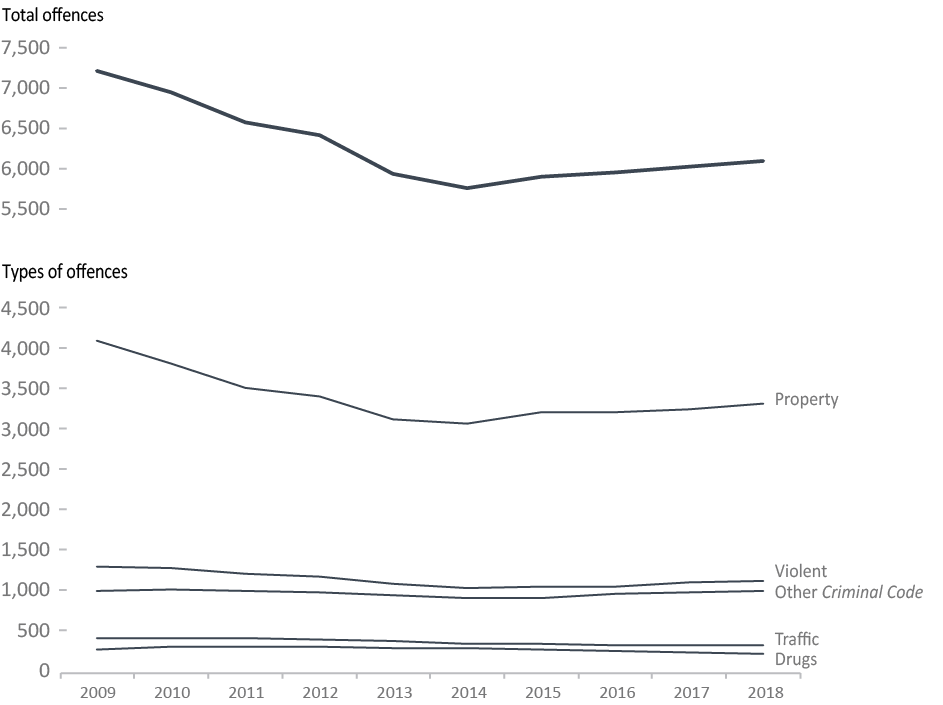
Source: Table 35-10-0177-01, Uniform Crime Reporting Survey, Canadian Centre for Justice and Community Safety Statistics, Statistics Canada.
- The overall crime rate has decreased 15.9% since 2009, from 7,281 per 100,000 to 6,123 in 2018.
- Over the same period, there was a 19.0% decrease in the property crime rate, from 4,122 per 100,000 to 3,339 in 2018. The crime rate for drug offences has decreased 22.7% since 2009, from 291 per 100,000 population to 225.
- Since 2009, The rate of violent crime has decreased 13.5%, from 1,322 per 100,000 to 1,144 per 100,000 in 2018.
- In general, the crime rates for traffic offences and other Criminal Code offences* have fluctuated since 2009.
Notes:
*"Other Criminal Code offences" includes administration of justice violations, weapons/firearms violations, counterfeit, possession of, accessing, making or distribution of child pornography and prostitution.
Unlike Statistics Canada, the Total Crime Rate in the Corrections and Conditional Release Statistical Overview includes traffic offences and violations of federal statutes to provide a measure of all criminal offences. As a result, the Total Crime Rate reported here is higher than that reported by Statistics Canada.
The definitions for Violent, Property and Other Criminal Code offences have been revised by Statistics Canada to better reflect definitions used by the policing community. As a result of these changes, comparable data are only available starting in 1998 and the data presented in this year's report are not comparable to the data reported in previous versions of the Corrections and Conditional Release Statistical Overview.
These crime statistics are based on crimes that are reported to the police. Since not all crimes are reported to the police, these figures underestimate actual crime. See Figure F1 for rates based on victimization surveys (drawn from the General Social Survey), an alternative method of measuriTableau E2ng crime.
Type of Offence |
|||||||
|---|---|---|---|---|---|---|---|
Year |
Violent |
Property |
Traffic |
Other CCC* |
Drugs |
Other Fed. Statutes |
Total Charged |
1998 |
1,345 |
5,696 |
469 |
1,051 |
235 |
40 |
8,836 |
1999 |
1,440 |
5,345 |
388 |
910 |
264 |
44 |
8,391 |
2000 |
1,494 |
5,189 |
370 |
924 |
287 |
43 |
8,307 |
2001 |
1,473 |
5,124 |
393 |
989 |
288 |
62 |
8,329 |
2002 |
1,441 |
5,080 |
379 |
991 |
296 |
54 |
8,241 |
2003 |
1,435 |
5,299 |
373 |
1,037 |
274 |
46 |
8,464 |
2004 |
1,404 |
5,123 |
379 |
1,072 |
305 |
50 |
8,333 |
2005 |
1,389 |
4,884 |
378 |
1,052 |
290 |
60 |
8,053 |
2006 |
1,387 |
4,809 |
376 |
1,050 |
295 |
57 |
7,974 |
2007 |
1,354 |
4,525 |
402 |
1,029 |
308 |
59 |
7,677 |
2008 |
1,334 |
4,258 |
437 |
1,039 |
308 |
67 |
7,443 |
2009 |
1,322 |
4,122 |
435 |
1,017 |
291 |
57 |
7,244 |
2010 |
1,292 |
3,838 |
420 |
1,029 |
321 |
61 |
6,961 |
2011 |
1,236 |
3,536 |
424 |
1,008 |
330 |
60 |
6,594 |
2012 |
1,199 |
3,438 |
407 |
1,000 |
317 |
67 |
6,428 |
2013 |
1,096 |
3,154 |
386 |
956 |
310 |
52 |
5,954 |
2014 |
1,044 |
3,099 |
365 |
918 |
295 |
49 |
5,770 |
2015 |
1,070 |
3,231 |
353 |
930 |
280 |
51 |
5,915 |
2016 |
1,076 |
3,239 |
346 |
982 |
267 |
59 |
5,969 |
2017 |
1,113 |
3,266 |
343 |
997 |
254 |
69 |
6,042 |
2018 |
1,144 |
3,339 |
339 |
1,006 |
225 |
57 |
6,110 |
Source: Table 35-10-0177-01, Uniform Crime Reporting Survey, Canadian Centre for Justice and Community Safety Statistics, Statistics Canada.
Notes:
*"Other Criminal Code offences" (Other CCC) includes administration of justice violations, weapons/firearms violations, counterfeit, possession of, accessing, making or distribution of child pornography and prostitution.
Unlike Statistics Canada, the Total Crime Rate in the Corrections and Conditional Release Statistical Overview includes traffic offences and violations of federal statutes to provide a measure of all criminal offences. As a result, the Total Crime Rate reported here is higher than that reported by Statistics Canada.
The definitions for Violent, Property, Other Criminal Code offences, and Total Other Federal Statutes have been revised by Statistics Canada to better reflect definitions used by the policing community. As a result of these changes, comparable data are only available starting in 1998 and the data presented in this year's report are not comparable to the data reported in previous versions of the Corrections and Conditional Release Statistical Overview.
Rates are based on incidents reported per 100,000 population.
Crime rates are higher in the West and highest in the North
Figure A2
Crime rate per 100,000 population (2018)
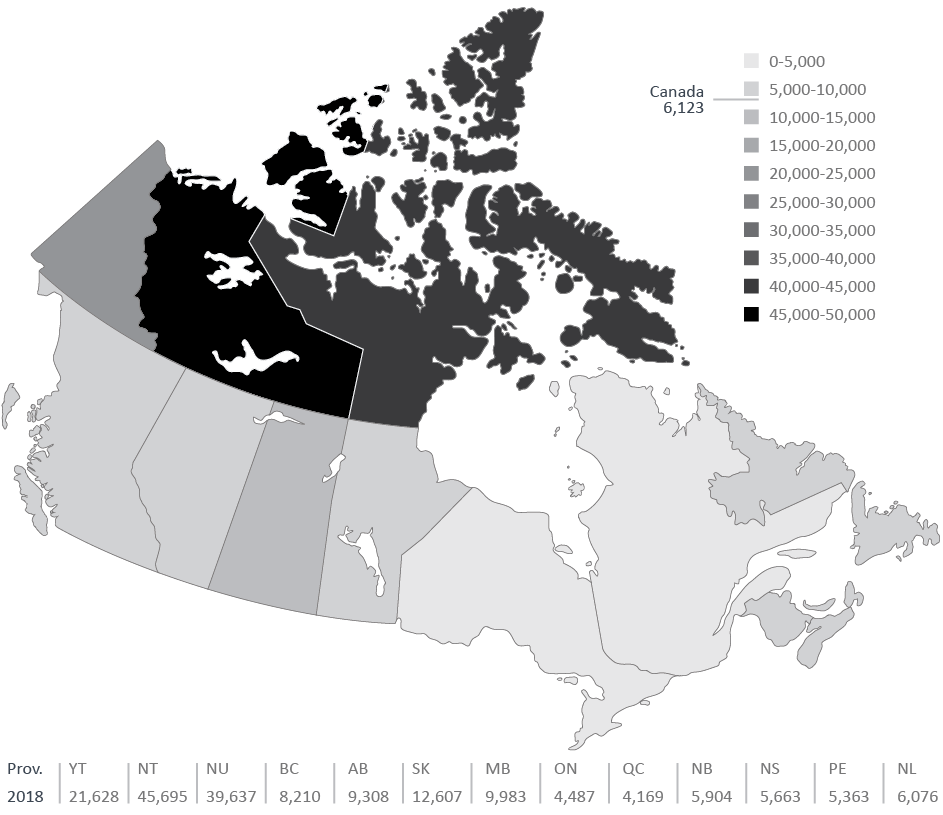
Source: Table 35-10-0177-01, Uniform Crime Reporting Survey, Canadian Centre for Justice and Community Safety Statistics, Statistics Canada.
- Crime rates are higher in the west and highest in the territories. This general pattern has been stable over time.
- The Canadian crime rate slightly increased from 5,793 per 100,000 in 2014 to 6,123 in 2018.
Notes:
Rates are based on 100,000 population.
Unlike Statistics Canada, the Crime Rate in the Corrections and Conditional Release Statistical Overview includes traffic offences and violations of federal statutes to provide a measure of all criminal offences. As a result, the Crime Rate reported here is higher than that reported by Statistics Canada. In addition, the definitions for Violent, Property and Other Criminal Code offences have been revised by Statistics Canada to better reflect definitions used by the policing community. As a result of these changes, comparable data are only available starting in 1998 and the data presented in this year's report are not comparable to the data reported in previous versions of the Corrections and Conditional Release Statistical Overview.
Crime Rate* |
|||||
|---|---|---|---|---|---|
Province/Territory |
2014 |
2015 |
2016 |
2017 |
2018 |
Newfoundland & Labrador |
6,218 |
6,371 |
6,501 |
6,038 |
6,076 |
Prince Edward Island |
5,364 |
4,750 |
5,013 |
4,708 |
5,363 |
Nova Scotia |
6,253 |
5,727 |
5,590 |
5,728 |
5,663 |
New Brunswick |
5,044 |
5,479 |
5,276 |
5,752 |
5,904 |
Quebec |
4,349 |
4,252 |
4,233 |
4,332 |
4,169 |
Ontario |
4,021 |
4,022 |
4,091 |
4,259 |
4,487 |
Manitoba |
8,412 |
8,926 |
9,508 |
9,754 |
9,983 |
Saskatchewan |
12,222 |
12,919 |
13,511 |
12,978 |
12,607 |
Alberta |
8,034 |
8,917 |
9,026 |
9,329 |
9,308 |
British Columbia |
8,492 |
8,608 |
8,489 |
8,102 |
8,210 |
Yukon Territories |
26,203 |
25,795 |
23,543 |
22,214 |
21,628 |
Northwest Territories |
46,659 |
47,230 |
43,320 |
44,492 |
45,695 |
Nunavut |
32,715 |
34,483 |
35,935 |
36,906 |
39,637 |
Canada |
5,793 |
5,934 |
5,987 |
6,057 |
6,123 |
Source: Table 35-10-0177-01, Uniform Crime Reporting Survey, Canadian Centre for Justice and Community Safety Statistics, Statistics Canada.
Notes:
*Rates are based on 100,000 population.
Unlike Statistics Canada, the Crime Rate in the Corrections and Conditional Release Statistical Overview includes traffic offences and violations of federal statutes to provide a measure of all criminal offences. As a result, the Crime Rate reported here is higher than that reported by Statistics Canada. In addition, the definitions for Violent, Property and Other Criminal Code offences have been revised by Statistics Canada to better reflect definitions used by the policing community. As a result of these changes, comparable data are only available starting in 1998 and the data presented in this year's report are not comparable to the data reported in previous versions of the Corrections and Conditional Release Statistical Overview.
Canada has a below average incarceration rate across Western European countries
Figure A3
Prison population per 100,000 (2019)
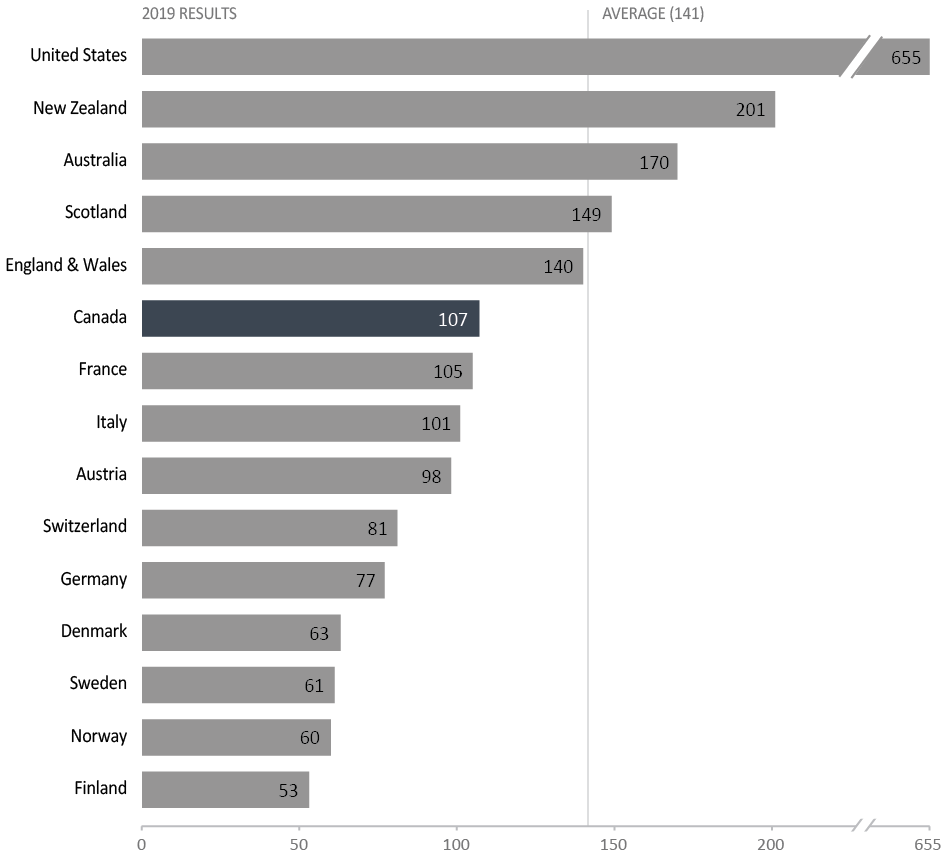
Source: World Prison Brief, Institute for Crime & Justice Policy Research (ICPR) (retrieved February 20, 2020 at www.prisonstudies.org/highest-to-lowest/prison-population-total).
- Canada's incarceration rate is higher than the rates in most western European countries but much lower than the United States, where the most recent incarceration rate was 655 per 100,000 general population.
- Based on the most up-to-date information available from the Institute for Crime & Justice Policy Research (ICPR), Canada's incarceration rate was 107 per 100,000. When ranked from highest to lowest, Canada's prison population rate was ranked 141 of 223 countries.
- Finland's incarceration rate was 53 per 100,000, the lowest incarceration rate among western European countries.
Notes:
The incarceration rate, in this figure, is a measure of the number of people (i.e., adults and youth) in custody per 100,000 people in the general population. Incarceration rates from the World Prison Brief hosted by the Institute for Crime & Justice Policy Research (ICPR) are based on the most recently available data at the time the list was compiled. The data was retrieved online on February 20, 2020 from http://www.prisonstudies.org which contains the most up to date information available. These data reflect incarceration rates based on the country's population. Additionally, different practices and variations in measurement in different countries limit the comparability of these figures.
2011 |
2012 |
2013 |
2014 |
2015 |
2016 |
2017 |
2018 |
2019 |
|
|---|---|---|---|---|---|---|---|---|---|
United States |
743 |
730 |
716 |
707 |
698 |
693 |
666 |
655 |
655 |
New Zealand |
199 |
194 |
192 |
190 |
190 |
203 |
214 |
214 |
201 |
England & Wales |
155 |
154 |
148 |
149 |
148 |
147 |
146 |
140 |
140 |
Scotland |
155 |
151 |
147 |
144 |
144 |
142 |
138 |
143 |
149 |
Australia |
133 |
129 |
130 |
143 |
151 |
152 |
168 |
172 |
170 |
Canada |
117 |
114 |
118 |
118 |
106 |
114 |
114 |
114 |
107 |
Italy |
110 |
109 |
106 |
88 |
86 |
90 |
95 |
98 |
101 |
Austria |
104 |
104 |
98 |
99 |
95 |
93 |
94 |
98 |
98 |
France |
102 |
102 |
101 |
102 |
100 |
103 |
103 |
100 |
105 |
Germany |
87 |
83 |
79 |
81 |
78 |
78 |
77 |
75 |
77 |
Switzerland |
79 |
76 |
82 |
87 |
84 |
83 |
82 |
81 |
81 |
Sweden |
78 |
70 |
67 |
57 |
60 |
53 |
57 |
59 |
61 |
Denmark |
74 |
74 |
73 |
67 |
61 |
58 |
59 |
63 |
63 |
Norway |
73 |
73 |
72 |
75 |
71 |
74 |
74 |
63 |
60 |
Finland |
59 |
59 |
58 |
55 |
57 |
55 |
57 |
51 |
53 |
Source: World Prison Brief, Institute for Crime & Justice Policy Research (ICPR) (retrieved February 20, 2020 at www.prisonstudies.org/highest-to-lowest/prison-population-total).
Notes:
Incarceration rates from the World Prison Brief are based on the most recently available data at the time the list was compiled. For 2019, the data was retrieved online on February 20, 2020 at www.prisonstudies.org which contains the most up to date information available. Additionally, different practices and variations in measurement in different countries limit the comparability of these figures. Rates are based on 100,000 population.
*Table A3 and A4 display the same data.
Canada's incarceration rate has declined
Figure A4
Prison population rate per 100,000
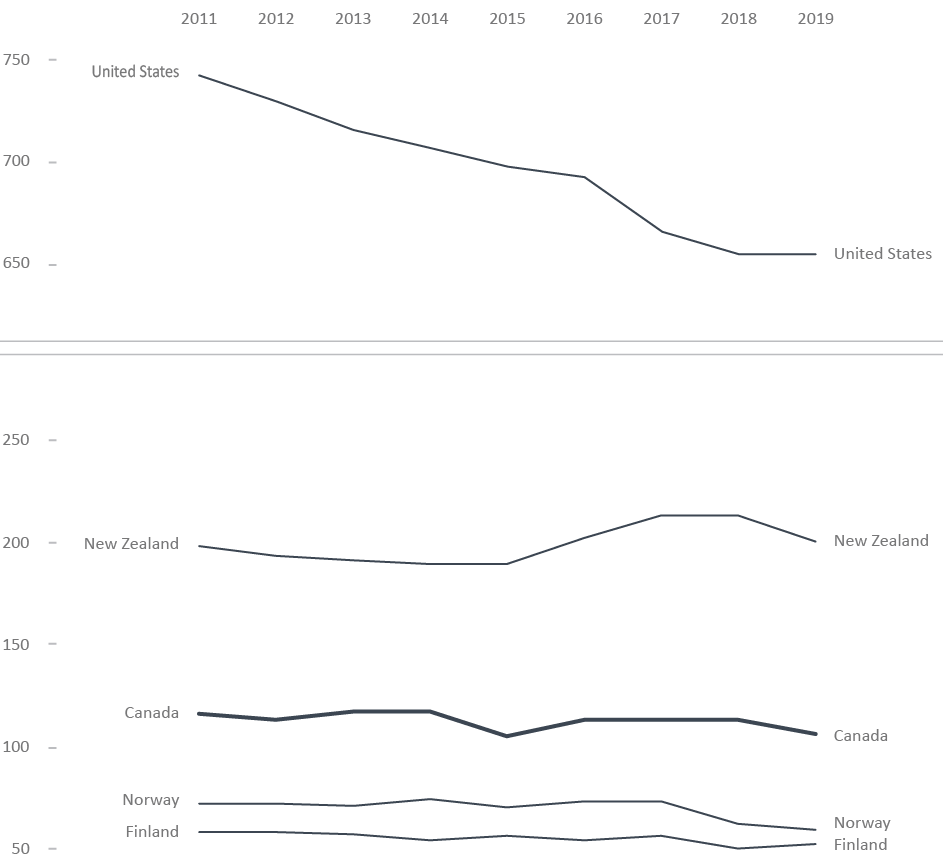
Source: World Prison Brief, Institute for Crime & Justice Policy Research (ICPR) (retrieved February 20, 2020 at www.prisonstudies.org/highest-to-lowest/prison-population-total).
- Since 2011, Canada's incarceration rate has decreased 8.6%, from 117 per 100,000 to 107 per 100,000 in 2019. The largest decline during this period was in 2015, Canada's incarceration rate decreased 10.17% from 118 per 100,000 in 2014 to 106 per 100,000 in 2015.
- Since 2011, the incarceration rate of the United States has steadily declined. It has decreased 11.8% from 743 per 100,000 in 2011 to 655 per 100,000 in 2019.
- Over the same period, New Zealand's incarceration rate has increased 1.0% from 199 to 201 per 100,000. In 2017 and 2018, New Zealand's incarceration rate was at 214 per 100,000, an increase of 7.5% from 2011 (199 per 100,000). New Zealand's incarceration rate has since decreased 6.1% from 214 per 100,000 in 2018 to 201 per 100,000 in 2019.
- Since 2011, the incarceration rates of Norway and Finland have remained stable.
Notes:
The incarceration rate, in this figure, is a measure of the number of people (i.e., adults and youth) in custody per 100,000 people in the general population. Incarceration rates from the World Prison Brief hosted by the Institute for Crime & Justice Policy Research (ICPR) are based on the most recently available data at the time the list was compiled. The data was retrieved online on February 20, 2020 from http://www.prisonstudies.org which contains the most up to date information available. These data reflect incarceration rates based on the country's population. Additionally, different practices and variations in measurement in different countries limit the comparability of these figures.
2011 |
2012 |
2013 |
2014 |
2015 |
2016 |
2017 |
2018 |
2019 |
|
|---|---|---|---|---|---|---|---|---|---|
United States |
743 |
730 |
716 |
707 |
698 |
693 |
666 |
655 |
655 |
New Zealand |
199 |
194 |
192 |
190 |
190 |
203 |
214 |
214 |
201 |
England & Wales |
155 |
154 |
148 |
149 |
148 |
147 |
146 |
140 |
140 |
Scotland |
155 |
151 |
147 |
144 |
144 |
142 |
138 |
143 |
149 |
Australia |
133 |
129 |
130 |
143 |
151 |
152 |
168 |
172 |
170 |
Canada |
117 |
114 |
118 |
118 |
106 |
114 |
114 |
114 |
107 |
Italy |
110 |
109 |
106 |
88 |
86 |
90 |
95 |
98 |
101 |
Austria |
104 |
104 |
98 |
99 |
95 |
93 |
94 |
98 |
98 |
France |
102 |
102 |
101 |
102 |
100 |
103 |
103 |
100 |
105 |
Germany |
87 |
83 |
79 |
81 |
78 |
78 |
77 |
75 |
77 |
Switzerland |
79 |
76 |
82 |
87 |
84 |
83 |
82 |
81 |
81 |
Sweden |
78 |
70 |
67 |
57 |
60 |
53 |
57 |
59 |
61 |
Denmark |
74 |
74 |
73 |
67 |
61 |
58 |
59 |
63 |
63 |
Norway |
73 |
73 |
72 |
75 |
71 |
74 |
74 |
63 |
60 |
Finland |
59 |
59 |
58 |
55 |
57 |
55 |
57 |
51 |
53 |
Source: World Prison Brief, Institute for Crime & Justice Policy Research (ICPR) (retrieved February 20, 2020 at www.prisonstudies.org/highest-to-lowest/prison-population-total).
Notes:
Incarceration rates from the World Prison Brief are based on the most recently available data at the time the list was compiled. For 2019, the data was retrieved online on February 20, 2020 at www.prisonstudies.org which contains the most up to date information available. Additionally, different practices and variations in measurement in different countries limit the comparability of these figures. Rates are based on 100,000 population.
*Table A3 and A4 display the same data.
The rate of adults charged has declined
Figure A5
Rate per 100,000 adult population
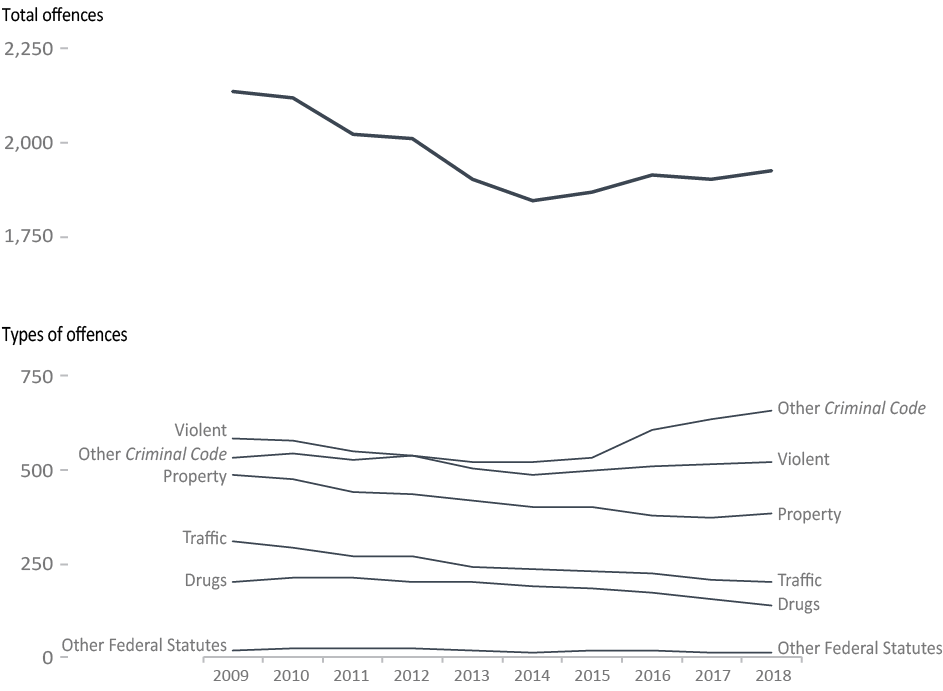
Source: Table 35-10-0177-01, Uniform Crime Reporting Survey, Canadian Centre for Justice and Community Safety Statistics, Statistics Canada.
- Since 2009, the rate of adults charged has decreased 10.5% from 2,152 adults per 100,000 to 1,927 in 2018.
- Over the same period, the rate of adults charged with violent crimes has decreased by 10.6% from 585 adults per 100,000 to 523 in 2018.
- Since 2009, the rate of adults charged for property offences decreased by 21.4% from 490 adults per 100,000 to 385 in 2018, whereas the rate of other Criminal Code offences* increased by 24.3% from 532 adults per 100,000 to 661 in 2018.
Notes:
*"Other Criminal Code offences" includes administration of justice violations, weapons/firearms violations, counterfeit, possession of, accessing, making or distribution of child pornography and prostitution.
Unlike Statistics Canada, the Total Crime Rate in the Corrections and Conditional Release Statistical Overview includes traffic offences and violations of federal statutes to provide a measure of all criminal offences. As a result, the Total Crime Rate reported here is higher than that reported by Statistics Canada.
The definitions for Violent, Property and Other Criminal Code offences have been revised by Statistics Canada to better reflect definitions used by the policing community. As a result of these changes, comparable data are only available starting in 1998 and the data presented in this year's report are not comparable to the data reported in previous versions of the Corrections and Conditional Release Statistical Overview.
Violent crimes include homicide, attempted murder, assault, sexual offences, abduction, extortion, robbery, firearms, and other violent offences such as uttering threats and criminal harassment.
Property crimes include break and enter, motor vehicle thefts, other thefts, possession of stolen property, fraud, mischief and arson.
Type of Offence |
||||||||
|---|---|---|---|---|---|---|---|---|
Year |
Violent |
Property |
Traffic |
Other CCC* |
Drugs |
Total Other Fed. Stat. |
Total Charged |
|
1998 |
563 |
677 |
374 |
430 |
168 |
12 |
2,224 |
|
1999 |
590 |
632 |
371 |
396 |
185 |
18 |
2,192 |
|
2000 |
615 |
591 |
349 |
411 |
198 |
16 |
2,180 |
|
2001 |
641 |
584 |
349 |
451 |
202 |
18 |
2,245 |
|
2002 |
617 |
569 |
336 |
460 |
199 |
18 |
2,199 |
|
2003 |
598 |
573 |
326 |
476 |
172 |
15 |
2,160 |
|
2004 |
584 |
573 |
314 |
490 |
187 |
22 |
2,170 |
|
2005 |
589 |
550 |
299 |
479 |
185 |
22 |
2,124 |
|
2006 |
594 |
533 |
300 |
498 |
198 |
20 |
2,143 |
|
2007 |
577 |
499 |
298 |
521 |
208 |
20 |
2,123 |
|
2008 |
576 |
487 |
307 |
540 |
207 |
22 |
2,139 |
|
2009 |
585 |
490 |
311 |
532 |
201 |
20 |
2,139 |
|
2010 |
576 |
473 |
295 |
545 |
211 |
22 |
2,122 |
|
2011 |
548 |
441 |
271 |
527 |
213 |
23 |
2,023 |
|
2012 |
541 |
434 |
269 |
536 |
203 |
25 |
2,008 |
|
2013 |
505 |
417 |
242 |
519 |
200 |
18 |
1,901 |
|
2014 |
489 |
399 |
233 |
520 |
191 |
13 |
1,845 |
|
2015 |
501 |
403 |
230 |
535 |
182 |
15 |
1,866 |
|
2016 |
511 |
381 |
222 |
609 |
171 |
18 |
1,912 |
|
2017 |
515 |
375 |
208 |
635 |
157 |
12 |
1,902 |
|
2018 |
523 |
385 |
203 |
661 |
138 |
13 |
1,923 |
|
Source: Table 35-10-0177-01, Uniform Crime Reporting Survey, Canadian Centre for Justice and Community Safety Statistics, Statistics Canada
Notes:
*"Other Criminal Code offences" (Other CCC) includes administration of justice offences, counterfeit, weapons/firearms violations, possession of, accessing, making or distribution of child pornography and prostitution.
Unlike Statistics Canada, the Total Crime Rate in the Corrections and Conditional Release Statistical Overview includes traffic offences and violations of federal statutes to provide a measure of all criminal offences. As a result, the Total Crime Rate reported here is higher than that reported by Statistics Canada.
The definitions for Violent, Property, Other Criminal Code offences, and Total Other Federal Statutes have been revised by Statistics Canada to better reflect definitions used by the policing community. As a result of these changes, comparable data are only available starting in 1998 and the data presented in this year's report are not comparable to the data reported in previous versions of the Corrections and Conditional Release Statistical Overview.
Rates are based on 100,000 population, 18 years of age and older. Due to rounding, rates may not add up to totals.
Violent crimes include homicide, attempted murder, assault, sexual offences, abduction, extortion, robbery, firearms, and other violent offences such as uttering threats and criminal harassment.
Property crimes include break and enter, motor vehicle theft, other theft, possession of stolen property, fraud, mischief and arson.
Impaired Driving, Common Assault and Theft are the three most frequent cases in adult courts
Figure A6
Percentage of Criminal Code and Other Federal Statute Charges (2017-18)
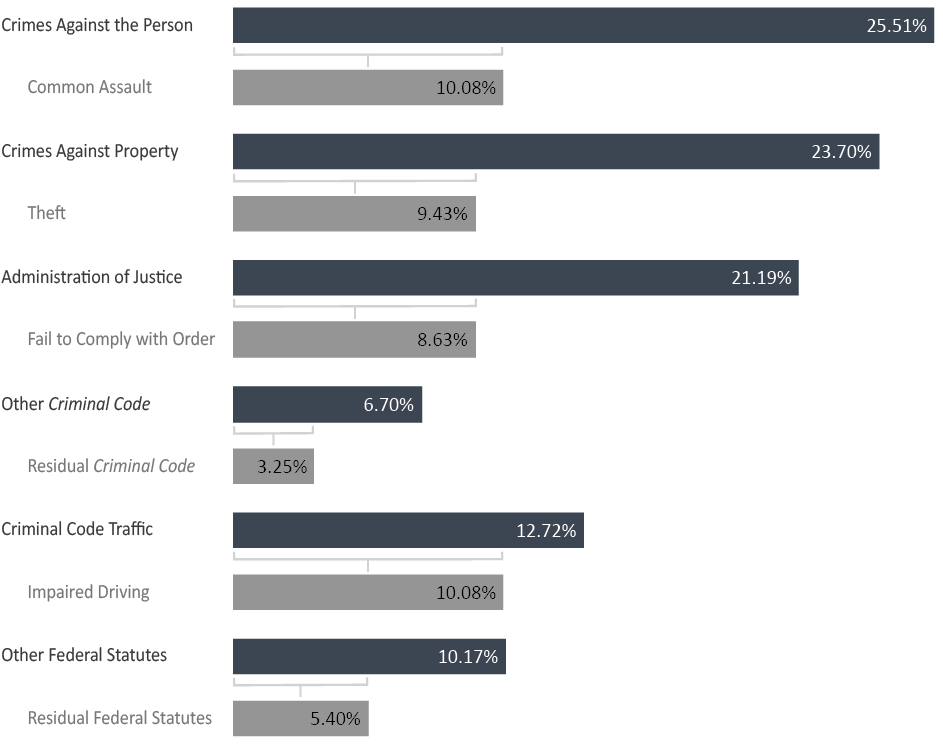
Source: Table 35-10-0027-01, Integrated Criminal Court Survey, Canadian Centre for Justice and Community Safety Statistics, Statistics Canada.
- Common Assault (Level 1) (10.1%), theft (9.4%) and impaired driving (10.1%) are the most frequent cases in adult courts.
- Administration of justice cases (offences related to case proceedings such as failure to appear in court, failure to comply with a court order, breach of probation, and unlawfully at large) account for 21.2% of cases completed in adult criminal courts. Breach of probation (8.4%) and failure to comply with a court order (8.6%) combined account for 17% of total cases in adult court.
Notes:
The concept of a case has changed to more closely reflect court processing. Statistics from the Integrated Criminal Court Survey used in this report should not be compared to editions of the Corrections and Conditional Release Statistical Overview prior to 2007. A case is one or more charges against an accused person or corporation, processed by the courts at the same time, and where all of the charges in the case received a final disposition. Where a case has more than one charge, it is necessary to select a charge to represent the case. An offence is selected by applying two rules. First, the "most serious decision" rule is applied. In cases where two or more offences have the same decision, the "most serious offence" rule is applied. All charges are ranked according to an offence seriousness scale. Superior Court data are not reported to the Integrated Criminal Court Survey for Prince Edward Island, Quebec, Ontario, Manitoba and Saskatchewan. In addition, information from Quebec's municipal courts is not collected.
The Canadian Centre for Justice and Community Safety Statistics continues to make updates to the offence library used to classify offence data sent by the provinces and territories. These improvements have resulted in minor changes in the counts of charges and cases as well as the distributions by type of offence. Data presented have been revised to account for these updates.
Due to rounding, percentages may not add up to 100 percent.
Type of Charge |
Criminal Code and Other Federal Statute Charges |
|||||
|---|---|---|---|---|---|---|
2015-16 |
2016-17 |
2017-18 |
||||
# |
% |
# |
% |
# |
% |
|
Crimes Against the Person |
80,824 |
23.56 |
85,112 |
23.96 |
87,691 |
25.51 |
Homicide and Related |
259 |
0.08 |
364 |
0.10 |
358 |
0.10 |
Attempted Murder |
206 |
0.06 |
203 |
0.06 |
184 |
0.05 |
Robbery |
3,358 |
0.98 |
3,576 |
1.01 |
3,436 |
1.00 |
Sexual Assault |
2,844 |
0.83 |
3,109 |
0.88 |
3,201 |
0.93 |
Other Sexual Offences |
3,695 |
1.08 |
3,950 |
1.11 |
4,253 |
1.24 |
Major Assault (Levels 2 & 3) |
18,900 |
5.51 |
20,201 |
5.69 |
20,433 |
5.94 |
Common Assault (Level 1) |
30,494 |
8.89 |
31,647 |
8.91 |
34,660 |
10.08 |
Uttering Threats |
14,879 |
4.34 |
15,261 |
4.30 |
13,715 |
3.99 |
Criminal Harassment |
3,345 |
0.98 |
3,538 |
1.00 |
3,681 |
1.07 |
Other Crimes Against Persons |
2,844 |
0.83 |
3,263 |
0.92 |
3,770 |
1.10 |
Crimes Against Property |
81,187 |
23.67 |
85,467 |
24.06 |
81,476 |
23.70 |
Theft |
35,197 |
10.26 |
36,138 |
10.18 |
32,400 |
9.43 |
Break and Enter |
9,325 |
2.72 |
9,968 |
2.81 |
9,529 |
2.77 |
Fraud |
11,476 |
3.35 |
12,728 |
3.58 |
12,407 |
3.61 |
Mischief |
12,411 |
3.62 |
12,955 |
3.65 |
13,024 |
3.79 |
Possession of Stolen Property |
10,929 |
3.19 |
11,646 |
3.28 |
11,799 |
3.43 |
Other Property Crimes |
1,849 |
0.54 |
2,032 |
0.57 |
2,317 |
0.67 |
Administration of Justice |
78,195 |
22.79 |
80,940 |
22.79 |
72,849 |
21.19 |
Fail to Appear |
4,113 |
1.20 |
4,442 |
1.25 |
4,037 |
1.17 |
Breach of Probation |
30,396 |
8.86 |
30,955 |
8.72 |
28,726 |
8.36 |
Unlawfully at Large |
2,591 |
0.76 |
2,693 |
0.76 |
2,853 |
0.83 |
Fail to Comply with Order |
33,290 |
9.70 |
34,632 |
9.75 |
29,676 |
8.63 |
Other Admin. Justice |
7,805 |
2.28 |
8,218 |
2.31 |
7,557 |
2.20 |
Other Criminal Code |
18,552 |
5.41 |
20,447 |
5.76 |
23,022 |
6.70 |
Weapons |
10,340 |
3.01 |
10,958 |
3.09 |
11,066 |
3.22 |
Prostitution |
172 |
0.05 |
402 |
0.11 |
49 |
0.01 |
Disturbing the Peace |
1,054 |
0.31 |
938 |
0.26 |
729 |
0.21 |
Residual Criminal Code |
6,986 |
2.04 |
8,149 |
2.29 |
11,178 |
3.25 |
Criminal Code Traffic |
46,086 |
13.43 |
45,833 |
12.90 |
43,730 |
12.72 |
Impaired Driving |
36,308 |
10.58 |
35,993 |
10.13 |
34,633 |
10.08 |
Other CC Traffic |
9,778 |
2.85 |
9,840 |
2.77 |
9,097 |
2.65 |
Other Federal Statutes |
38,214 |
11.14 |
37,360 |
10.52 |
34,946 |
10.17 |
Drug Possession |
12,517 |
3.65 |
10,675 |
3.01 |
8,496 |
2.47 |
Other Drug Offences |
8,550 |
2.49 |
8,506 |
2.39 |
7,903 |
2.30 |
Residual Federal Statutes |
17,147 |
5.00 |
18,179 |
5.12 |
18,547 |
5.40 |
Total Charges |
343,058 |
100.00 |
355,159 |
100.00 |
343,714 |
100.00 |
Source: Table 35-10-0027-01, Integrated Criminal Court Survey, Canadian Centre for Justice and Community Safety Statistics, Statistics Canada.
Notes:
The concept of a case has changed to more closely reflect court processing. Statistics from the Integrated Criminal Court Survey used in this report should not be compared to editions of the Corrections and Conditional Release Statistical Overview prior to 2007. Superior Court data are not reported to the Integrated Criminal Court Survey for Prince Edward Island, Quebec, Ontario, Manitoba and Saskatchewan. In addition, information from Quebec's municipal courts is not collected. The Canadian Centre for Justice Statistics continues to make updates to the offence library used to classify offence data sent by the provinces and territories. These improvements have resulted in minor changes in the counts of charges and cases as well as the distributions by type of offence. Data presented have been revised to account for these updates. Due to rounding, percentages may not add up to 100 percent.
Most adult custodial sentences ordered by the court are short
Figure A7
Length of prison sentence (2017-18)
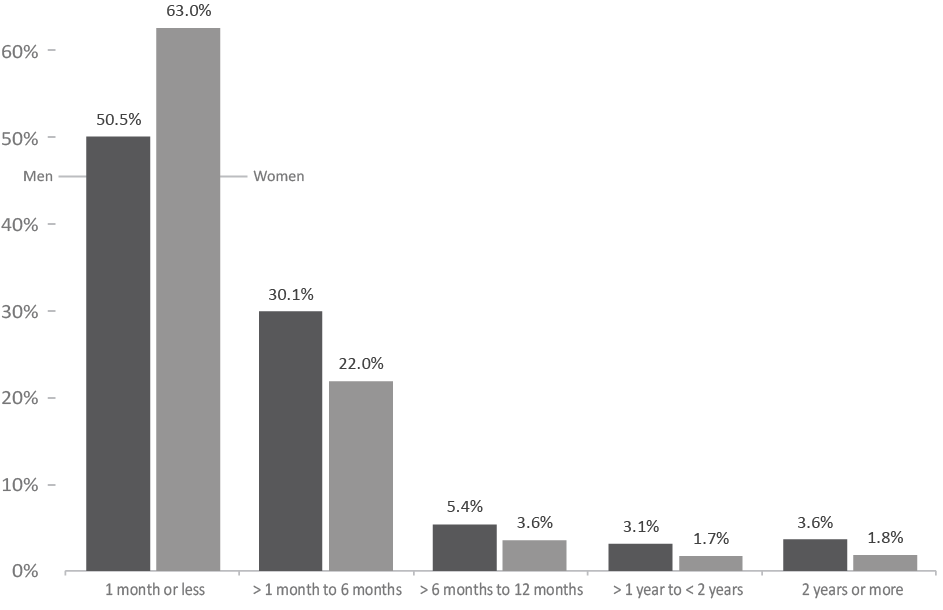
Source: Table 35-10-0032-01, Integrated Criminal Court Survey, Canadian Centre for Justice and Community Safety Statistics, Statistics Canada.
- Just under half (48.0%) of all custodial sentences imposed by adult criminal courts are one month or less. Prison sentences for men tend to be longer than for women. 63.0% of women and 50.5% of men who are incarcerated following a guilty* finding receive a sentence of one month or less, and 85.0% of women and 80.6% of men receive a sentence of six months or less.
Notes:
*The decision type "guilty" includes guilty of the offence, of an included offence, of an attempt of the offence, or of an attempt of an included offence. This category also includes cases where an absolute or conditional discharge has been imposed.
The concept of a case has changed to more closely reflect court processing. Statistics from the Integrated Criminal Court Survey used in this report should not be compared to editions of the Corrections and Conditional Release Statistical Overview prior to 2007.
Excludes cases where length of prison sentence and/or sex was not known, data for Manitoba as information on sentence length was not available.
Superior Court data are not reported to the Integrated Criminal Court Survey for Prince Edward Island, Quebec, Ontario, Manitoba and Saskatchewan. In addition, information from Quebec's municipal courts is not collected.
The Canadian Centre for Justice and Community Safety Statistics continues to make updates to the offence library used to classify offence data sent by the provinces and territories. These improvements have resulted in minor changes in the counts of charges and cases as well as the distributions by type of offence. Data presented have been revised to account for these updates.
Due to rounding, totals may not add up to 100 percent.
Length of Prison Sentence |
2013-14 |
2014-15 |
2015-16 |
2016-17 |
2017-18 |
|---|---|---|---|---|---|
% |
% |
% |
% |
% |
|
1 Month or Less |
|||||
Women |
63.1 |
62.7 |
64.4 |
63.7 |
63.0 |
Men |
50.1 |
51.2 |
51.9 |
52.0 |
50.5 |
Total |
47.7 |
48.6 |
49.4 |
49.4 |
48.0 |
More Than 1 Month up to 6 Months |
|||||
Women |
24.5 |
23.6 |
22.8 |
22.0 |
22.0 |
Men |
32.2 |
31.1 |
30.4 |
29.9 |
30.1 |
Total |
29.2 |
28.4 |
27.7 |
27.2 |
27.2 |
More Than 6 Months up to 12 Months |
|||||
Women |
3.9 |
3.7 |
3.3 |
3.3 |
3.6 |
Men |
6.0 |
5.9 |
5.5 |
5.2 |
5.4 |
Total |
5.5 |
5.4 |
5.0 |
4.7 |
4.9 |
More Than 1 Year up to Less Than 2 Years |
|||||
Women |
2.1 |
2.0 |
1.7 |
1.7 |
1.7 |
Men |
3.7 |
3.3 |
3.3 |
3.0 |
3.1 |
Total |
3.4 |
3.0 |
3.0 |
2.8 |
2.8 |
2 Years or More |
|||||
Women |
2.1 |
2.0 |
2.2 |
2.1 |
1.8 |
Men |
3.9 |
3.5 |
3.6 |
3.4 |
3.6 |
Total |
3.4 |
3.1 |
3.2 |
3.0 |
3.1 |
Source: Table 35-10-0032-01, Integrated Criminal Court Survey, Canadian Centre for Justice and Community Safety Statistics, Statistics Canada.
Notes:
Total includes the following categories: Males, Females, Company, and Sex Unknown.
The concept of a case has changed to more closely reflect court processing. Statistics from the Integrated Criminal Court Survey used in this report should not be compared to editions of the Corrections and Conditional Release Statistical Overview prior to 2007.
Excludes cases where length of prison sentence and/or sex was not known, data for Manitoba as information on both sentence length was not available.
Superior Court data are not reported to the Integrated Criminal Court Survey for Prince Edward Island, Quebec, Ontario, Manitoba and Saskatchewan. In addition, information from Quebec's municipal courts is not collected.
The Canadian Centre for Justice and Community Safety Statistics continues to make updates to the offence library used to classify offence data sent by the provinces and territories. These improvements have resulted in minor changes in the counts of charges and cases as well as the distributions by type of offence. Data presented have been revised to account for these updates.
Due to rounding, totals may not add up to 100 percent.
Few cases with guilty findings result in admissions to federal jurisdiction
Figure A8
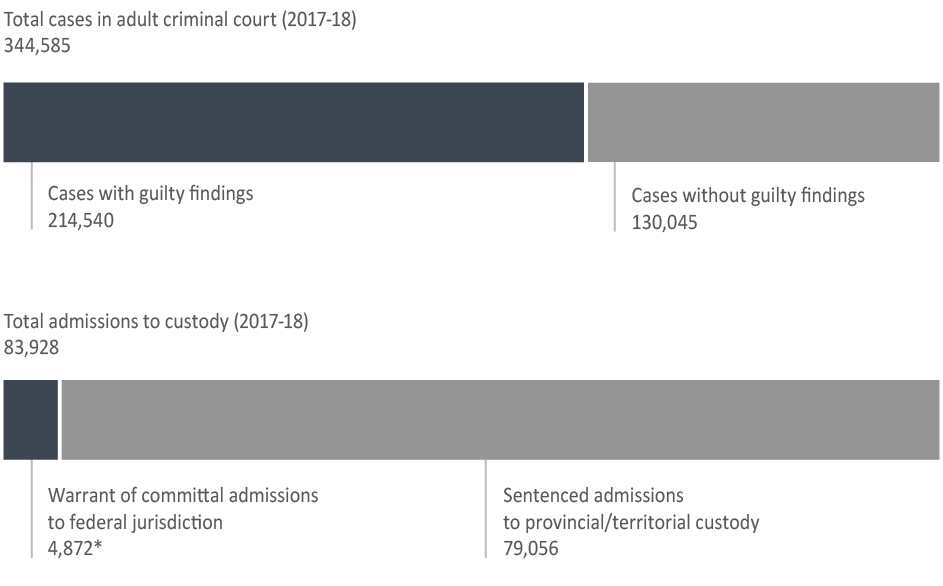
Sources: 1. Table 35-10-0027-01, Integrated Criminal Court Survey, Canadian Centre for Justice and Community Safety Statistics, Statistics Canada; 2. Table 35-10-0018-01, Uniform Crime Reporting Survey, Canadian Centre for Justice and Community Safety Statistics, Statistics Canada; 3. Correctional Service of Canada.
- In 2017-18, there were 214,540 cases with guilty findings** in adult criminal court.
- In 2017-18, there were 79,056 sentenced admissions to provincial/territorial custody, compared to 4,872 warrant of committal admissions for offenders sentenced to a federal institution or Healing Lodge.
Notes:
*2018-19 data is available for warrant of committal admissions to federal jurisdiction (CSC). In 2018-19, there were 4,749 warrant of committal admissions to a federal institution or Healing Lodge. During the preparation of this report, other sources were unable to provide 2018-19 data therefore, 2017-18 data are displayed for all sources.
**The decision type "guilty" includes guilty of the offence, of an included offence, of an attempt of the offence, or of an attempt of an included offence. This category also includes cases where an absolute or conditional discharge has been imposed.
This figure only includes cases in provincial court and partial data from Superior Court. Superior Court data are not reported to the Integrated Criminal Court
Survey for Prince Edward Island, Quebec, Ontario, Manitoba and Saskatchewan. Information from Quebec's municipal courts is not collected.
The concept of a case has changed to more closely reflect court processing. Statistics from the Integrated Criminal Court Survey used in this report should not be compared to editions of the Corrections and Conditional Release Statistical Overview prior to 2007. A case is one or more charges against an accused person or corporation, processed by the courts at the same time, and where all of the charges in the case received a final disposition.
Court and prison data are reported on a fiscal year basis (April 1 through March 31).
There is a lag in the data entry of admissions into CSC's Offender Management System. The admission figures for the most recent year are under-reported by 200-400 at the time of our year end extraction. More accurate figures will be available in the next year's publication. Please use caution when including the most recent year in any trend analysis.
2014-15 |
2015-16 |
2016-17 |
2017-18 |
2018-19 |
|
|---|---|---|---|---|---|
Total Case Decisions* in Adult Criminal Court1 |
346,571 |
344,234 |
356,170 |
344,585 |
Not available*** |
Cases with Guilty** Findings in Adult Criminal Court1 |
222,064 |
221,848 |
224,410 |
214,540 |
Not available*** |
Total Cases without Guilty Findings in Criminal Court1 |
124,507 |
122,386 |
131,760 |
130,045 |
Not available*** |
Acquitted1 |
11,839 |
11,086 |
13,029 |
12,532 |
Not available*** |
Stayed or withdrawn1 |
108,562 |
107,036 |
114,554 |
113,469 |
Not available*** |
Other decisions1 |
4,106 |
4,264 |
4,177 |
4,044 |
Not available*** |
Sentenced Admissions to Provincial/Territorial Custody2 |
62,279 |
62,771 |
84,543 |
79,056 |
Not available*** |
Warrant of Committal-Admission to FED (CSC)3 |
4,817 |
4,890 |
4,907 |
4,872 |
4,749 |
Sources:
1Table 35-10-0027-01, Integrated Criminal Court Survey, Canadian Centre for Justice and Community Safety Statistics, Statistics Canada;
2Table 35-10-0018-01, Uniform Crime Reporting Survey, Canadian Centre for Justice and Community Safety Statistics, Statistics Canada;
3Correctional Service of Canada.
Notes:
*The concept of a case has changed to more closely reflect court processing. Statistics from the Integrated Criminal Court Survey used in this report should not be compared to editions of the Corrections and Conditional Release Statistical Overview prior to 2007. A case is one or more charges against an accused person or corporation, processed by the courts at the same time, and where all of the charges in the case received a final disposition.
**The decision type "guilty" includes guilty of the offence, of an included offence, of an attempt of the offence, or of an attempt of an included offence. This category also includes cases where an absolute or conditional discharge has been imposed. This figure only includes cases convicted in provincial court and partial data from Superior Court. Superior Court data are not reported to the Integrated Criminal Court Survey for Prince Edward Island, Quebec, Ontario, Manitoba and Saskatchewan. Information from Quebec's municipal courts is not collected.
Police data are reported on a calendar year basis whereas court and prison data are reported on a fiscal year basis (April 1 through March 31).
***Data from 2018-19 were not yet released during the preparation of this report.
There is a lag in the data entry of admissions into CSC's Offender Management System. The admission figures for the most recent year are under-reported by 200-400 at the time of our year end extraction. More accurate figures will be available in the next year's publication. Please use caution when including the most recent year in any trend analysis.
The rate of youth charged has declined over the past ten years
Figure A9
Rate per 100,000 youth population
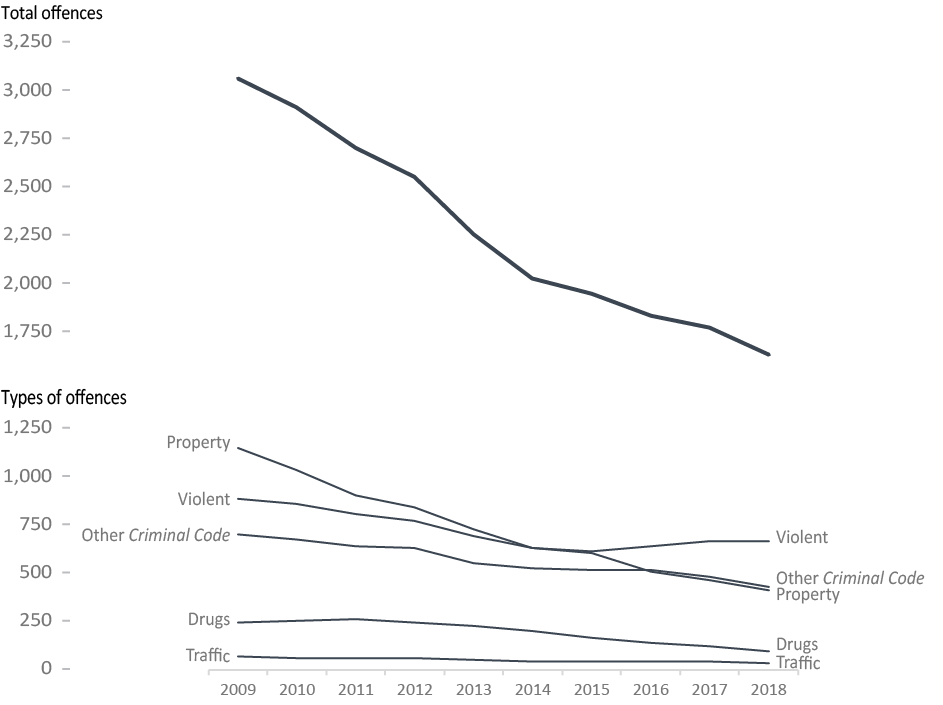
Source: Table 35-10-0177-01, Uniform Crime Reporting Survey, Canadian Centre for Justice and Community Safety Statistics, Statistics Canada.
- Since 2009, the rate of youth* charged has decreased 47.8%, from 3,294 per 100,000 youth to 1,719 in 2018.
- Since 2009, the rate of youth charged with property crimes has decreased by 64.4%, dropping from 1,143 per 100,000 youth to 407 in 2018. Over the same time period, other Criminal Code offences** decreased by 39.1% from 698 per 100,000 youth to 425 in 2018.
- The rate of youth charged with violent crimes has decreased by 24.8% since 2009, dropping from 888 per 100,000 youth to 668 in 2018.
Notes:
*For criminal justice purposes, youth are defined under Canadian law as persons age 12 to 17.
**"Other Criminal Code offences" includes administration of justice violations, weapons/firearms violations, counterfeit, possession of, accessing, making or distribution of child pornography and prostitution.
Rates are based on 100,000 youth population (12 to 17 years old). Violent crimes include homicide, attempted murder, assault, sexual offences, abduction, extortion, robbery, firearms, and other violent offences such as uttering threats and criminal harassment. Property crimes include break and enter, motor vehicle theft, other theft, possession of stolen property, fraud, mischief and arson. Unlike Statistics Canada, the Total Crime Rate in the Corrections and Conditional Release Statistical Overview includes traffic offences and violations of federal statutes to provide a measure of all criminal offences. As a result, the Total Crime Rate reported here is higher than that reported by Statistics Canada. In addition, the definitions for Violent, Property and Other Criminal Code offences have been revised by Statistics Canada to better reflect definitions used by the policing community. As a result of these changes, comparable data are only available starting in 1998 and the data presented in this year's report are not comparable to the data reported in previous versions of the Corrections and Conditional Release Statistical Overview.
Type of Offence |
|||||||
|---|---|---|---|---|---|---|---|
Year |
Violent |
Property |
Traffic** |
Other CCC* |
Drugs |
Total Other Fed. Stat. |
Total Charged |
1998 |
994 |
2,500 |
-- |
870 |
226 |
4 |
4,594 |
1999 |
1,060 |
2,237 |
-- |
728 |
266 |
2 |
4,293 |
2000 |
1,136 |
2,177 |
-- |
760 |
317 |
4 |
4,394 |
2001 |
1,157 |
2,119 |
-- |
840 |
343 |
6 |
4,465 |
2002 |
1,102 |
2,009 |
-- |
793 |
337 |
6 |
4,247 |
2003 |
953 |
1,570 |
-- |
726 |
208 |
5 |
3,462 |
2004 |
918 |
1,395 |
-- |
691 |
230 |
5 |
3,239 |
2005 |
924 |
1,276 |
-- |
660 |
214 |
10 |
3,084 |
2006 |
917 |
1,216 |
-- |
680 |
240 |
16 |
3,069 |
2007 |
943 |
1,211 |
75 |
732 |
260 |
17 |
3,238 |
2008 |
909 |
1,130 |
74 |
730 |
267 |
19 |
3,129 |
2009 |
888 |
1,143 |
68 |
698 |
238 |
30 |
3,065 |
2010 |
860 |
1,035 |
62 |
669 |
255 |
31 |
2,912 |
2011 |
806 |
904 |
58 |
636 |
263 |
31 |
2,698 |
2012 |
765 |
842 |
58 |
629 |
240 |
20 |
2,554 |
2013 |
692 |
722 |
45 |
554 |
229 |
10 |
2,252 |
2014 |
625 |
625 |
42 |
526 |
198 |
6 |
2,022 |
2015 |
614 |
603 |
44 |
518 |
159 |
10 |
1,948 |
2016 |
634 |
503 |
40 |
512 |
135 |
11 |
1,795 |
2017 |
668 |
459 |
37 |
482 |
117 |
6 |
1,769 |
2018 |
668 |
407 |
33 |
425 |
90 |
5 |
1,628 |
Source: Table 35-10-0177-01, Uniform Crime Reporting Survey, Canadian Centre for Justice and Community Safety Statistics, Statistics Canada.
Notes:
*"Other Criminal Code offences" (Other CCC) includes administration of justice violations, weapons/firearms violations, counterfeit, possession of, accessing, making or distribution of child pornography and prostitution.
**Data for Youth Charged and Youth Not Charged for Impaired Driving are not available prior to 2007. As a result, comparisons to Total Charged and Other CCC (including traffic) over time should be made with caution.
Unlike Statistics Canada, the Total Crime Rate in the Corrections and Conditional Release Statistical Overview includes traffic offences and violations of federal statutes to provide a measure of all criminal offences. As a result, the Total Crime Rate reported here is higher than that reported by Statistics Canada. In addition, the definitions for Violent, Property, Other Criminal Code offences, and Total Other Federal Statutes have been revised by Statistics Canada to better reflect definitions used by the policing community. As a result of these changes, comparable data are only available starting in 1998 and the data presented in this year's report are not comparable to the data reported in previous versions of the Corrections and Conditional Release Statistical Overview. Violent crimes include homicide, attempted murder, assault, sexual offences, abduction, extortion, robbery, firearms, and other violent offences such as uttering threats and criminal harassment. Property crimes include break and enter, motor vehicle theft, other theft, possession of stolen property, fraud, mischief and arson.
For criminal justice purposes, youth are defined under Canadian law as persons age 12 to 17.
Rates are based on 100,000 youth population (12 to 17 years old).
The most common youth court case is common assault
Figure A10
Percentage of all Criminal Code and Other Federal Statute Charges (2017-18)
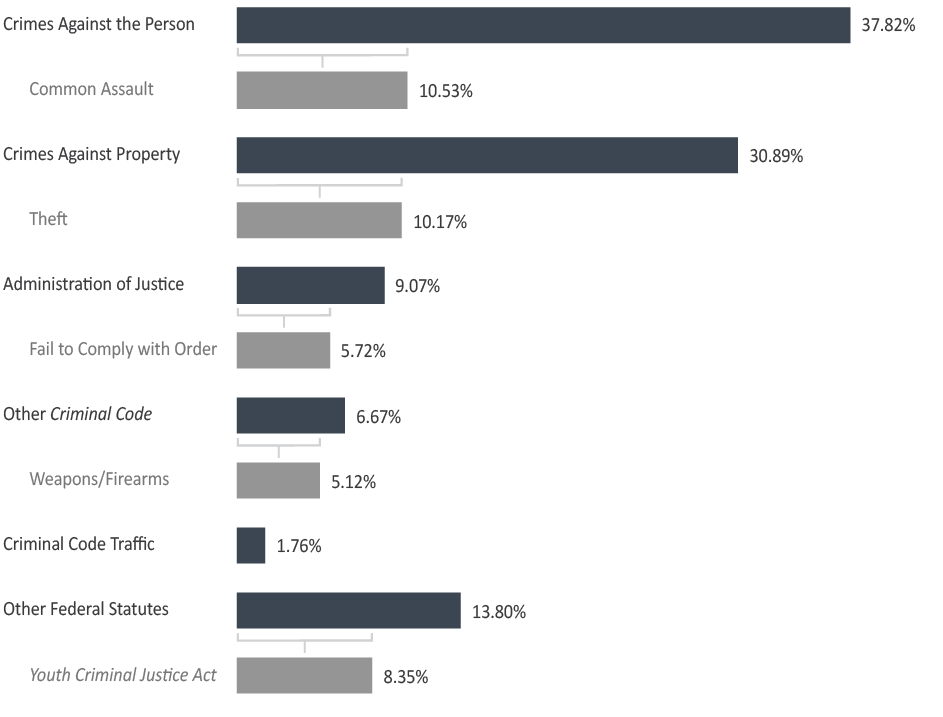
Source: Table 35-10-0038-01, Integrated Criminal Court Survey, Canadian Centre for Justice and Community Safety Statistics, Statistics Canada.
- Following the enactment of the Youth Criminal Justice Act in 2003, fewer youth appear in court.
- Common Assault was the most common case in youth court (10.5%), closely followed by theft (10.2%).
- Homicides and related offences account for 0.1% of all youth cases.
- Females account for 20% of all cases, but they account for 32% of common assaults.
Notes:
"Administration of Justice" includes the offences failure to appear, breach of probation, and unlawfully at large.
"Youth Criminal Justice Act offences" include failure to comply with a disposition or undertaking, contempt against youth court, assisting a youth to leave a place of custody and harbouring a youth unlawfully at large. Also included are similar offences under the Young Offenders Act, which preceded the Youth Criminal Justice Act.
"Drug Offences" includes possession and other drug offences.
The concept of a case has changed to more closely reflect court processing. Statistics from the Integrated Criminal Court Survey used in this report should not be compared to editions of the Corrections and Conditional Release Statistical Overview prior to 2007. A case is one or more charges against an accused person or corporation, processed by the courts at the same time, and where all of the charges in the case received a final disposition. Where a case has more than one charge, it is necessary to select a charge to represent the case. An offence is selected by applying two rules. First, the "most serious decision" rule is applied. In cases where two or more offences have the same decision, the "most serious offence" rule is applied. All charges are ranked according to an offence seriousness scale.
The Canadian Centre for Justice and Community Safety Statistics continues to make updates to the offence library used to classify offence data sent by the provinces and territories. These improvements have resulted in minor changes in the counts of charges and cases as well as the distributions by type of offence. Data presented have been revised to account for these updates.
Number of Youth Court Cases |
|||||
|---|---|---|---|---|---|
2013-14 |
2014-15 |
2015-16 |
2016-17 |
2017-18 |
|
Crimes Against the Person |
11,985 |
9,984 |
9,653 |
9,917 |
10,395 |
Homicide and Attempted Murder |
53 |
49 |
55 |
54 |
41 |
Robbery |
1,934 |
1,481 |
1,475 |
1,516 |
1,618 |
Sexual Assault/Other Sexual Offences |
1,453 |
1,330 |
1,442 |
1,536 |
1,658 |
Major Assault |
2,462 |
2,136 |
2,094 |
2,149 |
2,126 |
Common Assault |
3,664 |
2,796 |
2,586 |
2,641 |
2,894 |
Other Crimes Against the Person* |
2,419 |
2,192 |
2,001 |
2,021 |
2,058 |
Crimes Against Property |
13,668 |
11,016 |
10,652 |
9,627 |
8,490 |
Theft |
4,751 |
3,670 |
3,671 |
3,280 |
2,796 |
Break and Enter |
3,096 |
2,559 |
2,386 |
2,193 |
1,823 |
Fraud |
478 |
376 |
377 |
423 |
389 |
Mischief |
2,546 |
2,158 |
2,091 |
1,819 |
1,660 |
Possession of Stolen Property |
2,361 |
1,901 |
1,817 |
1,621 |
1,466 |
Other Crimes Against Property |
436 |
352 |
310 |
291 |
356 |
Administration of Justice |
4,352 |
3,630 |
3,394 |
3,113 |
2,492 |
Failure to Comply with Order |
2,900 |
2,390 |
2,209 |
2,067 |
1,573 |
Other Administration of Justice** |
1,452 |
1,240 |
1,185 |
1,046 |
919 |
Other Criminal Code |
2,232 |
2,086 |
1,946 |
1,888 |
1,833 |
Weapons/Firearms |
1,492 |
1,425 |
1,406 |
1,408 |
1,407 |
Prostitution |
11 |
15 |
7 |
14 |
3 |
Disturbing the Peace |
86 |
64 |
65 |
50 |
33 |
Residual Criminal Code |
643 |
582 |
468 |
416 |
390 |
Criminal Code Traffic |
657 |
566 |
569 |
554 |
483 |
Other Federal Statutes |
7,480 |
6,392 |
5,504 |
4,609 |
3,794 |
Drug Possession |
2,331 |
1,788 |
1,551 |
1,129 |
917 |
Other Drug Offences |
1,003 |
933 |
725 |
653 |
538 |
Youth Criminal Justice Act*** |
3,981 |
3,525 |
3,094 |
2,701 |
2,295 |
Residual Federal Statutes |
165 |
146 |
134 |
126 |
44 |
Total |
40,374 |
33,674 |
31,718 |
29,708 |
27,487 |
Source: Table 35-10-0038-01, Integrated Criminal Court Survey, Canadian Centre for Justice and Community Safety Statistics, Statistics Canada.
Notes:
*"Other Crimes Against the Person" includes the offences uttering threats and criminal harassment.
**"Other Administration of Justice" includes the offences failure to appear, breach of probation, and unlawfully at large.
***"Youth Criminal Justice Act offences" include failure to comply with a disposition or undertaking, contempt against youth court, assisting a youth to leave a place of custody and harbouring a youth unlawfully at large. Also included are similar offences under the Young Offenders Act, which preceded the Youth Criminal Justice Act.
The concept of a case has changed to more closely reflect court processing. Statistics from the Integrated Criminal Court Survey used in this report should not be compared to editions of the Corrections and Conditional Release Statistical Overview prior to 2007. A case is one or more charges against an accused person or corporation, processed by the courts at the same time, and where all of the charges in the case received a final disposition. Where a case has more than one charge, it is necessary to select a charge to represent the case. An offence is selected by applying two rules. First, the "most serious decision" rule is applied. In cases where two or more offences have the same decision, the "most serious offence" rule is applied. All charges are ranked according to an offence seriousness scale. The Canadian Centre for Justice and Community Safety Statistics continues to make updates to the offence library used to classify offence data sent by the provinces and territories. These improvements have resulted in minor changes in the counts of charges and cases as well as the distributions by type of offence. Data presented have been revised to account for these updates.
The most common sentence for youth is probation
Figure A11
Percentage of youth court sentence
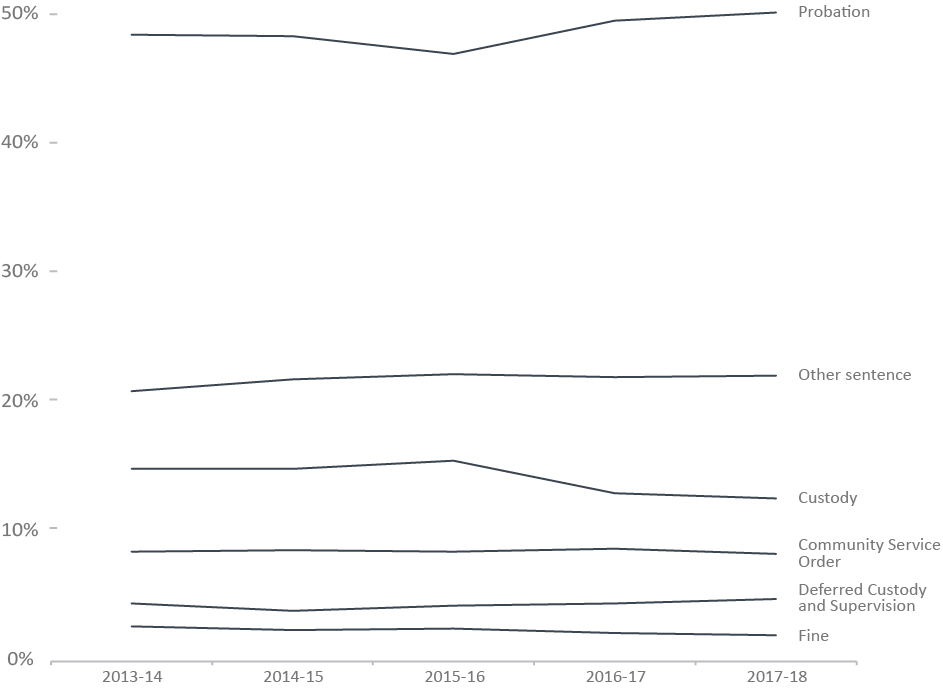
Source: Table 35-10-0041-01, Integrated Criminal Court Survey, Canadian Centre for Justice and Community Safety Statistics, Statistics Canada.
- Consistent with the objectives of the Youth Criminal Justice Act, fewer youth are sentenced to custody. In 2017-18, 12.6% of all guilty cases resulted in the youth being sentenced to custody.
- In 2017-18, 50.2% of youth found guilty were given probation as the most serious sentence. This rate has remained relatively stable since the implementation of the Youth Criminal Justice Act in April 2003.
- Of the new Youth Criminal Justice Act sentences, deferred custody and supervision orders were handed down least frequently. In 2017-18, 4.8% of all guilty cases received such an order as the most serious sentence.
Notes:
"Other Sentence" includes absolute discharge, restitution, prohibition, seizure, forfeiture, compensation, pay purchaser, essays, apologies, counselling programs and conditional discharge, conditional sentence, intensive support and supervision, attendance at non-residential program(s) and reprimand. This category also includes intensive support and supervision, attendance at non-residential program(s) and reprimand where sentencing data under the Youth Criminal Justice Act are not available.
Unlike previous years, this data represents the most serious sentence and therefore, sanctions are mutually exclusive. However, each case may receive more than one sentence.
The concept of a case has changed to more closely reflect court processing. Statistics from the Integrated Criminal Court Survey used in this report should not be compared to editions of the Corrections and Conditional Release Statistical Overview prior to 2007.
Type of Sentence |
Gender |
Year |
||||
|---|---|---|---|---|---|---|
2013-14 |
2014-15 |
2015-16 |
2016-17 |
2017-18 |
||
% |
% |
% |
% |
% |
||
Probation |
Female |
49.2 |
47.6 |
47 |
50.1 |
47.7 |
Male |
48.4 |
48.6 |
47.5 |
50.4 |
50.9 |
|
Total |
48.5 |
48.4 |
47 |
49.6 |
50.2 |
|
Custody |
Female |
10.8 |
11.7 |
11.9 |
7.5 |
8.8 |
Male |
16.3 |
15.9 |
16.5 |
13.6 |
13.4 |
|
Total |
14.9 |
14.9 |
15.5 |
13 |
12.6 |
|
Community Service Order |
Female |
9.1 |
9.5 |
8.5 |
9.2 |
9.2 |
Male |
7.9 |
8.4 |
7.9 |
8.1 |
7.3 |
|
Total |
8.5 |
8.6 |
8.5 |
8.7 |
8.3 |
|
Fine |
Female |
2.3 |
2.5 |
2.6 |
2.2 |
2 |
Male |
2.8 |
2.4 |
2.5 |
2.1 |
2 |
|
Total |
2.7 |
2.4 |
2.5 |
2.2 |
2 |
|
Deferred Custody and Supervision |
Female |
4.1 |
3.1 |
3.7 |
3.3 |
3.4 |
Male |
4.7 |
4.2 |
4.5 |
4.8 |
5.3 |
|
Total |
4.5 |
3.9 |
4.3 |
4.5 |
4.8 |
|
Other Sentence |
Female |
24.5 |
25.6 |
26.3 |
27.7 |
28.9 |
Male |
19.9 |
20.5 |
21.1 |
21 |
21.1 |
|
Total |
20.9 |
21.8 |
22.2 |
22 |
22.1 |
|
Source: Table 35-10-0041-01, Integrated Criminal Court Survey, Canadian Centre for Justice and Community Safety Statistics, Statistics Canada.
Notes:
"Other Sentence" includes absolute discharge, restitution, prohibition, seizure, forfeiture, compensation, pay purchaser, essays, apologies, counselling programs and conditional discharge, conditional sentence, intensive support and supervision, attendance at non-residential program(s) and reprimand. This category also includes intensive support and supervision, attendance at non-residential program(s) and reprimand where sentencing data under the Youth Criminal Justice Act are not available.
Unlike previous years, this data represents the most serious sentence and therefore, sanctions are mutually exclusive. However, each case may receive more than one sentence.
The concept of a case has changed to more closely reflect court processing. Statistics from the Integrated Criminal Court Survey used in this report should not be compared to editions of the Corrections and Conditional Release Statistical Overview prior to 2007.
Section B. Corrections Administration
Expenditures on corrections has increased
Figure B1
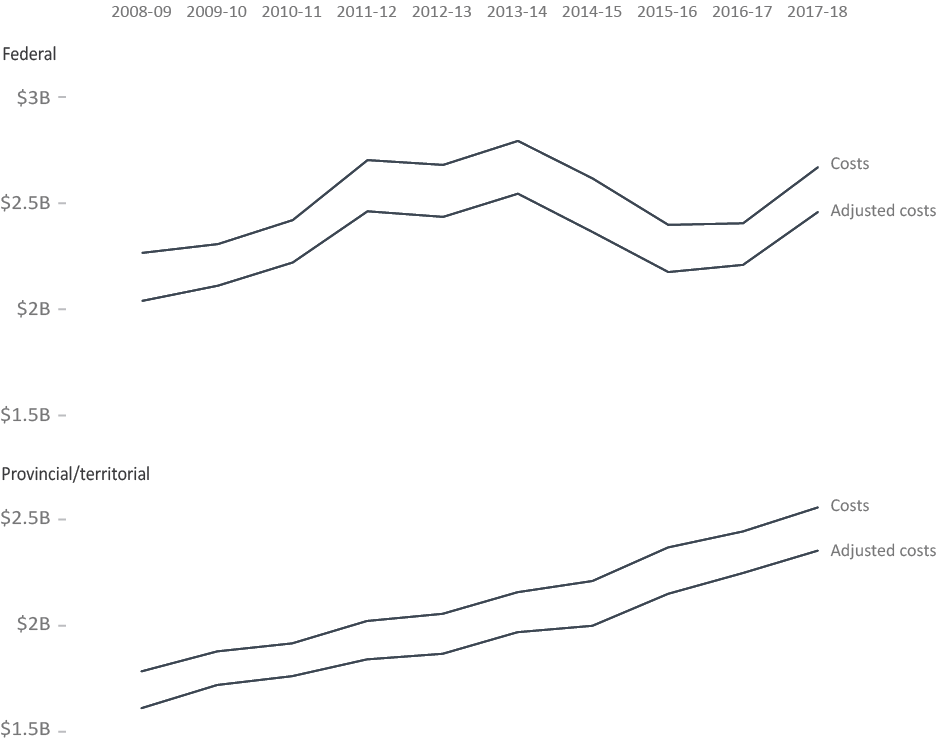
Sources: Correctional Service Canada; Parole Board of Canada; Office of the Correctional Investigator; Statistics Canada Consumer Price Index. Provincial figures derived from Table 35-10-0013-01, the Adult Correctional Services Survey, Canadian Centre for Justice and Community Safety Statistics, Statistics Canada.
- In 2017-18, expenditures on federal corrections in Canada totaled approximately $2.68 billion, an 11.0% increase from 2016-17.
- Provincial/territorial expenditures totaled about $2.55 billion in 2017-18, an increase of 4.6% from 2016-17.
- Since 2008-09, expenditures on federal corrections have increased by 17.8%, from $2.27 billion to $2.68 billion. In constant dollars, this represents an increase of 20.4%.
- Over the same time period, provincial/territorial expenditures increased by 43.4% from $1.78 billion to $2.55 billion. In constant dollars, this represents an increase of 46.5%.
Notes:
Adjusted costs are reported in constant dollars. Constant dollars (2002) represent dollar amounts calculated on a one-year base that adjusts for inflation, allowing the yearly amounts to be directly comparable. Changes in the Consumer Price Index were used to calculate constant dollars.
Federal expenditures on corrections include spending by Correctional Service Canada (CSC), the Parole Board of Canada (PBC), and the Office of the Correctional Investigator (OCI). Total expenditures represent gross expenditures and exclude revenues. Operating costs include Employee Benefit Plan expenditures. CSC expenditures exclude CORCAN (a Special Operating Agency that conducts industrial operations within penitentiaries). Provincial/Territorial expenditures do not include capital costs.
Year |
Current Dollars |
Constant 2002 Dollars |
||||||
|---|---|---|---|---|---|---|---|---|
Operating |
Capital |
Total |
Per capita |
Operating |
Capital |
Total |
Per capita |
|
$'000 |
$ |
$'000 |
$ |
|||||
2013-14 |
||||||||
CSC |
2,371,700 |
378,372 |
2,750,072 |
78.22 |
2,161,429 |
344,826 |
2,506,256 |
70.48 |
PBC |
50,400 |
- - |
50,400 |
1.43 |
45,932 |
- - |
45,932 |
1.29 |
OCI |
4,946 |
- - |
4,946 |
0.14 |
4,507 |
- - |
4,507 |
0.13 |
Total |
2,427,046 |
378,372 |
2,805,418 |
79.79 |
2,211,869 |
344,826 |
2,556,695 |
71.90 |
2014-15 |
||||||||
CSC |
2,373,604 |
200,606 |
2,574,210 |
72.42 |
2,144,868 |
181,274 |
2,326,142 |
64.93 |
PBC |
50,100 |
- - |
50,100 |
1.41 |
45,272 |
- - |
45,272 |
1.26 |
OCI |
4,659 |
- - |
4,659 |
0.13 |
4,210 |
- - |
4,210 |
0.12 |
Total |
2,428,363 |
200,606 |
2,628,969 |
73.96 |
2,194,350 |
181,274 |
2,375,624 |
66.32 |
2015-16 |
||||||||
CSC |
2,189,101 |
168,684 |
2,357,785 |
65.77 |
1,986,217 |
153,051 |
2,139,268 |
59.00 |
PBC |
46,300 |
- - |
46,300 |
1.29 |
42,009 |
- - |
42,009 |
1.16 |
OCI |
4,656 |
- - |
4,656 |
0.13 |
4,224 |
- - |
4,224 |
0.12 |
Total |
2,240,057 |
168,684 |
2,408,741 |
67.19 |
2,032,450 |
153,051 |
2,185,501 |
60.28 |
2016-17 |
||||||||
CSC |
2,209,048 |
153,757 |
2,362,804 |
65.12 |
2,031,172 |
141,376 |
2,172,548 |
59.17 |
PBC |
46,800 |
- - |
46,800 |
1.29 |
43,032 |
- - |
43,032 |
1.17 |
OCI |
4,693 |
- - |
4,693 |
0.13 |
4,315 |
- - |
4,315 |
0.12 |
Total |
2,260,541 |
153,757 |
2,414,297 |
66.53 |
2,078,519 |
141,376 |
2,219,894 |
60.46 |
2017-18 |
||||||||
CSC |
2,442,488 |
185,624 |
2,628,112 |
70.57 |
2,248,407 |
170,874 |
2,419,282 |
64.97 |
PBC |
47,700 |
- - | 47,700 |
1.28 |
43,910 |
- - | 43,910 |
1.18 |
OCI |
4,631 |
- - | 4,631 |
0.12 |
4,263 |
0 |
4,263 |
0.11 |
Total |
2,494,819 |
185,624 |
2,680,443 |
71.98 |
2,296,580 |
170,874 |
2,467,454 |
66.26 |
Sources: Correctional Service Canada; Parole Board of Canada; Office of the Correctional Investigator; Statistics Canada Consumer Price Index.
Notes:
Due to rounding, constant dollar amounts may not add up to "Total".
Per capita cost is calculated by dividing the total expenditures by the total Canadian population and thus represents the cost per Canadian for federal correctional services.
Constant dollars represent dollar amounts calculated on a one-year base (2002) that adjusts for inflation allowing the yearly amounts to be directly comparable. Changes in the Consumer Price Index were used to calculate constant dollars.
CSC employees are concentrated in custody centres
Figure B2
At the end of fiscal year (2018-19)

Source: Correctional Service of Canada.
- The Correctional Service of Canada (CSC) has a total staff of 17,101.
- Approximately 77% of CSC staff work in institutions.
- Staff employed in community supervision account for 9% of the total.
Notes:
CSC has changed its definition of employee. Previously the total number of employees included casual employees, employees on leave without pay and suspended employees. These categories have been removed from the total as of 2005-06. These numbers represent indeterminate and term equal to, or more than 3 months of substantive employment; and employee status of active and paid leave current up to March 31, 2019.
Due to rounding, the percentage may not add to 100.
Service Area |
March 31, 2009 |
March 31, 2019 |
||
|---|---|---|---|---|
# |
% |
# |
% |
|
Headquarters and Central Services |
2,609 |
15.8 |
2,522 |
14.7 |
Administration |
2,198 |
13.3 |
2,169 |
12.7 |
Health Care |
111 |
0.7 |
78 |
0.5 |
Program Staff |
108 |
0.7 |
61 |
0.4 |
Correctional Officers |
44 |
0.3 |
37 |
0.2 |
Instructors/Supervisors |
17 |
0.1 |
9 |
0.1 |
Parole Officers/Parole Supervisors |
2 |
0 |
1 |
0 |
Other** |
129 |
0.8 |
167 |
1 |
Custody Centres |
12,590 |
76.1 |
13,122 |
76.7 |
Correctional Officers |
6,382 |
38.6 |
7,262 |
42.5 |
Administration |
2,126 |
12.9 |
1,785 |
10.4 |
Health Care |
988 |
6 |
938 |
5.5 |
Program Staff |
839 |
5.1 |
883 |
5.2 |
Parole Officers/Parole Supervisors* |
727 |
4.4 |
611 |
3.6 |
Instructors/Supervisors |
444 |
2.7 |
401 |
2.3 |
Other** |
1,084 |
6.6 |
1,242 |
7.3 |
Community Supervision |
1,337 |
8.1 |
1,457 |
8.5 |
Parole Officers/Parole Supervisors |
714 |
4.3 |
763 |
4.5 |
Administration |
336 |
2 |
368 |
2.2 |
Program Staff |
198 |
1.2 |
244 |
1.4 |
Correctional Officers |
18 |
0.1 |
0 |
0 |
Health Care |
69 |
0.4 |
79 |
0.5 |
Other** |
2 |
0 |
3 |
0 |
Total*** |
16,536 |
100 |
17,101 |
100 |
Source: Correctional Service of Canada.
Notes:
Due to changes in policy, Correctional Officers no longer occupy positions in the community.
*These parole officers are situated within institutions, with the responsibility of preparing offenders for release.
**The "Other" category represents job classifications such as trades and food services.
***CSC has changed its definition of employee. Previously the total number of employees included casual employees, employees on leave without pay and suspended employees. These categories have been removed from the total as of 2005-06. These numbers represent indeterminate and term equal to, or more than 3 months of substantive employment; and employee status of active and paid leave current up to March 31, 2019.
Due to rounding, the percentage may not add to 100.
The cost of keeping an inmate incarcerated has increased
Figure B3
Federal average daily inmate cost (current $)
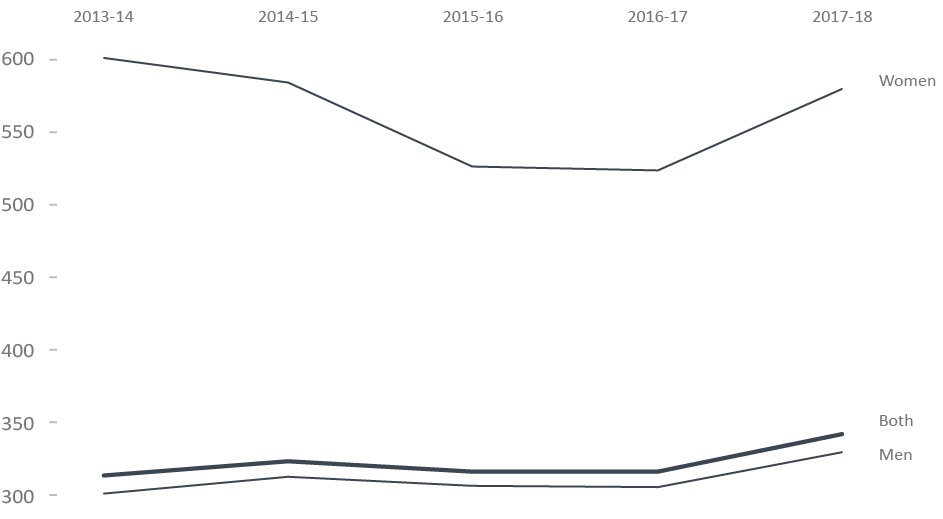
Source: Correctional Service of Canada.
- The federal average daily inmate cost has increased from $316 in 2013-14 to $344 in 2017-18. In 2017-18, the annual average cost of keeping an inmate incarcerated was $125,466 per year, an increase from $115,310 per year in 2013-14. In 2017-18, the annual average cost of keeping a man incarcerated was $121,339 per year, whereas the annual average cost for incarcerating a woman was $212,005.
- The cost associated with maintaining an offender in the community is 74% less than what it costs to maintain an offender in custody ($32,327 per year versus $125,466 per year).
Notes:
The average daily inmate cost includes those costs associated with the operation of the institutions such as salaries and employee benefit plan contributions, but excludes capital expenditures and expenditures related to CORCAN (a Special Operating Agency that conducts industrial operations within federal institutions).
Total incarcerated and community includes additional NHQ & RHQ administrative costs which are not part of the Institutional and/or Community calculations. Offenders in the Community includes: Offenders on conditional release, statutory release or with Long-Term Supervision Order, under CSC supervision.
Figures may not add due to rounding.
Categories |
Annual Average Cost per Offender (current $) |
||||
|---|---|---|---|---|---|
2013-14 |
2014-15 |
2015-16 |
2016-17 |
2017-18 |
|
Incarcerated Offenders |
|||||
Maximum Security (men only) |
156,768 |
160,094 |
155,848 |
158,113 |
169,367 |
Medium Security (men only) |
101,583 |
105,750 |
106,868 |
105,349 |
115,263 |
Minimum Security (men only) |
83,182 |
86,613 |
81,528 |
83,450 |
86,603 |
Women's Facilities |
219,884 |
213,800 |
192,742 |
191,843 |
212,005 |
*Exchange of Services Agreements (both) |
108,388 |
111,839 |
114,974 |
122,998 |
114,188 |
Incarcerated Average |
115,310 |
119,152 |
116,364 |
116,473 |
125,466 |
Offenders in the Community |
34,432 |
33,067 |
31,052 |
30,639 |
32,327 |
Total Incarcerated and Community |
99,923 |
99,982 |
94,545 |
95,654 |
100,425 |
Source: Correctional Service of Canada.
Notes:
*The intent of an Exchange of Service Agreement is to detail the roles and responsibilities of each jurisdiction and include specific protocols regarding per diem rates, offender information sharing, and invoicing pertaining to the reciprocal exchange of offenders between jurisdictions.
The average daily inmate cost includes those costs associated with the operation of the institutions such as salaries and employee benefit plan contributions, but excludes capital expenditures and expenditures related to CORCAN (a Special Operating Agency that conducts industrial operations within federal institutions).
Total incarcerated and community includes additional NHQ & RHQ administrative costs which are not part of the Institutional and/or Community calculations. Offenders in the Community includes: Offenders on conditional release, statutory release or with Long-Term Supervision Order, under CSC supervision.
Figures may not add due to rounding.
The number of Parole Board of Canada employees
Figure B4
Full-time equivalents – 10-year trend
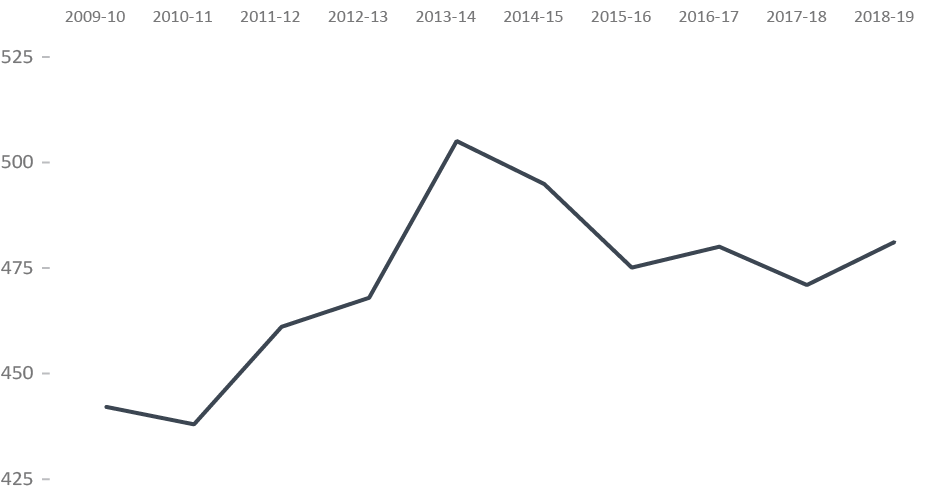
Source: Parole Board of Canada.
- The higher number of full-time equivalents used by the Parole Board of Canada in 2013-14 and 2014-15 were related to temporary human resources hired to work on clearing the Pardons backlog which accumulated prior to the user fee increase.
Note:
A full-time equivalent is a measure of the extent to which an employee represents a full person-year charge against a departmental budget. Section 103 of the Corrections and Conditional Release Act limits the Parole Board of Canada to 60 full-time members.
Full Time Equivalents |
|||||
|---|---|---|---|---|---|
2014-15 |
2015-16 |
2016-17 |
2017-18 |
2018-19 |
|
Program Activity |
|||||
Conditional Release Decisions |
325 |
322 |
321 |
317 |
316 |
Conditional Release Openness and Accountability |
54 |
42 |
44 |
42 |
43 |
Record Suspension and Clemency Recommendations |
69 |
52 |
59 |
48 |
58 |
Internal Services |
47 |
59 |
56 |
64 |
64 |
Total |
495 |
475 |
480 |
471 |
481 |
Types of Employees |
|||||
Full-time Board Members |
42 |
41 |
39 |
38 |
41 |
Part-time Board Members |
18 |
18 |
17 |
20 |
19 |
Staff |
435 |
416 |
424 |
413 |
421 |
Total |
495 |
475 |
480 |
471 |
481 |
Source: Parole Board of Canada.
Note:
A full-time equivalent is a measure of the extent to which an employee represents a full person-year charge against a departmental budget. Section 103 of the Corrections and Conditional Release Act limits the Parole Board of Canada to 60 full-time members.
The number of employees in the Office of the Correctional Investigator
Figure B5
Full-time equivalents

Source: Office of the Correctional Investigator.
- In 2018-19, the total number of full-time equivalents at the Office of the Correctional Investigator increased by 3 (1 in Senior Management and Investigative Services, 2 in Internal Services) from 36 (2017-18) to 39 employees total.
Notes:
The Office of the Correctional Investigator (OCI) may commence an investigation on receipt of a complaint by or on behalf of an offender or on its own initiative. Complaints are made by telephone, letter and during interviews with the OCI's investigative staff at federal correctional facilities. The dispositions in response to complaints involve a combination of internal responses (where the information or assistance sought by the offender can generally be provided by the OCI's investigative staff) and investigations (where, further to a review/analysis of law, policies and documentation, OCI investigative staff make an inquiry or several interventions with Correctional Service Canada and submit recommendations to address the complaint). Investigations vary considerably in terms of scope, complexity, duration and resources required.
Full Time Equivalents |
|||||
|---|---|---|---|---|---|
2014-15 |
2015-16 |
2016-17 |
2017-18 |
2018-19 |
|
Types of Employees |
|||||
Correctional Investigator |
1 |
1 |
1 |
1 |
1 |
Senior Management and Investigative Services |
23 |
26 |
26 |
26 |
29 |
Internal Services |
4 |
4 |
4 |
4 |
4 |
Legal Counsel, Policy and Research |
4 |
5 |
5 |
5 |
5 |
Total |
32 |
36 |
36 |
36 |
39 |
Source: Office of the Correctional Investigator.
Health care is the most common area of offender complaint received by the Office of the Correctional Investigator
Figure B6
Ten most common complaints in 2018-19
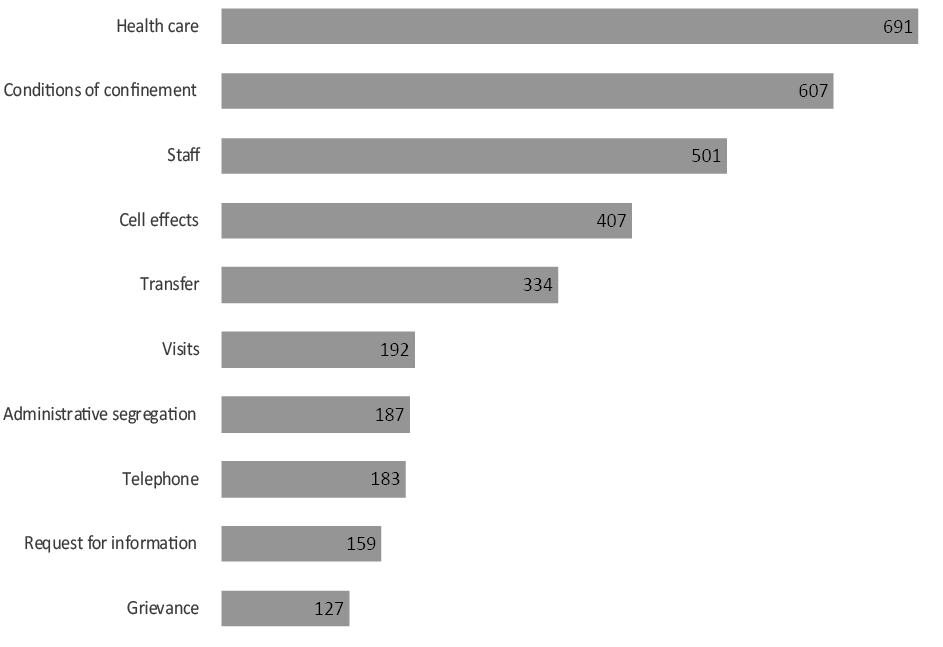
Source: Office of the Correctional Investigator.
- There were 5,113 complaints/enquiries received at the Office of the Correctional Investigator (OCI) in 2018-19.
- Health care (13.5%), conditions of confinement (11.9%), staff (9.8%), and cell effects (8.0%), accounted for 43.2% of all complaints.
Notes:
The values for 2018-19 are accurate at the time of reporting, but may change in subsequent reports as some pending cases are processed in the following fiscal year.
The Office of the Correctional Investigator (OCI) may commence an investigation on receipt of a complaint by or on behalf of an offender or on its own initiative. Complaints are made by telephone, letter and during interviews with the OCI's investigative staff at federal correctional facilities. The dispositions in response to complaints involve a combination of internal responses (where the information or assistance sought by the offender can generally be provided by the OCI's investigative staff) and investigations (where, further to a review/analysis of law, policies and documentation, OCI investigative staff make an inquiry or several interventions with Correctional Service Canada and submit recommendations to address the complaint). Investigations vary considerably in terms of scope, complexity, duration and resources required.
Number of Complaints |
|||||
|---|---|---|---|---|---|
Category of Complaint* |
2014-15 |
2015-16 |
2016-17 |
2017-18 |
2018-19 |
Health Care |
816 |
911 |
903 |
838 |
691 |
Conditions of Confinement |
616 |
808 |
761 |
770 |
607 |
Staff |
422 |
429 |
408 |
530 |
501 |
Cell Effects |
360 |
426 |
497 |
412 |
407 |
Transfer |
474 |
370 |
439 |
353 |
334 |
Administrative Segregation |
383 |
272 |
269 |
223 |
187 |
Visits |
244 |
290 |
285 |
214 |
192 |
Outside OCI Jurisdiction |
238 |
245 |
259 |
193 |
128 |
Telephone |
278 |
224 |
187 |
169 |
183 |
Grievance |
195 |
188 |
173 |
177 |
127 |
Safety/Security of Offender(s) |
143 |
197 |
208 |
127 |
177 |
Request for Information |
181 |
152 |
213 |
126 |
159 |
Financial Matters |
180 |
199 |
170 |
107 |
111 |
Programs |
123 |
161 |
202 |
138 |
112 |
Correspondence |
149 |
165 |
167 |
149 |
84 |
Security Classification |
145 |
143 |
135 |
129 |
102 |
Case Preparation |
137 |
102 |
115 |
55 |
73 |
Mental Health |
77 |
133 |
122 |
76 |
59 |
Temporary Absence |
98 |
100 |
93 |
74 |
65 |
Employment |
70 |
90 |
112 |
100 |
54 |
Total of all categories** |
6,382 |
6,651 |
6,844 |
5,846 |
5,113 |
Source: Office of the Correctional Investigator.
Notes:
*These top categories of complaints are based on the sum totals for the five reported fiscal years between 2014-15 and 2018-19. The values for 2018-19 are accurate at the time of reporting, but may change in subsequent reports as some pending cases are processed in the following fiscal year.
**These totals represent all complaint categories.
Due to ongoing efforts at the OCI (Office of the Correctional Investigator) to streamline our administrative database and ensure accuracy in reporting, the numbers in this table will not always match those of past Corrections and Conditional Release Statistical Overviews, or OCI Annual Reports.
Excludes the 128 complaints received on issues outside the OCIs jurisdiction.
Section C. Offender Population
Offenders under the responsibility of CSC
Figure C1
Total offender population (2018-19)*
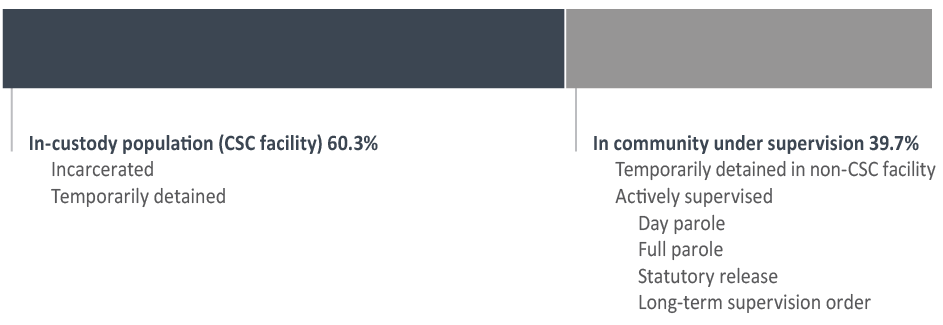
Source: Correctional Service of Canada.
Definitions:
Total Offender Population includes all active offenders, who are incarcerated in a CSC facility, offenders on temporary absence from a CSC facility, offenders who are temporarily detained, offenders who are actively supervised, and offenders who are unlawfully at large for less than 90 days.
In addition to the total offender population, there are excluded groups such as:
Federal jurisdiction offenders incarcerated in a Community Correctional Centre or in a non-CSC facility. Federal jurisdiction offenders deported /extradited including offenders for whom a deportation order has been enforced by Canada Border Services Agency. Federal offenders on bail which includes offenders on a judicial interim release; they have appealed their conviction or sentence and have been released to await the results of a new trial. Escaped includes offenders who have absconded from either a correctional facility or while on a temporary absence and whose whereabouts are unknown. Unlawfully at Large for 90 days or more. This includes offenders who have been released to the community on day parole, full parole, statutory release or a long-term supervision order for whom a warrant for suspension has been issued at least 90 days ago, but has not yet been executed.
CSC Facilities include all federal institutions and federally funded Healing Lodges.
Total Offender Population
In Custody includes all active offenders incarcerated in a CSC facility, offenders on temporary absence from a CSC facility, offenders who are temporarily detained in a CSC facility and offenders on remand in a CSC facility.
In Community Under Supervision includes all active offenders on day parole, full parole, statutory release, in the community supervised on a long-term supervision order, offenders who are temporarily detained in a non-CSC facility, offenders who are unlawfully at large for less than 90 days, offenders on remand in a non-CSC facility, and offenders supervised and subject to an immigration hold by Canada Border Services Agency.
Actively Supervised includes all active offenders on day parole, full parole or statutory release, as well as those who are in the community on long-term supervision orders.
Temporarily Detained includes offenders who are physically held in a CSC facility or a non-CSC facility after being suspended for a breach of a parole condition or to prevent a breach of parole conditions.
Note:
*The definition of "offender population" changed from previous editions of the Corrections and Conditional Release Statistical Overview (CCRSO). As such, comparisons to editions of the CCRSO prior to 2016 should be done with caution.
Status |
Offenders under the responsibility of CSC (2018-19) |
|
|---|---|---|
# |
% |
|
In-Custody Population (CSC Facility) |
14,149 |
60.3 |
Incarcerated in CSC Facility |
13,363 |
57.0 |
Temporarily Detained in CSC Facility |
786 |
3.3 |
In Community under Supervision |
9,315 |
39.7 |
Temporarily Detained in Non-CSC Facility |
159 |
0.7 |
Actively Supervised |
9,156 |
39.0 |
Day Parole |
1,666 |
7.1 |
Full Parole |
4,408 |
18.8 |
Statutory Release |
2,648 |
11.3 |
Long-Term Supervision Order |
434 |
1.8 |
Total |
23,464* |
100.0 |
Source: Correctional Service of Canada.
Note:
*In addition to this total offender population, 289 offenders were on bail, 123 offenders had escaped, 201 offenders serving a federal sentence were in custody in a non-CSC facility, 325 offenders were unlawfully at large for 90 days or more, and 416 offenders were deported. The definition of "Offender Population" changed from previous editions of the Corrections and Conditional Release Statistical Overview (CCRSO). As such, comparisons to editions of the CCRSO prior to 2016 should be done with caution.
The number of offenders in custody
Figure C2 (A)
Number of in-custody offenders in a CSC facility at fiscal year* end

Source: Correctional Service of Canada
Figure C2 (B)
Number of in-custody offenders in a provincial/territorial facility
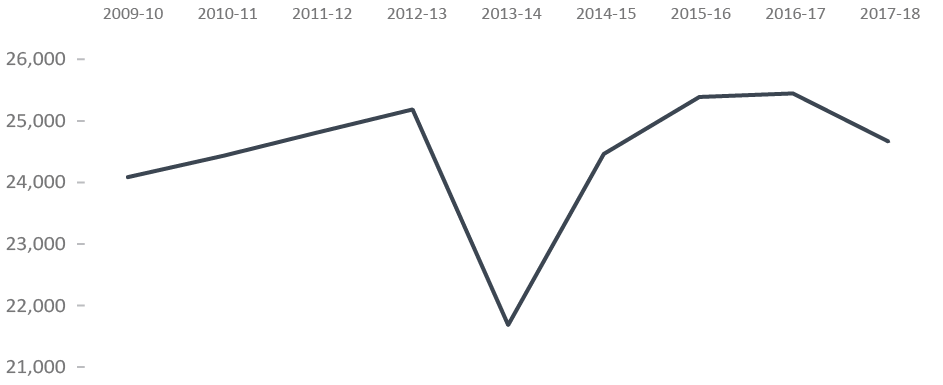
Source: Table: 35-10-0154-01, Corrections Key Indicator Report for Adults and Youth, Canadian Centre for Justice and Community Safety Statistics, Statistics Canada.
- The number of offenders in custody in a CSC facility has slightly increased. From 2009-10 to 2013-14, the in-custody population increased consistently but started to decline in 2014-15. There was a 0.4% increase in 2018-19.
- The number of offenders in provincial/territorial custody has slightly decreased. From 2014-15 to 2017-18, the average provincial/territorial in-custody offender population has increased slightly (0.8%), from 24,455 to 24,658. The remand population increased by 13.0%, from 13,650 to 15,417 during this period.
Notes:
*The data reflect the number of offenders in custody at the end of each fiscal year. A fiscal year runs from April 1 to March 31 of the following year.
The term "In Custody in a CSC Facility" includes all active offenders incarcerated in a CSC facility, offenders on temporary absence from a CSC facility, offenders who are temporarily detained in a CSC facility and offenders on remand in a CSC facility.
Year |
In Custody Offenders |
Total |
|||||
|---|---|---|---|---|---|---|---|
In-Custody in a CSC Facility*1 |
Provincial/Territorial2 |
||||||
Sentenced |
Remand |
Other/Temporary Detention |
Total |
||||
2009-10 |
14,197 |
10,045 |
13,739 |
308 |
24,092 |
38,289 |
|
2010-11 |
14,840 |
10,922 |
13,086 |
427 |
24,435 |
39,275 |
|
2011-12 |
15,131 |
11,138 |
13,369 |
308 |
24,814 |
39,945 |
|
2012-13 |
15,318 |
11,138 |
13,739 |
308 |
25,185 |
40,503 |
|
2013-14 |
15,342 |
9,888 |
11,494 |
322 |
21,704 |
37,046 |
|
2014-15 |
14,886 |
10,364 |
13,650 |
441 |
24,455 |
39,341 |
|
2015-16 |
14,712 |
10,091 |
14,899 |
415 |
25,405 |
40,117 |
|
2016-17 |
14,159 |
9,710 |
15,417 |
321 |
25,448 |
39,607 |
|
2017-18 |
14,092 |
9,543 |
15,417 |
303 |
24,658 |
38,750 |
|
2018-19 |
14,149 |
-- |
-- |
-- |
-- |
-- |
|
Sources: 1Correctional Service of Canada; 2Table 35-10-0154-01, Corrections Key Indicator Report for Adults and Youth, Canadian Centre for Justice and Community Safety Statistics.
Notes:
*The term "In Custody in a CSC Facility" includes all active offenders incarcerated in a CSC facility, offenders on temporary absence from a CSC facility, offenders who are temporarily detained in a CSC facility and offenders on remand in a CSC facility.
The figures for provincial and territorial offenders reflect annual average counts.
-- data not available.
The number of admissions to federal jurisdiction is decreasing
Figure C3
Number of admissions
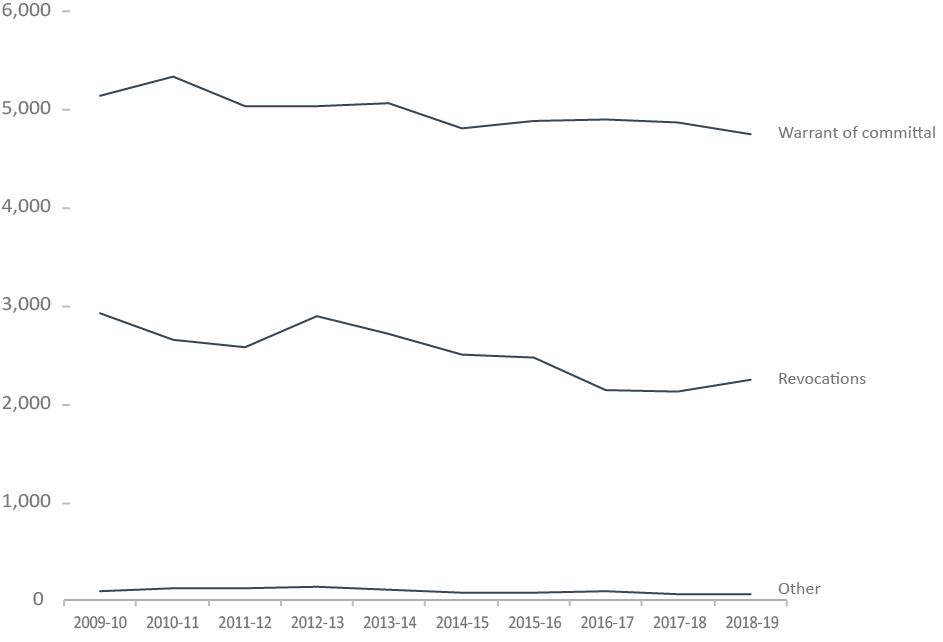
Source: Correctional Service Canada.
- After peaking at 8,155 in 2009-10, the number of admissions has decreased by 13.3% to 7,067 in 2018-19.
- The number of warrant of committal admissions has fluctuated over the past decade but has declined by 11.0% compared to the highest point which occurred in fiscal year 2010-11.
- The number of women admitted to federal jurisdiction under warrants of committal increased 4.1% from 343 in 2014-15 to 357 in 2018-19.
Notes:
"Other" includes transfers from other jurisdictions (exchange of services), terminations, transfers from foreign countries, and admissions where a release is interrupted as a consequence of a new conviction.
"Revocation" is when the Parole Board of Canada makes a decision to reincarcerate an offender who was on conditional release, prior to the end of their sentence.
"Warrant of Committal" is a new admission to federal jurisdiction from the courts.
These numbers refer to the total number of admissions to a federal institution or Healing Lodge during each fiscal year and may be greater than the actual number of offenders admitted, since an individual offender may be admitted more than once in a given year. A fiscal year runs from April 1 to March 31 of the following year.
There is a lag in the data entry of admissions into CSC's Offender Management System. The admission figures for the most recent year are under-reported by 200-400 at the time of our year end extraction. More accurate figures will be available in the next year's publication. Please use caution when including the most recent year in any trend analysis.
2014-15 |
2015-16 |
2016-17 |
2017-18 |
2018-19 |
||||||||||||
|---|---|---|---|---|---|---|---|---|---|---|---|---|---|---|---|---|
Women |
Men |
Women |
Men |
Women |
Men |
Women |
Men |
Women |
Men |
|||||||
Warrant of Committal |
||||||||||||||||
1st Federal Sentence |
302 |
3,308 |
348 |
3,321 |
377 |
3,355 |
326 |
3,278 |
322 |
3,287 |
||||||
2nd or Subsequent Federal Sentence |
41 |
1,153 |
39 |
1,174 |
36 |
1,130 |
43 |
1,214 |
35 |
1,102 |
||||||
Provincial Sentence |
0 |
13 |
1 |
7 |
1 |
8 |
1 |
10 |
0 |
3 |
||||||
Subtotal |
343 |
4,474 |
388 |
4,502 |
414 |
4,493 |
370 |
4,502 |
357 |
4,392 |
||||||
Total |
4,817 |
4,890 |
4,907 |
4,872 |
4,749 |
|||||||||||
Revocations |
123 |
2,380 |
149 |
2,327 |
132 |
2,014 |
149 |
1,981 |
147 |
2,103 |
||||||
Total |
2,503 |
2,476 |
2,146 |
2,130 |
2,250 |
|||||||||||
Other* |
5 |
71 |
4 |
78 |
3 |
95 |
8 |
53 |
5 |
63 |
||||||
Total |
76 |
82 |
98 |
61 |
68 |
|||||||||||
Total Admissions |
471 |
6,925 |
541 |
6,907 |
549 |
6,602 |
527 |
6,536 |
509 |
6,558 |
||||||
7,396 |
7,448 |
7,151 |
7,063 |
7,067 |
||||||||||||
Source: Correctional Service of Canada.
Notes:
*"Other" includes transfers from other jurisdictions (exchange of services), terminations, transfers from foreign countries, and admissions where a release is interrupted as a consequence of a new conviction.
"Revocation" is when the Parole Board of Canada makes a decision to reincarcerate an offender who was on conditional release, prior to the end of their sentence.
"Warrant of Committal" is a new admission to federal jurisdiction from the courts.
These numbers refer to the total number of admissions to a federal institution or Healing Lodge during each fiscal year and may be greater than the actual number of offenders admitted, since an individual offender may be admitted more than once in a given year. A fiscal year runs from April 1 to March 31 of the following year.
There is a lag in the data entry of admissions into CSC's Offender Management System. The admission figures for the most recent year are under-reported by 200-400 at the time of our year end extraction. More accurate figures will be available in the next year's publication. Please use caution when including the most recent year in any trend analysis.
Over the last ten years, the number of women admitted from the courts to federal jurisdiction has increased
Figure C4
Number of warrant of committal admissions for women
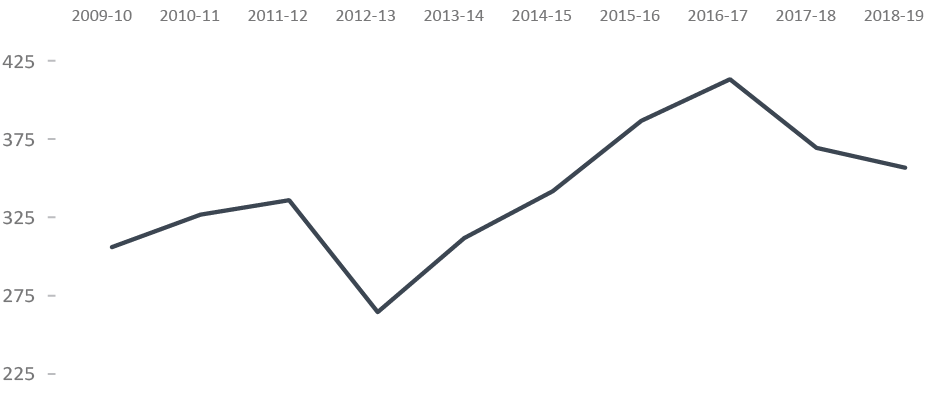
Source: Correctional Service Canada.
- In the last ten years, the number of women admitted to federal jurisdiction on a warrant of committal increased 16.3% from 307 in 2009-10 to 357 in 2018-19. During the same time period, there was a decrease in the number of men admitted to federal jurisdiction on a warrant of committal from 4,833 in 2009-10 to 4,392 in 2018-19.
- Overall, women continue to represent a small proportion of the total number of warrant of committal admissions (i.e., 7.5% in 2018-19).
- At the end of fiscal year 2018-19, there were 701 women in custody within Correctional Service Canada facilities.
Note:
A warrant of committal is a new admission to federal jurisdiction from the courts.
There is a lag in the data entry of admissions into CSC's Offender Management System. The admission figures for the most recent year are under-reported by 200-400 at the time of our year end extraction. More accurate figures will be available in the next year's publication. Please use caution when including the most recent year in any trend analysis.
Year |
Warrant of Committal Admissions |
Total |
||||||
|---|---|---|---|---|---|---|---|---|
Women |
Men |
|||||||
# |
% |
# |
% |
|||||
2009-10 |
307 |
6 |
4,833 |
94 |
5,140 |
|||
2010-11 |
328 |
6.2 |
5,005 |
93.8 |
5,333 |
|||
2011-12 |
337 |
6.7 |
4,694 |
93.3 |
5,031 |
|||
2012-13 |
265 |
5.3 |
4,778 |
94.7 |
5,043 |
|||
2013-14 |
312 |
6.2 |
4,759 |
93.8 |
5,071 |
|||
2014-15 |
343 |
7.1 |
4,474 |
92.9 |
4,817 |
|||
2015-16 |
388 |
7.9 |
4,502 |
92.1 |
4,890 |
|||
2016-17 |
414 |
8.4 |
4,493 |
91.6 |
4,907 |
|||
2017-18 |
370 |
7.6 |
4,502 |
92.4 |
4,872 |
|||
2018-19 |
357 |
7.5 |
4,392 |
92.5 |
4,749 |
|||
Source: Correctional Service Canada.
Note:
A warrant of committal is a new admission to federal jurisdiction from the courts.
There is a lag in the data entry of admissions into CSC's Offender Management System. The admission figures for the most recent year are under-reported by 200-400 at the time of our year end extraction. More accurate figures will be available in the next year's publication. Please use caution when including the most recent year in any trend analysis.
About half of the total offender population in CSC facilities is serving a sentence of less than five years
Figure C5
Sentence length of total offender population (2018-19)*
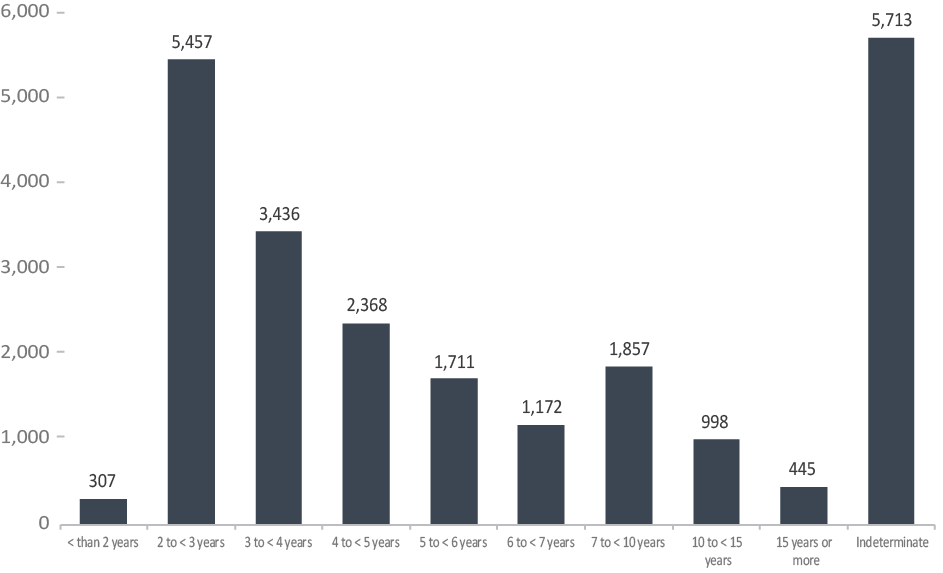
Source: Correctional Service Canada.
- In 2018-19, almost half (49.3%) of the total offender population was serving a sentence of less than 5 years with 23.3% serving a sentence between two years and less than three years.
- Almost one quarter (24.3%) of the total offender population was serving an indeterminate sentence.** The total number of offenders with indeterminate sentences has increased 7.5% since 2014-15 from 5,316 to 5,713 in 2018-19.
Notes:
*Total Offender Population includes all active offenders, who are incarcerated in a CSC facility, offenders on temporary absence from a CSC facility, offenders who are temporarily detained, offenders who are actively supervised, and offenders who are unlawfully at large for less than 90 days.
**Indeterminate means that the offender's term of imprisonment does not have an end date. The parole Board of Canada reviews the case after seven years and every two years after that.
The group of offenders serving a sentence less than two years includes offenders transferred from foreign countries or offenders under a long-term supervision order who received a new sentence of less than two years.
Sentence Length |
2014-15 |
2015-16 |
2016-17 |
2017-18 |
2018-19 |
|||||||||
|---|---|---|---|---|---|---|---|---|---|---|---|---|---|---|
# |
% |
# |
% |
# |
% |
# |
% |
# |
% |
|||||
< than 2 years |
287 |
1.2 |
306 |
1.3 |
307 |
1.3 |
348 |
1.5 |
307 |
1.3 |
||||
2 years to < 3 years |
5,241 |
22.8 |
5,367 |
23.3 |
5,391 |
23.4 |
5,412 |
23.3 |
5,457 |
23.3 |
||||
3 years to < 4 years |
3,631 |
15.8 |
3,503 |
15.2 |
3,377 |
14.7 |
3,378 |
14.5 |
3,436 |
14.6 |
||||
4 years to < 5 years |
2,422 |
10.5 |
2,393 |
10.4 |
2,382 |
10.3 |
2,342 |
10.1 |
2,368 |
10.1 |
||||
5 years to < 6 years |
1,672 |
7.3 |
1,692 |
7.3 |
1,691 |
7.3 |
1,674 |
7.2 |
1,711 |
7.3 |
||||
6 years to < 7 years |
1,104 |
4.8 |
1,136 |
4.9 |
1,143 |
5 |
1,186 |
5.1 |
1,172 |
5 |
||||
7 years to < 10 years |
1,788 |
7.8 |
1,805 |
7.8 |
1,810 |
7.9 |
1,811 |
7.8 |
1,857 |
7.9 |
||||
10 years to < 15 years |
936 |
4.1 |
940 |
4.1 |
951 |
4.1 |
979 |
4.2 |
998 |
4.3 |
||||
15 years or more |
564 |
2.5 |
522 |
2.3 |
501 |
2.2 |
474 |
2 |
445 |
1.9 |
||||
Indeterminate |
5,316 |
23.2 |
5,393 |
23.4 |
5,492 |
23.8 |
5,619 |
24.2 |
5,713 |
24.3 |
||||
Total |
22,961 |
100 |
23,057 |
100 |
23,045 |
100.0 |
23,223 |
100.0 |
23,464 |
100.0 |
||||
Source: Correctional Service Canada.
Notes:
Total Offender Population includes all active offenders, who are incarcerated in a CSC facility, offenders on temporary absence from a CSC facility, offenders who are temporarily detained, offenders who are actively supervised, and offenders who are unlawfully at large for less than 90 days.
The group of offenders serving a sentence less than two years includes offenders transferred from foreign countries or offenders under a long-term supervision order who received a new sentence of less than two years.
Admission of older offenders to federal jurisdiction is increasing
Figure C6
Percentage of warrant of committal admissions (2018-19)
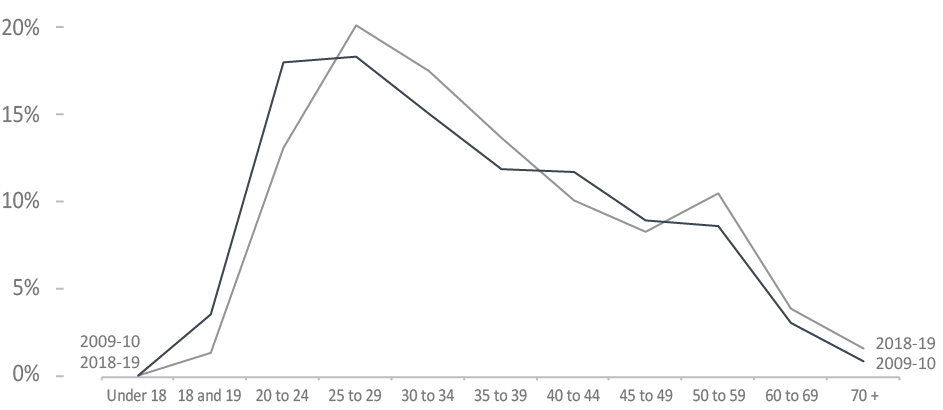
Source: Correctional Service Canada.
- In 2018-19, 33.3% of offenders admitted on a warrant of committal to federal jurisdiction were between the ages of 20 and 29, and 31.3% were between 30 and 39 years of age.
- The distribution of age upon admission is similar for both men and women.
- The median age of the population upon admission in 2018-19 was 34, compared to a median age of 33 in 2009-10.
- The number of offenders between the ages of 40 and 49 at admission decreased from 1,054 in 2009-10 to 871 in 2018-19, representing a 17.4% decrease.
- The number of offenders between the ages of 50 and 59 at admission increased from 442 in 2009-10 to 498 in 2018-19 representing a 12.7% increase.
Notes:
A warrant of committal is a new admission to federal jurisdiction from the courts.
Due to rounding, percentages may not add to 100 percent.
There is a lag in the data entry of admissions into CSC's Offender Management System. The admission figures for the most recent year are under-reported by 200-400 at the time of our year end extraction. More accurate figures will be available in the next year's publication. Please use caution when including the most recent year in any trend analysis.
Age at Admission |
2009-10 |
2018-19 |
||||||||||||
|---|---|---|---|---|---|---|---|---|---|---|---|---|---|---|
Women |
Men |
Total |
Women |
Men |
Total |
|||||||||
# |
% |
# |
% |
# |
% |
# |
% |
# |
% |
# |
% |
|||
Under 18 |
0 |
0 |
1* |
0 |
1* |
0 |
0 |
0 |
0 |
0 |
0 |
0 |
||
18 and 19 |
4 |
1.3 |
178 |
3.7 |
182 |
3.5 |
3 |
0.8 |
58 |
1.3 |
61 |
1.3 |
||
20 to 24 |
54 |
17.6 |
876 |
18.1 |
930 |
18.1 |
46 |
12.9 |
575 |
13.1 |
621 |
13.1 |
||
25 to 29 |
66 |
21.5 |
880 |
18.2 |
946 |
18.4 |
81 |
22.7 |
880 |
20 |
961 |
20.2 |
||
30 to 34 |
49 |
16 |
729 |
15.1 |
778 |
15.1 |
69 |
19.3 |
767 |
17.5 |
836 |
17.6 |
||
35 to 39 |
43 |
14 |
569 |
11.8 |
612 |
11.9 |
47 |
13.2 |
603 |
13.7 |
650 |
13.7 |
||
40 to 44 |
35 |
11.4 |
564 |
11.7 |
599 |
11.7 |
33 |
9.2 |
445 |
10.1 |
478 |
10.1 |
||
45 to 49 |
24 |
7.8 |
431 |
8.9 |
455 |
8.9 |
32 |
9 |
361 |
8.2 |
393 |
8.3 |
||
50 to 59 |
27 |
8.8 |
415 |
8.6 |
442 |
8.6 |
34 |
9.5 |
464 |
10.6 |
498 |
10.5 |
||
60 to 69 |
4 |
1.3 |
149 |
3.1 |
153 |
3 |
12 |
3.4 |
169 |
3.8 |
181 |
3.8 |
||
70 and over |
1 |
0.3 |
41 |
0.8 |
42 |
0.8 |
0 |
0 |
70 |
1.6 |
70 |
1.5 |
||
Total |
307 |
4,833 |
5,140 |
357 |
4,392 |
4,749 |
||||||||
Source: Correctional Service Canada.
Notes:
*This offender was admitted to a youth correctional centre.
A warrant of committal is a new admission to federal jurisdiction from the courts.
Due to rounding, percentages may not add to 100 percent.
There is a lag in the data entry of admissions into CSC's Offender Management System. The admission figures for the most recent year are under-reported by 200-400 at the time of our year end extraction. More accurate figures will be available in the next year's publication. Please use caution when including the most recent year in any trend analysis.
The average age at admission to federal jurisdiction is lower for Indigenous offenders
Figure C7
Percentage of warrant of committal admissions (2018-19)
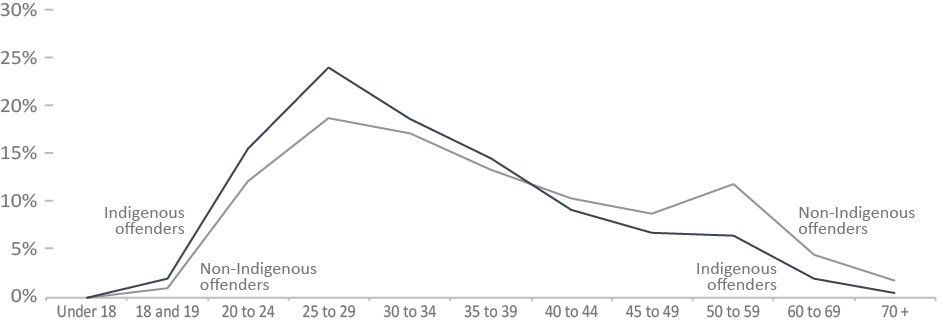
Source: Correctional Service Canada.
- Of those offenders admitted on a warrant of committal to federal jurisdiction in 2018-19, 41.7% of Indigenous offenders were under the age of 30, compared to 32.0% of non-Indigenous offenders.
- The median age of Indigenous offenders at admission was 32, compared to a median age of 35 for non-Indigenous offenders.
- The median age of Indigenous women offenders at admission was 32, compared to a median age of 34 for non-Indigenous women offenders.
Notes:
A warrant of committal is a new admission to federal jurisdiction from the courts.
Due to rounding, percentages may not add to 100 percent.
There is a lag in the data entry of admissions into CSC's Offender Management System. The admission figures for the most recent year are under-reported by 200-400 at the time of our year end extraction. More accurate figures will be available in the next year's publication. Please use caution when including the most recent year in any trend analysis.
Age at Admission |
2009-10 |
2018-19 |
||||||||||||
|---|---|---|---|---|---|---|---|---|---|---|---|---|---|---|
Indigenous |
Non- Indigenous |
Total |
Indigenous |
Non- Indigenous |
Total |
|||||||||
# |
% |
# |
% |
# |
% |
# |
% |
# |
% |
# |
% |
|||
Under 18 |
1* |
0.1 |
0 |
0 |
1* |
0 |
0 |
0 |
0 |
0 |
0 |
0 |
||
18 and 19 |
59 |
5.2 |
123 |
3.1 |
182 |
3.5 |
25 |
2 |
36 |
1 |
61 |
1.3 |
||
20 to 24 |
262 |
23 |
668 |
16.7 |
930 |
18.1 |
199 |
15.6 |
422 |
12.2 |
621 |
13.1 |
||
25 to 29 |
246 |
21.6 |
700 |
17.5 |
946 |
18.4 |
308 |
24.1 |
653 |
18.8 |
961 |
20.2 |
||
30 to 34 |
173 |
15.2 |
605 |
15.1 |
778 |
15.1 |
239 |
18.7 |
597 |
17.2 |
836 |
17.6 |
||
35 to 39 |
135 |
11.8 |
477 |
11.9 |
612 |
11.9 |
186 |
14.6 |
464 |
13.4 |
650 |
13.7 |
||
40 to 44 |
121 |
10.6 |
478 |
12 |
599 |
11.7 |
117 |
9.2 |
361 |
10.4 |
478 |
10.1 |
||
45 to 49 |
83 |
7.3 |
372 |
9.3 |
455 |
8.9 |
87 |
6.8 |
306 |
8.8 |
393 |
8.3 |
||
50 to 59 |
48 |
4.2 |
394 |
9.9 |
442 |
8.6 |
83 |
6.5 |
415 |
11.9 |
498 |
10.5 |
||
60 to 69 |
11 |
1 |
142 |
3.6 |
153 |
3 |
26 |
2 |
155 |
4.5 |
181 |
3.8 |
||
70 and over |
1 |
0.1 |
41 |
1 |
42 |
0.8 |
6 |
0.5 |
64 |
1.8 |
70 |
1.5 |
||
Total |
1,140 |
4,000 |
5,140 |
1,276 |
3,473 |
4,749 |
||||||||
Source: Correctional Service Canada.
Notes:
*This offender was admitted to a youth correctional centre.
A warrant of committal is a new admission to federal jurisdiction from the courts.
Due to rounding, percentages may not add to 100 percent.
There is a lag in the data entry of admissions into CSC's Offender Management System. The admission figures for the most recent year are under-reported by 200-400 at the time of our year end extraction. More accurate figures will be available in the next year's publication. Please use caution when including the most recent year in any trend analysis.
24% of the in-custody offender population is age 50 or over
Figure C8
Percentage of in-custody offender population (2018-19)* vs. Canadian adult population (2019)**
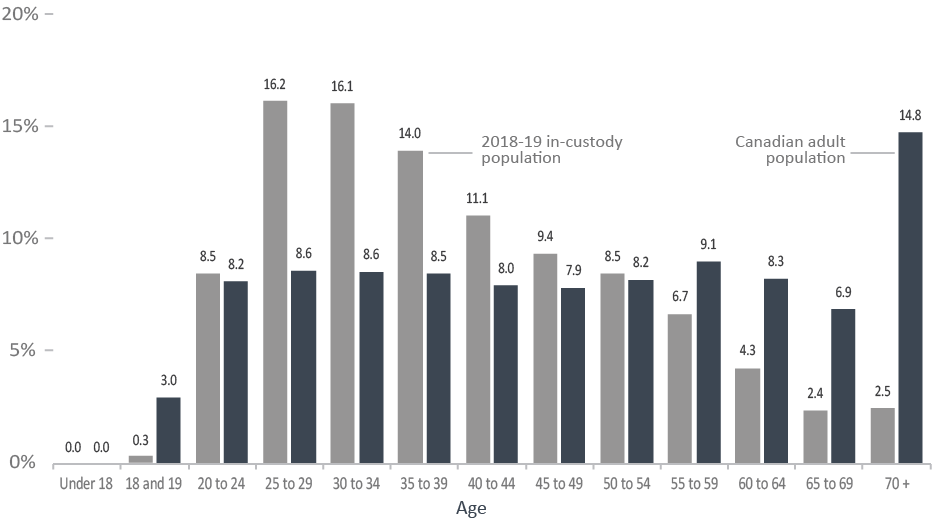
Sources: Correctional Service of Canada; Table 17-10-0005-01, Population estimates on July 1st (2019), by age and sex, Statistics Canada.
- In 2018-19, 55.1% of in-custody offenders were under the age of 40.
- In 2018-19, 24.4% of the in-custody offender population was aged 50 and over.
- ***The community offender population was older than the in-custody population; 38.7% of offenders in the community were aged 50 and over, compared to 24.4% of the in-custody offenders in this age group.
Notes:
*In-custody population includes all active offenders incarcerated in a CSC facility, offenders on temporary absence from a CSC facility, offenders who are temporarily detained in a CSC facility and offenders on remand in a CSC facility.
**2019 Annual Demographic Estimates, Demographic Division, Statistics Canada includes only those age 18 and older.
***In Community Under Supervision includes all active offenders on day parole, full parole, statutory release, or in the community supervised on a long-term supervision order, offenders who are temporarily detained in a non-CSC facility, offenders who are unlawfully at large for less than 90 days, offenders on remand in a non-CSC facility, and offenders supervised and subject to an immigration hold by Canada Border Services Agency.
Due to rounding, percentage may not add to 100 percent.
Age |
In-Custody* |
In Community Under Supervision** |
Total |
% of Canadian Adult Population*** |
|||||||
|---|---|---|---|---|---|---|---|---|---|---|---|
# |
% |
# |
% |
# |
% |
% |
|||||
Under 18 |
0 |
0.0 |
0 |
0.0 |
0 |
0.0 |
0.0 |
||||
18 and 19 |
44 |
0.3 |
1 |
0.0 |
45 |
0.2 |
3.0 |
||||
20 to 24 |
1,197 |
8.5 |
417 |
4.5 |
1,614 |
6.9 |
8.2 |
||||
25 to 29 |
2,293 |
16.2 |
1,026 |
11.0 |
3,319 |
14.1 |
8.6 |
||||
30 to 34 |
2,277 |
16.1 |
1,213 |
13.0 |
3,490 |
14.9 |
8.6 |
||||
35 to 39 |
1,982 |
14.0 |
1,165 |
12.5 |
3,147 |
13.4 |
8.5 |
||||
40 to 44 |
1,568 |
11.1 |
961 |
10.3 |
2,529 |
10.8 |
8.0 |
||||
45 to 49 |
1,329 |
9.4 |
931 |
10.0 |
2,260 |
9.6 |
7.9 |
||||
50 to 54 |
1,207 |
8.5 |
887 |
9.5 |
2,094 |
8.9 |
8.2 |
||||
55 to 59 |
952 |
6.7 |
869 |
9.3 |
1,821 |
7.8 |
9.1 |
||||
60 to 64 |
605 |
4.3 |
677 |
7.3 |
1,282 |
5.5 |
8.3 |
||||
65 to 69 |
336 |
2.4 |
512 |
5.5 |
848 |
3.6 |
6.9 |
||||
70 and over |
359 |
2.5 |
656 |
7.0 |
1,015 |
4.3 |
14.8 |
||||
Total |
14,149 |
100.0 |
9,315 |
100.0 |
23,464 |
100.0 |
100.0 |
||||
Sources: Correctional Service of Canada; Table 17-10-0005-01, Population estimates on July 1st (2019), by age and sex, Statistics Canada.
Notes:
*In-custody population includes all active offenders incarcerated in a CSC facility, offenders on temporary absence from a CSC facility, offenders who are temporarily detained in a CSC facility and offenders on remand in a CSC facility.
**In Community Under Supervision includes all active offenders on day parole, full parole, statutory release, or in the community supervised on a long-term supervision order, offenders who are temporarily detained in a non-CSC facility, offenders who are unlawfully at large for less than 90 days, offenders on remand in a non-CSC facility, and offenders supervised and subject to an immigration hold by Canada Border Services Agency.
Due to rounding, percentage may not add to 100 percent.
***2019 Annual Demographic Estimates, Demographic Division, Statistics Canada includes only those age 18 and older.
54% of offenders are Caucasian
Figure C9
Percentage of total offender population by self-reported race (2018-19)
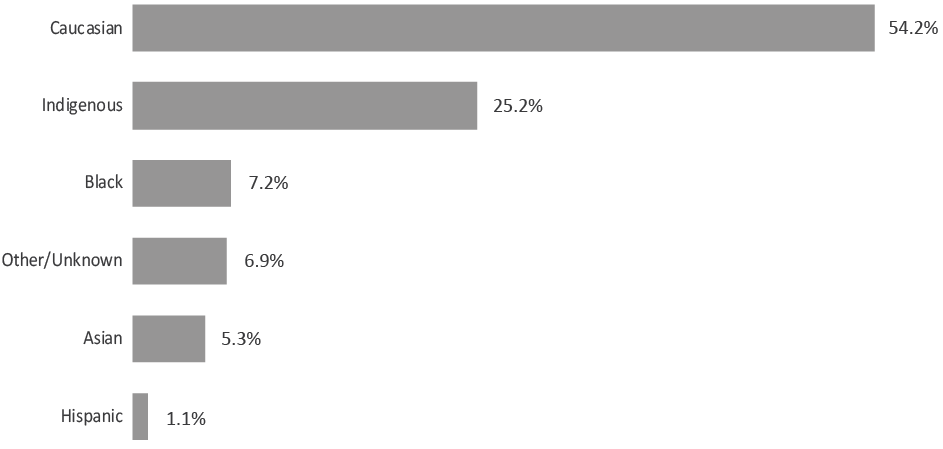
Source: Correctional Service of Canada.
- The federal offender population is becoming more diverse, as evidenced by the decrease in the proportion of Caucasian offenders (from 60.4% in 2014-15 to 54.2% in 2018-19).
- Between 2014-15 and 2018-19, the Indigenous population has increased by 18.1% (from 5,009 to 5,914).
- Indigenous offenders represented 25.2% of the 2018-19 total federal offender population and 26.9% of 2018-19 warrant of committal admissions to federal jurisdiction.
Notes:
The data reflect all active offenders at the end of the fiscal year (April 1 – March 31), who are incarcerated in a CSC facility, offenders on temporary absence from a CSC facility, offenders who are temporarily detained, offenders who are actively supervised, and offenders who are unlawfully at large for less than 90 days.
The offenders themselves identify to which race they belong. The list of categories may not fully account for all races and the race grouping information has changed starting in 2012-13; therefore, the comparison of the information before and after 2012-13 should be done with caution.
According to the Correctional Service of Canada, "Indigenous" includes offenders who are Inuit, Innu, Métis and North American Indian. "Asian" includes offenders who are Arab, Arab/West Asian, Asian-East and Southeast, Asian-South, Asian West, Asiatic, Chinese, East Indian, Filipino, Japanese, Korean, South Asian, South East Asian. "Hispanic" includes offenders who are Hispanic and Latin American. "Black" includes offenders who are black. "Other/Unknown" includes offenders who are European French, European-Eastern, European-Northern, European-Southern, European-Western, Multiracial/Ethnic, Oceania, British Isles, Caribbean, Sub-Sahara African, offenders unable to identify to one race, other and unknown.
Due to rounding, percentages may not add to 100 percent.
Total Offender Population |
|||||
|---|---|---|---|---|---|
2014-15 |
2018-19 |
||||
# |
% |
# |
% |
||
Indigenous |
5,009 |
21.8 |
5,914 |
25.2 |
|
Inuit |
236 |
1.0 |
198 |
0.8 |
|
Métis |
1,381 |
6.0 |
1,723 |
7.3 |
|
North American Indian |
3,392 |
14.8 |
3,993 |
17.0 |
|
Asian |
1,318 |
5.7 |
1,250 |
5.3 |
|
Arab |
155 |
0.7 |
179 |
0.8 |
|
Arab / West Asian |
195 |
0.8 |
176 |
0.8 |
|
Asiatic* |
272 |
1.2 |
377 |
1.6 |
|
Chinese |
134 |
0.6 |
95 |
0.4 |
|
East Indian |
13 |
0.1 |
13 |
0.1 |
|
Filipino |
71 |
0.3 |
85 |
0.4 |
|
Japanese |
5 |
0.0 |
8 |
0.0 |
|
Korean |
21 |
0.1 |
12 |
0.1 |
|
South East Asian |
273 |
1.2 |
184 |
0.8 |
|
South Asian |
179 |
0.8 |
121 |
0.5 |
|
Black |
1,895 |
8.3 |
1,692 |
7.2 |
|
Caucasian |
13,870 |
60.4 |
12,713 |
54.2 |
|
Hispanic |
250 |
1.1 |
267 |
1.1 |
|
Hispanic |
6 |
0.0 |
7 |
0.0 |
|
Latin American |
244 |
1.1 |
260 |
1.1 |
|
Other/Unknown |
619 |
2.7 |
1,628 |
6.9 |
|
Total |
22,961 |
100.0 |
23,464 |
100.0 |
|
Source: Correctional Service Canada.
Notes:
The data reflect all active offenders at the end of the fiscal year (April 1 – March 31), who are incarcerated in a CSC facility, offenders on temporary absence from a CSC facility, offenders who are temporarily detained, offenders who are actively supervised, and offenders who are unlawfully at large for less than 90 days.
*Total for Asiatic includes Asian-East and Southeast, Asian South, Asian West, and Asiatic.
The offenders themselves identify to which race they belong. The list of categories may not fully account for all races and the race groupings information has changed starting in 2012-13; therefore, the comparisons before and after 2012-13 should be done with caution.
According to the Correctional Service of Canada, "Indigenous" includes offenders who are Inuit, Innu, Métis and North American Indian. "Asian" includes offenders who are Arab, Arab/West Asian, Asian-East and Southeast, Asian-South, Asian West, Asiatic, Chinese, East Indian, Filipino, Japanese, Korean, South Asian, South East Asian. "Asiatic" includes offenders who are Asian-East and Southeast, Asian-South, Asian West, and Asiatic. "Hispanic" includes offenders who are Hispanic and Latin American. "Black" includes offenders who are Black. "Other/Unknown" includes offenders who are European French, European-Eastern, European-Northern, European-Southern, European-Western, Multiracial/Ethnic, Oceania, British Isles, Caribbean, Sub-Sahara African, offenders unable to identify to one race, other and unknown.
Due to rounding, percentages may not add up to 100 percent.
The religious identification of the offender population is diverse
Figure C10
Percentage of total offender population (2018-19)
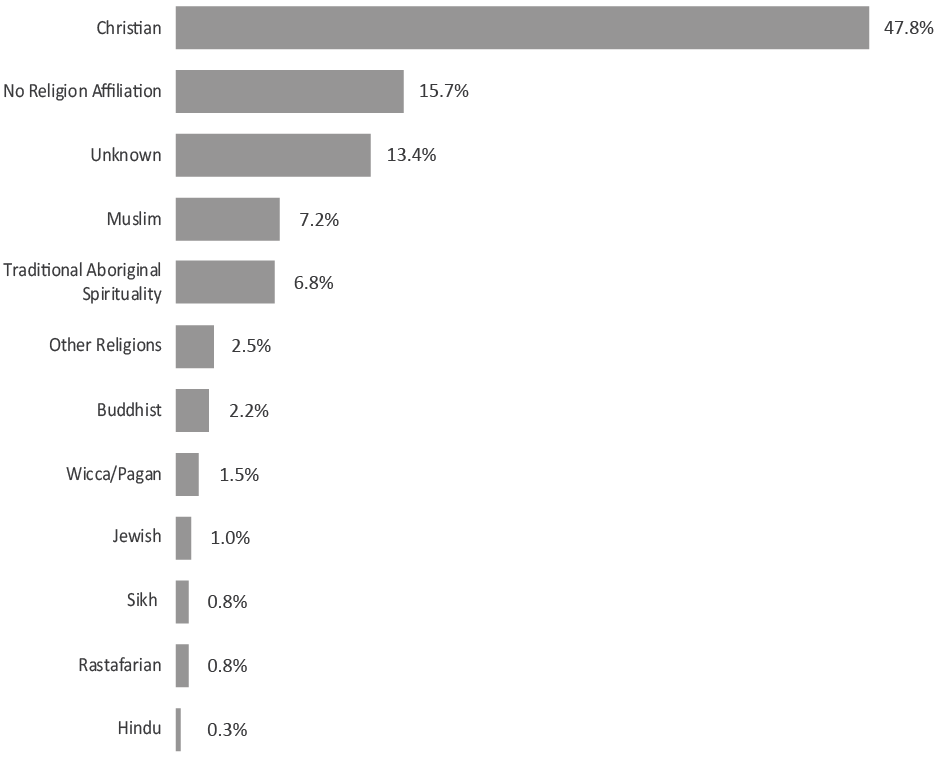
Source: Correctional Service of Canada.
- The religious identification of the Offender population is diverse. While the proportion of offenders who identified as Christian still represented the majority, their proportions decreased from 55.3% in 2014-15 to 47.8% in 2018-19.
- Religious identification was unknown for 13.4% of offenders, whereas 15.7% stated they had no religion.
- Note that the religion groupings have changed in the 2018 publication to reflect the same groupings as Statistics Canada.
Notes:
Religious identification is self-declared by offenders while they are incarcerated, and the categories are not comprehensive; therefore, the reader should interpret these data with caution. A detailed breakdown of each religious category is available in the notes section on page 58.
Total Offender Population |
|||||
|---|---|---|---|---|---|
2014-15 |
2018-19 |
||||
# |
% |
# |
% |
||
Buddhist |
478 |
2.1 |
519 |
2.2 |
|
Christian |
12,705 |
55.3 |
11,219 |
47.8 |
|
Hindu |
40 |
0.2 |
64 |
0.3 |
|
Jewish |
171 |
0.7 |
244 |
1.0 |
|
Muslim |
1,280 |
5.6 |
1,695 |
7.2 |
|
Rastafarian |
171 |
0.7 |
181 |
0.8 |
|
Sikh |
155 |
0.7 |
183 |
0.8 |
|
Traditional Aboriginal Spirituality |
1,276 |
5.6 |
1,591 |
6.8 |
|
Wicca/Pagan |
170 |
0.7 |
352 |
1.5 |
|
Other Religions |
488 |
2.1 |
579 |
2.5 |
|
No Religion Affiliation |
3,808 |
16.6 |
3,695 |
15.7 |
|
Unknown |
2,219 |
9.7 |
3,142 |
13.4 |
|
Total |
22,961 |
100.0 |
23,464 |
100.0 |
|
Source: Correctional Service Canada.
Notes:
Religious identification is self-declared by offenders while they are incarcerated, and the categories are not comprehensive; therefore, the reader should interpret these data with caution.
Buddhist includes offenders who are Buddhist, Mahayana Buddhist, Theravadan Buddhist and Vajrayana Buddhist. Christian includes offenders who are Amish, Anglican (Episcopal Church of England), Antiochian Orthodox, Apostolic Christian Church, Armenian Orthodox/Apostolic, Associated Gospel, Assyrian Chaldean Catholic, Baptist, Brethren In Christ, Bulgarian Orthodox, Canadian Reformed Church, Catholic- Greek, Catholic-Roman, Catholic-Ukranian, Catholic Non-Specific, Churches of Christ/Christian Churches, Charismatic, Christadelphian, Christian & Missionary Alliance, Christian Congregational, Christian Non Specific, Christian Or Plymouth Brethren, Christian Orthodox, Christian Reformed, Christian Reformed Church, Christian Science, Church of Christ Scientist, Church of God, Church of Jesus Christ of Latter-Day Saint, Community of Christ, Coptic Orthodox, Doukhobor, Dutch Reformed Church, Ethiopian Orthodox, Evangelical, Evangelical Free Church , Evangelical Missionary Church, Free Methodist, Free Reformed Church, Grace Communion International, Greek Orthodox, Hutterite, Iglesia Ni Cristo, Jehovah's Witnesses, Lutheran, Macedonian Orthodox, Maronite, Melkite, Mennonite, Methodist Christian, Metropolitan Community Church, Mission de l'Esprit Saint, Moravian, Mormon (Latter Day Saints), Nazarene Christian, Netherlands Reformed, New Apostolic, Pentecostal (4-Square), Pentecostal Assembly of God, Pentecôtiste, Philadelphia Church of God, Presbyterian, Protestant Non-Specific, Quaker (Society of Friends), Reformed Christian, Romanian Orthodox, Russian Orthodox, Salvation Army, Serbian Orthodox, Seventh Day Adventist, Shaker, Swedenborgian (New Church), Syrian/Syriac Orthodox, Ukrainian Catholic, Ukrainian Orthodox, United Church, United Reformed Church, Vineyard Christian Fellowship, Wesleyan Christian and Worldwide Church of God. Hindu includes offenders who are Hindu and Siddha Yoga. Jewish includes offenders who are Jewish Orthodox, Jewish Reformed and Judaism. Muslim includes offenders who are Muslim and Sufism. Rastafarian includes offenders who are Rastafarian. Sikh includes offenders who are Sikh. Traditional Aboriginal Spirituality includes offenders who are Aboriginal Spirituality Catholic, Aboriginal Spirituality Protestant, Native Spirituality, Catholic - Native Spirituality, Native Spirituality Protestant and Aboriginal Spirituality. Wiccan/Pagan includes offenders who are Asatru Paganism, Druidry Paganism, Pagan and Wicca. Other Religion includes offenders who are Baha'i, Eckankar, Gnostic, Independent Spirituality, Jain, Krishna, New Age, New Thought-Unity-Religious Science, Other, Pantheist, Rosicrucian, Satanist, Scientology, Shintoïste, Spiritualist, Taoism, Transcendental Meditation, Unification Church, Unitarian, Visnabha and Zoroastrian. No religion Affiliation includes offenders who are Agnostic, Atheist, Humanist and offenders who have no religion affiliation.
The data reflect all active offenders, who are incarcerated in a CSC facility, offenders on temporary absence from a CSC facility, offenders who are temporarily detained, offenders who are actively supervised, and offenders who are unlawfully at large for less than 90 days.
The data reflect the number of offenders active at the end of each fiscal year. A fiscal year runs from April 1 to March 31 of the following year.
Due to rounding, percentages may not add to 100 percent.
The proportion of Indigenous offenders in custody is higher than for non-Indigenous offenders
Figure C11
Percentage of in-custody offender population
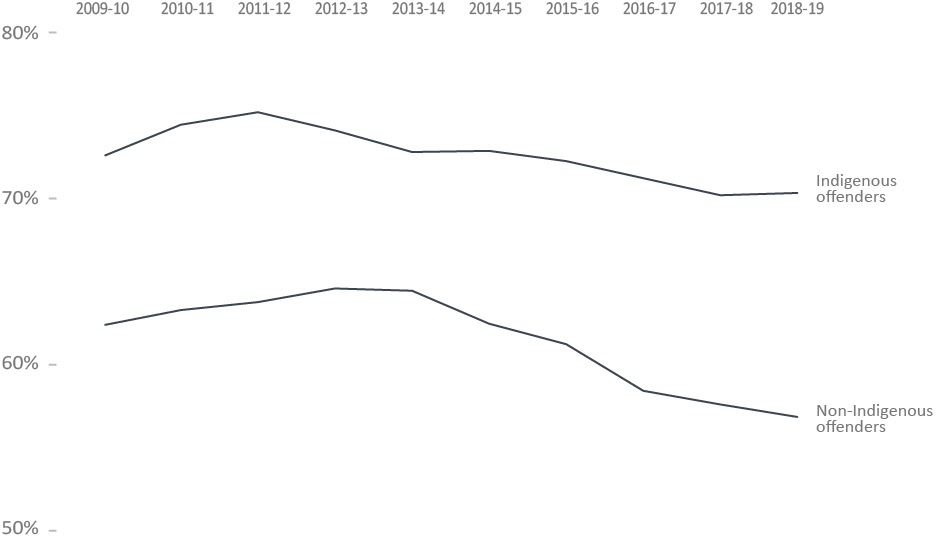
Source: Correctional Service of Canada.
- At the end of fiscal year 2018-19, the proportion of offenders in custody was 13.6% greater for Indigenous offenders (70.5%) than for non-Indigenous offenders (56.9%).
- Indigenous women in custody represent 41.5% of all in-custody women while Indigenous men who were in custody represented 28.8% of all men in custody.
- In 2018-19, Indigenous offenders represented 25.2% of the total offender population.
- Indigenous offenders accounted for 29.5% of the in-custody population and 18.7% of the community population in 2018-19.
Notes:
Total Offender Population includes all active offenders, who are incarcerated in a CSC facility, offenders on temporary absence from a CSC facility, offenders who are temporarily detained, offenders who are actively supervised, and offenders who are unlawfully at large for less than 90 days.
In Custody includes all active offenders incarcerated in a CSC facility, offenders on temporary absence from a CSC facility, offenders who are temporarily detained in a CSC facility and offenders on remand in a CSC facility.
In Community Under Supervision includes all active offenders on day parole, full parole, statutory release, in the community supervised on a long-term supervision order, offenders who are temporarily detained in a non-CSC facility, offenders who are unlawfully at large for less than 90 days, offenders on remand in a non-CSC facility, and offenders supervised and subject to an immigration hold by Canada Border Services Agency.
The data reflect the number of offenders active at the end of each fiscal year. A fiscal year runs from April 1 to March 31 of the following year.
In-Custody Population |
In Community Under Supervision |
Total |
||||||
|---|---|---|---|---|---|---|---|---|
# |
% |
# |
% |
|||||
Men |
||||||||
2015-16 |
Indigenous |
3,532 |
73.2 |
1,293 |
26.8 |
4,825 |
||
Non-Indigenous |
10,485 |
61.8 |
6,468 |
38.2 |
16,953 |
|||
Total |
14,017 |
64.4 |
7,761 |
35.6 |
21,778 |
|||
2016-17 |
Indigenous |
3,545 |
72.2 |
1,362 |
27.8 |
4,907 |
||
Non-Indigenous |
9,922 |
59.0 |
6,885 |
41.0 |
16,807 |
|||
Total |
13,467 |
62.0 |
8,247 |
38.0 |
21,714 |
|||
2017-18 |
Indigenous |
3,647 |
71.4 |
1,464 |
28.6 |
5,111 |
||
Non-Indigenous |
9,769 |
58.4 |
6,946 |
41.6 |
16,715 |
|||
Total |
13,416 |
61.5 |
8,410 |
38.5 |
21,826 |
|||
2018-19 |
Indigenous |
3,877 |
71.5 |
1,548 |
28.5 |
5,425 |
||
Non-Indigenous |
9,571 |
57.6 |
7,036 |
42.4 |
16,607 |
|||
Total |
13,448 |
61.0 |
8,584 |
39.0 |
22,032 |
|||
Women |
||||||||
2015-16 |
Indigenous |
251 |
62.4 |
151 |
37.6 |
402 |
||
Non-Indigenous |
444 |
50.6 |
433 |
49.4 |
877 |
|||
Total |
695 |
54.3 |
584 |
45.7 |
1,279 |
|||
2016-17 |
Indigenous |
253 |
61.0 |
162 |
39.0 |
415 |
||
Non-Indigenous |
439 |
47.9 |
477 |
52.1 |
916 |
|||
Total |
692 |
52.0 |
639 |
48.0 |
1,331 |
|||
2017-18 |
Indigenous |
270 |
58.6 |
191 |
41.4 |
461 |
||
Non-Indigenous |
406 |
43.4 |
530 |
56.6 |
936 |
|||
Total |
676 |
48.4 |
721 |
51.6 |
1,397 |
|||
2018-19 |
Indigenous |
291 |
59.5 |
198 |
40.5 |
489 |
||
Non-Indigenous |
410 |
43.5 |
533 |
56.5 |
943 |
|||
Total |
701 |
49.0 |
731 |
51.0 |
1,432 |
|||
Source: Correctional Service Canada.
Notes:
Total Offender Population includes all active offenders, who are incarcerated in a CSC facility, offenders on temporary absence from a CSC facility, offenders who are temporarily detained, offenders who are actively supervised, and offenders who are unlawfully at large for less than 90 days.
In custody includes all active offenders incarcerated in a CSC facility, offenders on temporary absence from a CSC facility, offenders who are temporarily detained in a CSC facility and offenders on remand in a CSC facility.
In Community Under Supervision includes all active offenders on day parole, full parole, statutory release, in the community supervised on a long-term supervision order, offenders who are temporarily detained in a non-CSC facility, offenders who are unlawfully at large for less than 90 days, offenders on remand in a non-CSC facility, and offenders supervised and subject to an immigration hold by Canada Border Services Agency.
The data reflect the number of offenders active at the end of each fiscal year. A fiscal year runs from April 1 to March 31 of the following year.
The majority of in-custody offenders are classified as medium security risk
Figure C12
Percentage of classified in-custody offenders (2018-19)
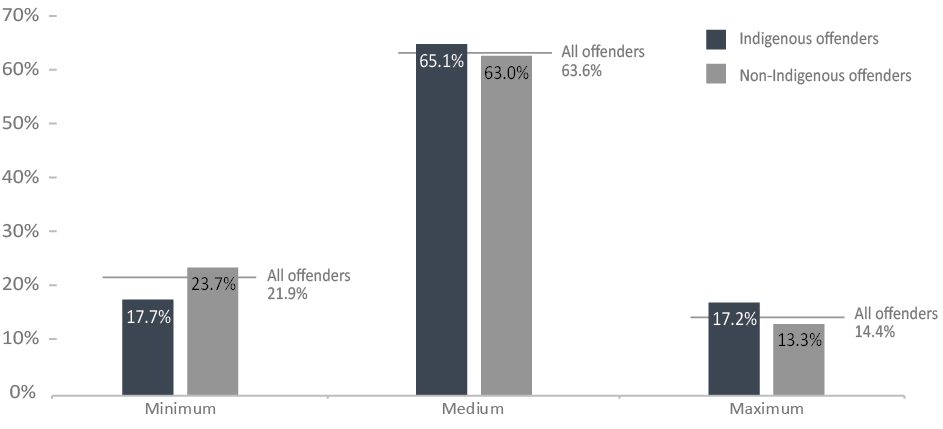
Source: Correctional Service Canada.
- Approximately two-thirds (63.6%) of offenders were classified as medium security risk.
- Indigenous offenders were more likely to be classified to a medium or maximum security risk compared to non-Indigenous.
- Compared to non-Indigenous offenders, a lower percentage of Indigenous offenders were classified as minimum security risk (17.7% vs. 23.7%) and a higher percentage were classified as medium (65.1% vs. 63.0%) and maximum (17.2% vs. 13.3%) security risk.
Note:
The data represent the offender security level decision as of end of fiscal year 2018-19.
In custody includes all active offenders incarcerated in a CSC facility, offenders on temporary absence from a CSC facility, offenders who are temporarily detained in a CSC facility and offenders on remand in a CSC facility.
Security Risk Level |
Indigenous |
Non-Indigenous |
Total |
|||||
|---|---|---|---|---|---|---|---|---|
# |
% |
# |
% |
# |
% |
|||
Minimum |
687 |
17.7 |
2,138 |
23.7 |
2,825 |
21.9 |
||
Medium |
2,523 |
65.1 |
5,677 |
63.0 |
8,200 |
63.6 |
||
Maximum |
667 |
17.2 |
1,195 |
13.3 |
1,862 |
14.4 |
||
Total |
3,877 |
100.0 |
9,010 |
100.0 |
12,887 |
100.0 |
||
Not Yet Determined |
291 |
971 |
1,262 |
|||||
Total |
4,168 |
9,981 |
14,149 |
|||||
Source: Correctional Service Canada.
Notes:
The data represent the offender security level decision as of end of fiscal year 2018-19.
The "Not yet determined" category includes offenders who have not yet been classified.
In-custody includes all active offenders incarcerated in a CSC facility, offenders on temporary absence from a CSC facility, offenders who are temporarily detained in a CSC facility and offenders on remand in a CSC facility.
Admissions to federal jurisdiction with a life or indeterminate sentence has decreased
Figure C13
Number of warrant of committal admissions for life and indeterminate sentences
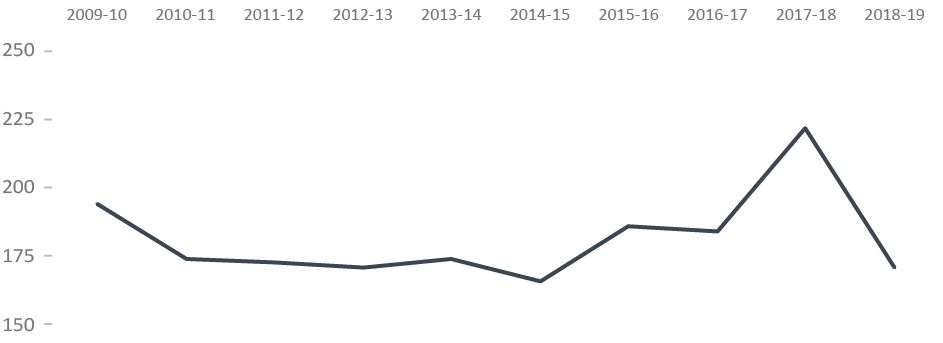
Source: Correctional Service of Canada.
- From 2009-10 to 2018-19, there was a decrease of 11.9% in the number of warrant of committal admissions to federal jurisdiction with a life/indeterminate* sentence from 194 to 171.
- At the end of fiscal year 2018-19, there were a total of 3,684 offenders in custody with a life/indeterminate sentence. Of these, 3,548 (96.3%) were men and 136 (3.7%) were women; 998 (27.1%) were Indigenous and 2,686 (72.9%) were non-Indigenous.
- At the end of fiscal year 2018-19, 24.3% of the total population was serving a life/indeterminate sentence. Of these offenders, 64.5% were in custody and 35.5% were in the community under supervision.
Notes:
*Although life sentences and indeterminate sentences both may result in imprisonment for life, they are different. A life sentence is a sentence of life imprisonment, imposed by a judge at the time of sentence, for example for murder. An indeterminate sentence is a result of a designation, where an application is made to the court to declare an offender a Dangerous Offender, and the consequence of this designation is imprisonment for an indeterminate period.
A warrant of committal is a new admission to federal jurisdiction from the courts.
Total Offender Population includes all active offenders, who are incarcerated in a CSC facility, offenders on temporary absence from a CSC facility, offenders who are temporarily detained, offenders who are actively supervised, and offenders who are unlawfully at large for less than 90 days.
There is a lag in the data entry of admissions into CSC's Offender Management System. The admission figures for the most recent year are under-reported by 200-400 at the time of our year end extraction. More accurate figures will be available in the next year's publication. Please use caution when including the most recent year in any trend analysis.
Year |
Indigenous Offenders |
Non-Indigenous Offenders |
Total |
|||||||||
|---|---|---|---|---|---|---|---|---|---|---|---|---|
Women |
Men |
Total |
Women |
Men |
Total |
Women |
Men |
Total |
||||
2009-10 |
5 |
48 |
53 |
8 |
133 |
141 |
13 |
181 |
194 |
|||
2010-11 |
3 |
35 |
38 |
6 |
130 |
136 |
9 |
165 |
174 |
|||
2011-12 |
6 |
47 |
53 |
11 |
109 |
120 |
17 |
156 |
173 |
|||
2012-13 |
6 |
47 |
53 |
2 |
116 |
118 |
8 |
163 |
171 |
|||
2013-14 |
7 |
39 |
46 |
7 |
121 |
128 |
14 |
160 |
174 |
|||
2014-15 |
1 |
37 |
38 |
8 |
120 |
128 |
9 |
157 |
166 |
|||
2015-16 |
5 |
50 |
55 |
6 |
125 |
131 |
11 |
175 |
186 |
|||
2016-17 |
1 |
40 |
41 |
11 |
132 |
143 |
12 |
172 |
184 |
|||
2017-18 |
6 |
72 |
78 |
10 |
134 |
144 |
16 |
206 |
222 |
|||
2018-19 |
5 |
45 |
50 |
4 |
117 |
121 |
9 |
162 |
171 |
|||
Source: Correctional Service of Canada.
Notes:
This table combines offenders serving life sentences and offenders serving indeterminate sentences.
Although life sentences and indeterminate sentences both may result in imprisonment for life, they are different. A life sentence is a sentence of life imprisonment, imposed by a judge at the time of sentence, for example for murder. An indeterminate sentence is a result of a designation, where an application is made to the court to declare an offender a Dangerous Offender, and the consequence of this designation is imprisonment for an indeterminate period.
A warrant of committal is a new admission to federal jurisdiction from the courts.
Total Offender Population includes all active offenders, who are incarcerated in a CSC facility, offenders on temporary absence from a CSC facility, offenders who are temporarily detained, offenders who are actively supervised, and offenders who are unlawfully at large for less than 90 days.
There is a lag in the data entry of admissions into CSC's Offender Management System. The admission figures for the most recent year are under-reported by 200-400 at the time of our year end extraction. More accurate figures will be available in the next year's publication. Please use caution when including the most recent year in any trend analysis.
Offenders with life or indeterminate sentences represents 24% of the total offender population
Figure C14
Sentence imposed for the total offender population (2018-19)

Source: Correctional Service of Canada.
- At the end of fiscal year 2018-19, there were 5,713 offenders serving a life sentence and/or an indeterminate sentence. This represents 24.3% of the total offender population. The majority (64.5%) of these offenders were in custody. Of the 2,029 offenders who were in the community under supervision, the majority (80.8%) were serving a life sentence for 2nd Degree Murder.
- There were 22 offenders who were serving both a life sentence and an indeterminate sentence.*
- There were 651 offenders who were serving an indeterminate sentence as a result of a special designation. The remaining 5,040 offenders did not receive a special designation, but were serving a life sentence.
- 95.3% of the 635 Dangerous Offenders with indeterminate sentences were in custody and 4.7% were in the community under supervision.
- In contrast, 57.1% of the 14 Dangerous Sexual Offenders were in custody and all (2) of the offenders with an Habitual Offender designation were in the community under supervision (in this table there is one offender with an Habitual Offender designation included in the Designation and Life grouping, this offender was in the community under supervision as well).
Notes:
*Although life sentences and indeterminate sentences both may result in imprisonment for life, they are different. A life sentence is a sentence of life imprisonment, imposed by a judge at the time of sentence, for example for murder. An indeterminate sentence is a result of a designation, where an application is made to the court to declare an offender a Dangerous Offender, and the consequence of this designation is imprisonment for an indeterminate period. The Dangerous Sexual Offender and Habitual Offender designations were replaced with Dangerous Offender legislation in 1977.
Total Offender Population includes all active offenders, who are incarcerated in a CSC facility, offenders on temporary absence from a CSC facility, offenders who are temporarily detained, offenders who are actively supervised, and offenders who are unlawfully at large for less than 90 days. In Custody includes all active offenders incarcerated in a CSC facility, offenders on temporary absence from a CSC facility, offenders who are temporarily detained in a CSC facility and offenders on remand in a CSC facility. In Community Under Supervision includes all active offenders on day parole, full parole, statutory release, in the community supervised on a long-term supervision order, offenders who are temporarily detained in a non-CSC facility, offenders who are unlawfully at large for less than 90 days, offenders on remand in a non-CSC facility, and offenders supervised and subject to an immigration hold by the Canada Border Services Agency.
Total Offender Population |
In Custody in a CSC Facility |
In Community Under Supervision |
||||||||
|---|---|---|---|---|---|---|---|---|---|---|
Incarcerated |
Day Parole |
Full Parole |
Other*** |
|||||||
# |
% |
|||||||||
Offenders with a life sentence for: |
||||||||||
1st Degree Murder |
1,270 |
5.4 |
1,002 |
59 |
209 |
0 |
||||
2nd Degree Murder |
3,571 |
15.2 |
1,932 |
248 |
1,391 |
0 |
||||
Other Offences* |
199 |
0.8 |
117 |
7 |
75 |
0 |
||||
Total |
5,040 |
21.5 |
3,051 |
314 |
1,675 |
0 |
||||
Offenders with indeterminate sentences resulting from the special designation of: |
||||||||||
Dangerous Offender |
635 |
2.7 |
605 |
14 |
16 |
0 |
||||
Dangerous Sexual Offender |
14 |
0.1 |
8 |
1 |
5 |
0 |
||||
Habitual Offender |
2 |
0 |
0 |
0 |
2 |
0 |
||||
Total |
651 |
2.8 |
613 |
15 |
23 |
0 |
||||
Offenders serving an indeterminate sentence (due to a special designation) and a life sentence (due to an offence) |
22 |
0.1 |
20 |
0 |
2 |
0 |
||||
Total offenders with Life and/or Indeterminate sentence |
5,713 |
24.3 |
3,684 |
329 |
1,700 |
0 |
||||
Offenders Serving Determinate sentences** |
17,751 |
75.7 |
10,465 |
1,363 |
2,729 |
3,194 |
||||
Total |
23,464 |
100 |
14,149 |
1,692 |
4,429 |
3,194 |
||||
Source: Correctional Service Canada.
Notes:
*"Other offences" include Schedule I Schedule II and Non-Schedule types of offences.
**This includes 170 offenders designated as Dangerous Offenders who were serving determinate sentences.
***"Other" in the Community Under Supervision includes offenders on statutory release or on a long-term supervision order.
Among the 22 offenders serving an indeterminate sentence (due to a special designation) and a life sentence (due to an offence), there was one offender with an Habitual Offender designation.
Although life sentences and indeterminate sentences both may result in imprisonment for life, they are different. A life sentence is a sentence of life imprisonment, imposed by a judge at the time of sentence, for example for murder. An indeterminate sentence is a result of a designation, where an application is made to the court to declare an offender a Dangerous Offender, and the consequence of this designation is imprisonment for an indeterminate period. The Dangerous Sexual Offender and Habitual Offender designations were replaced with Dangerous Offender legislation in 1977.
Total Offender Population includes all active offenders, who are incarcerated in a CSC facility, offenders on temporary absence from a CSC facility, offenders who are temporarily detained, offenders who are actively supervised, and offenders who are unlawfully at large for less than 90 days. In Custody includes all active offenders incarcerated in a CSC facility, offenders on temporary absence from a CSC facility, offenders who are temporarily detained in a CSC facility and offenders on remand in a CSC facility. In Community Under Supervision includes all active offenders on day parole, full parole, statutory release, in the community supervised on a long-term supervision order, offenders who are temporarily detained in a non-CSC facility, offenders who are unlawfully at large for less than 90 days, offenders on remand in a non-CSC facility, and offenders supervised and subject to an immigration hold by the Canada Border Services Agency.
70% of offenders are serving a sentence for a violent offence
Figure C15
Percentage of total offender population (2018-19)
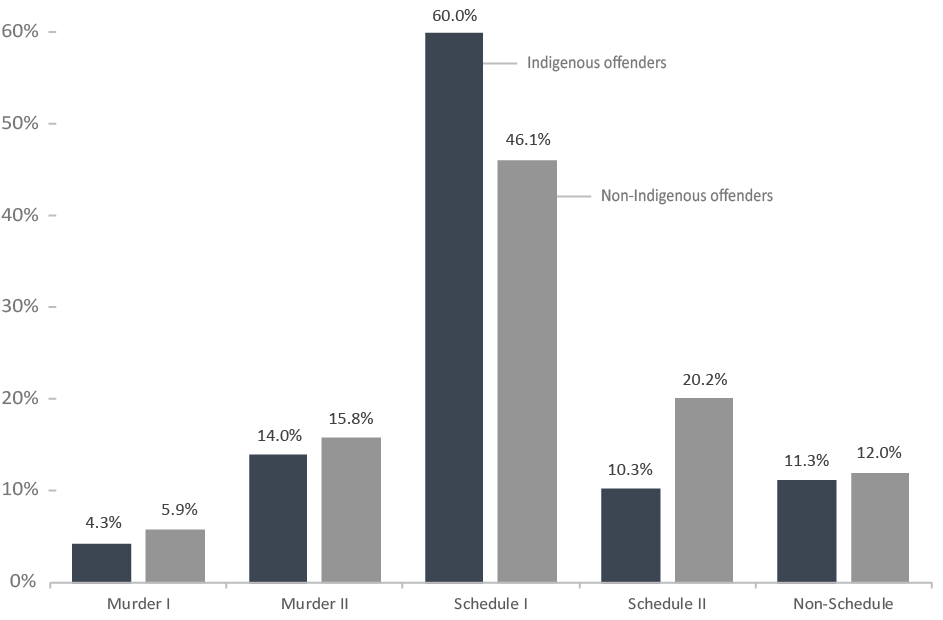
Source: Correctional Service of Canada.
- At the end of fiscal year 2018-19, Indigenous offenders were more likely to be serving a sentence for a violent offence* (78.4% for Indigenous versus 67.8% for non-Indigenous).
- 66.1% of Indigenous women offenders were serving a sentence for a violent offence compared to 45.7% of non-Indigenous women offenders.
- Of those offenders serving a sentence for Murder, 5.0% were women and 22.2% were Indigenous.
- A greater proportion of Indigenous offenders than non-Indigenous offenders were serving a sentence for a Schedule I offence (60.0% versus 46.1%, respectively).
- 10.3% of Indigenous offenders were serving a sentence for a Schedule II offence compared to 20.2% of non-Indigenous offenders.
- 30.9% of women were serving a sentence for a Schedule II offence compared to 16.8% for men.
Notes:
*Violent offences include Murder I, Murder II, and Schedule I offences.
Schedule I is comprised of sexual offences and other violent crimes excluding first and second degree murder (see the Corrections and Conditional Release Act).
Schedule II is comprised of serious drug offences or conspiracy to commit serious drug offences (see the Corrections and Conditional Release Act).
In cases where the offender is serving a sentence for more than one offence, the data reflect the most serious offence.
Total Offender Population includes all active offenders, who are incarcerated in a CSC facility, offenders on temporary absence from a CSC facility, offenders who are temporarily detained, offenders who are actively supervised, and offenders who are unlawfully at large for less than 90 days.
Offence Category |
Indigenous |
Non-Indigenous |
Total |
|||||||||
|---|---|---|---|---|---|---|---|---|---|---|---|---|
Women |
Men |
Total |
Women |
Men |
Total |
Women |
Men |
Total |
||||
Murder I |
8 |
247 |
255 |
48 |
984 |
1,032 |
56 |
1,231 |
1,287 |
|||
% |
1.6 |
4.6 |
4.3 |
5.1 |
5.9 |
5.9 |
3.9 |
5.6 |
5.5 |
|||
Murder II |
68 |
762 |
830 |
118 |
2,650 |
2,768 |
186 |
3,412 |
3,598 |
|||
% |
13.9 |
14.0 |
14.0 |
12.5 |
16.0 |
15.8 |
13.0 |
15.5 |
15.3 |
|||
Schedule I |
247 |
3,303 |
3,550 |
265 |
7,831 |
8,096 |
512 |
11,134 |
11,646 |
|||
% |
50.5 |
60.9 |
60.0 |
28.1 |
47.2 |
46.1 |
35.8 |
50.5 |
49.6 |
|||
Schedule II |
104 |
508 |
612 |
338 |
3,204 |
3,542 |
442 |
3,712 |
4,154 |
|||
% |
21.3 |
9.4 |
10.3 |
35.8 |
19.3 |
20.2 |
30.9 |
16.8 |
17.7 |
|||
Non-Schedule |
62 |
605 |
667 |
174 |
1,938 |
2,112 |
236 |
2,543 |
2,779 |
|||
% |
12.7 |
11.2 |
11.3 |
18.5 |
11.7 |
12.0 |
16.5 |
11.5 |
11.8 |
|||
Total |
489 |
5,425 |
5,914 |
943 |
16,607 |
17,550 |
1,432 |
22,032 |
23,464 |
|||
Source: Correctional Service Canada.
Notes:
Schedule I is comprised of sexual offences and other violent crimes excluding first and second degree murder (see the Corrections and Conditional Release Act).
Schedule II is comprised of serious drug offences or conspiracy to commit serious drug offences (see the Corrections and Conditional Release Act).
In cases where the offender is serving a sentence for more than one offence, the data reflect the most serious offence.
Total Offender Population includes all active offenders, who are incarcerated in a CSC facility, offenders on temporary absence from a CSC facility, offenders who are temporarily detained, offenders who are actively supervised, and offenders who are unlawfully at large for less than 90 days.
The number of Indigenous offenders has increased
Figure C16
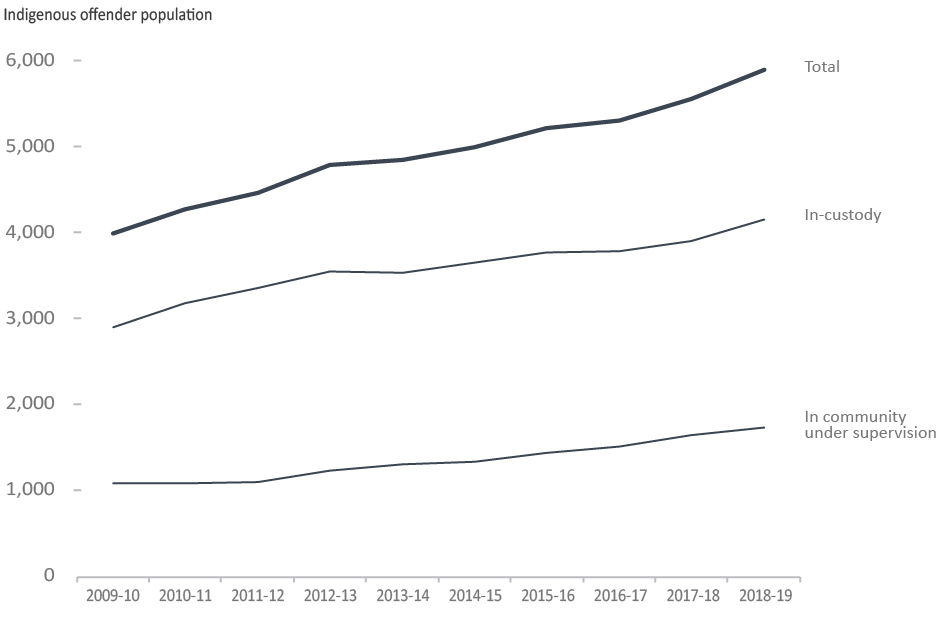
Source: Correctional Service of Canada.
- From 2009-10 to 2018-19, the in-custody Indigenous offender population increased by 42.9%, while the total Indigenous offender population increased 47.4% over the same period of time.
- The number of in-custody Indigenous women offenders increased steadily from 169 in 2009-10 to 291 in 2018-19, an increase of 72.2%. The increase for in-custody Indigenous men offenders was 41.1% for the same period, increasing from 2,747 to 3,877.
- From 2009-10 to 2018-19, the number of Indigenous offenders on community supervision increased 59.5%, from 1,095 to 1,746. The Indigenous community population accounted for 18.7% of the total community population in 2018-19.
Notes:
In-custody includes all active offenders incarcerated in a CSC facility, offenders on temporary absence from a CSC facility, offenders who are temporarily detained in a CSC facility and offenders on remand in a CSC facility.
In Community Under Supervision includes all active offenders on day parole, full parole, statutory release, or in the community supervised on a long-term supervision order, offenders who are temporarily detained in a non-CSC facility, offenders who are unlawfully at large for less than 90 days, offenders on remand in a non-CSC facility, and offenders supervised and subject to an immigration hold by Canada Border Services Agency.
Indigenous Offenders |
Fiscal Year |
|||||||||||
|---|---|---|---|---|---|---|---|---|---|---|---|---|
2014-15 |
2015-16 |
2016-17 |
2017-18 |
2018-19 |
||||||||
In-Custody |
||||||||||||
Atlantic Region |
Men |
174 |
157 |
175 |
184 |
224 |
||||||
Women |
11 |
12 |
8 |
14 |
19 |
|||||||
Quebec Region |
Men |
443 |
425 |
384 |
392 |
449 |
||||||
Women |
19 |
24 |
14 |
11 |
16 |
|||||||
Ontario Region |
Men |
441 |
453 |
487 |
534 |
558 |
||||||
Women |
34 |
39 |
37 |
43 |
50 |
|||||||
Prairie Region |
Men |
1,757 |
1,868 |
1,861 |
1,879 |
1,955 |
||||||
Women |
139 |
133 |
155 |
163 |
158 |
|||||||
Pacific Region |
Men |
602 |
629 |
638 |
658 |
691 |
||||||
Women |
37 |
43 |
39 |
39 |
48 |
|||||||
National Total |
Men |
3,417 |
3,532 |
3,545 |
3,647 |
3,877 |
||||||
Women |
240 |
251 |
253 |
270 |
291 |
|||||||
Total |
3,657 |
3,783 |
3,798 |
3,917 |
4,168 |
|||||||
In Community Under Supervision |
||||||||||||
Atlantic Region |
Men |
60 |
68 |
71 |
88 |
83 |
||||||
Women |
12 |
10 |
11 |
9 |
10 |
|||||||
Quebec Region |
Men |
158 |
185 |
185 |
181 |
162 |
||||||
Women |
12 |
18 |
10 |
6 |
9 |
|||||||
Ontario Region |
Men |
178 |
204 |
201 |
231 |
239 |
||||||
Women |
21 |
24 |
31 |
29 |
31 |
|||||||
Prairie Region |
Men |
574 |
560 |
604 |
645 |
720 |
||||||
Women |
52 |
77 |
78 |
111 |
113 |
|||||||
Pacific Region |
Men |
268 |
276 |
301 |
319 |
344 |
||||||
Women |
17 |
22 |
32 |
36 |
35 |
|||||||
National Total |
Men |
1,238 |
1,293 |
1,362 |
1,464 |
1,548 |
||||||
Women |
114 |
151 |
162 |
191 |
198 |
|||||||
Total |
1,352 |
1,444 |
1,524 |
1,655 |
1,746 |
|||||||
Total In-Custody & In Community Under Supervision |
5,009 |
5,227 |
5,322 |
5,572 |
5,914 |
|||||||
Source: Correctional Service Canada.
Notes:
In-custody population includes all active offenders incarcerated in a CSC facility, offenders on temporary absence from a CSC facility, offenders who are temporarily detained in a CSC facility and offenders on remand in a CSC facility.
In Community Under Supervision includes all active offenders on day parole, full parole, statutory release, or in the community supervised on a long-term supervision order, offenders who are temporarily detained in a non-CSC facility, offenders who are unlawfully at large for less than 90 days, offenders on remand in a non-CSC facility, and offenders supervised and subject to an immigration hold by Canada Border Services Agency.
Regional statistics for the Correctional Service of Canada account for data relating to the northern territories in the following manner: data for Nunavut are reported in the Ontario Region, data for the Northwest Territories are reported in the Prairies Region, and data for the Yukon Territories are reported in the Pacific Region.
The total number of offenders admitted to administrative segregation has increased
Figure C17
Number of admissions to administrative segregation (2018-19)
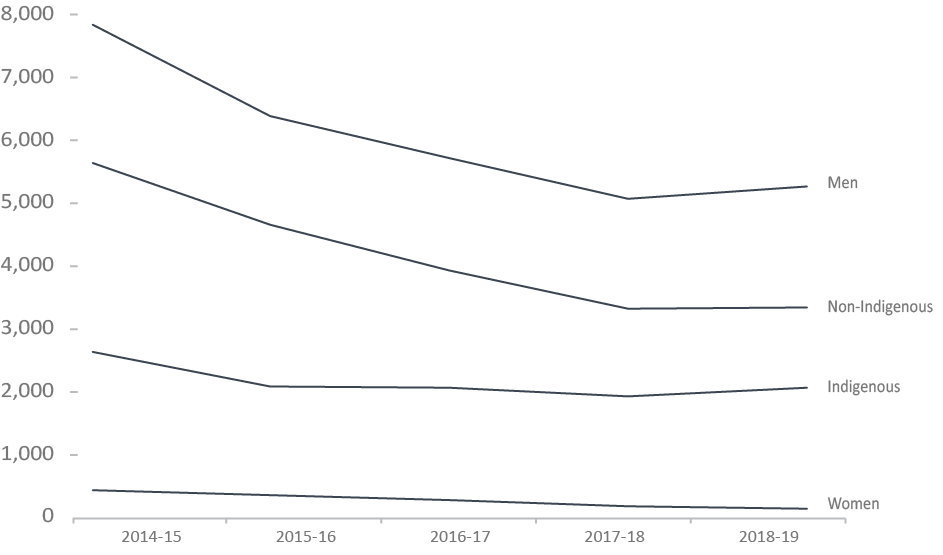
Source: Correctional Service of Canada.
- In 2018-19, the total admissions to administrative segregation increased 2.8% from 5,295 in 2017-18 to 5,441 In 2018-19. In 2018-19, 97.1% of the total admissions were men, and admissions of Indigenous offenders accounted for 38.3%.
- At the end of fiscal year 2018-19, there were 330 offenders in administrative segregation, all were men. A total of 136 Indigenous offenders were in administrative segregation.
Notes:
These reports count admissions, not offenders. Offenders admitted multiple times to segregation are counted once for each admission. Offenders segregated under paragraph (f), subsection 44(1) of the Corrections and Conditional Release Act (Disciplinary Segregation) are not included.
Administrative segregation is the separation, when specific legal requirements are met, of an inmate from the general population, other than pursuant to a disciplinary decision. As per subsection 33(3) of the Corrections and Conditional Release Act: 31(3) The institutional head may order that an inmate be confined in administrative segregation if the institutional head is satisfied that there is no reasonable alternative to administrative segregation and he or she believes on reasonable grounds that (a) the inmate has acted, has attempted to act or intends to act in a manner that jeopardizes the security of the penitentiary or the safety of any person and allowing the inmate to associate with other inmates would jeopardize the security of the penitentiary or the safety of any person; (b) allowing the inmate to associate with other inmates would interfere with an investigation that could lead to a criminal charge or a charge under subsection 41(2) of a serious disciplinary offence; or (c) allowing the inmate to associate with other inmates would jeopardize the inmate's safety.
Year and Type of Administrative Segregation |
By Gender |
By Race |
||||||
|---|---|---|---|---|---|---|---|---|
Women |
Men |
Total |
Indigenous |
Non-Indigenous |
Total |
|||
2014-15 |
||||||||
CCRA 31(3-A) Involuntary |
425 |
5,290 |
5,715 |
1,736 |
3,979 |
5,715 |
||
CCRA 31(3-B) |
7 |
329 |
336 |
108 |
228 |
336 |
||
CCRA 31(3-C) |
27 |
2,242 |
2,269 |
805 |
1,464 |
2,269 |
||
Total |
459 |
7,861 |
8,320 |
2,649 |
5,671 |
8,320 |
||
2015-16 |
||||||||
CCRA 31(3-A) Involuntary |
342 |
4,200 |
4,542 |
1,360 |
3,182 |
4,542 |
||
CCRA 31(3-B) |
2 |
235 |
237 |
92 |
145 |
237 |
||
CCRA 31(3-C) |
33 |
1,976 |
2,009 |
656 |
1,353 |
2,009 |
||
Total |
377 |
6,411 |
6,788 |
2,108 |
4,680 |
6,788 |
||
2016-17 |
||||||||
CCRA 31(3-A) Involuntary |
270 |
3,826 |
4,096 |
1,373 |
2,723 |
4,096 |
||
CCRA 31(3-B) |
3 |
273 |
276 |
75 |
201 |
276 |
||
CCRA 31(3-C) |
16 |
1,649 |
1,665 |
639 |
1,026 |
1,665 |
||
Total |
289 |
5,748 |
6,037 |
2,087 |
3,950 |
6,037 |
||
2017-18 |
||||||||
CCRA 31(3-A) Involuntary |
179 |
3,167 |
3,346 |
1,179 |
2,167 |
3,346 |
||
CCRA 31(3-B) |
10 |
229 |
239 |
79 |
160 |
239 |
||
CCRA 31(3-C) |
12 |
1,698 |
1,710 |
694 |
1,016 |
1,710 |
||
Total |
201 |
5,094 |
5,295 |
1,952 |
3,343 |
5,295 |
||
2018-19 |
||||||||
CCRA 31(3-A) Involuntary |
134 |
3,011 |
3,145 |
1,155 |
1,990 |
3,145 |
||
CCRA 31(3-B) |
5 |
162 |
167 |
49 |
118 |
167 |
||
CCRA 31(3-C) |
18 |
2,111 |
2,129 |
881 |
1,248 |
2,129 |
||
Total |
157 |
5,284 |
5,441 |
2,085 |
3,356 |
5,441 |
||
Source: Correctional Service Canada.
Notes:
These reports count admissions, not offenders. Offenders admitted multiple times to segregation are counted once for each admission. Offenders segregated under paragraph (f), subsection 44(1) of the Corrections and Conditional Release Act (Disciplinary Segregation) are not included.
Administrative segregation is the separation, when specific legal requirements are met, of an inmate from the general population, other than pursuant to a disciplinary decision. As per subsection 33(3) of the Corrections and Conditional Release Act: 31(3) The institutional head may order that an inmate be confined in administrative segregation if the institutional head is satisfied that there is no reasonable alternative to administrative segregation and he or she believes on reasonable grounds that (a) the inmate has acted, has attempted to act or intends to act in a manner that jeopardizes the security of the penitentiary or the safety of any person and allowing the inmate to associate with other inmates would jeopardize the security of the penitentiary or the safety of any person; (b) allowing the inmate to associate with other inmates would interfere with an investigation that could lead to a criminal charge or a charge under subsection 41(2) of a serious disciplinary offence; or (c) allowing the inmate to associate with other inmates would jeopardize the inmate's safety.
75% of offenders admitted to administrative segregation stay for less than 30 days
Figure C18
Number of federal offenders admitted to administrative segregation (2018-19)
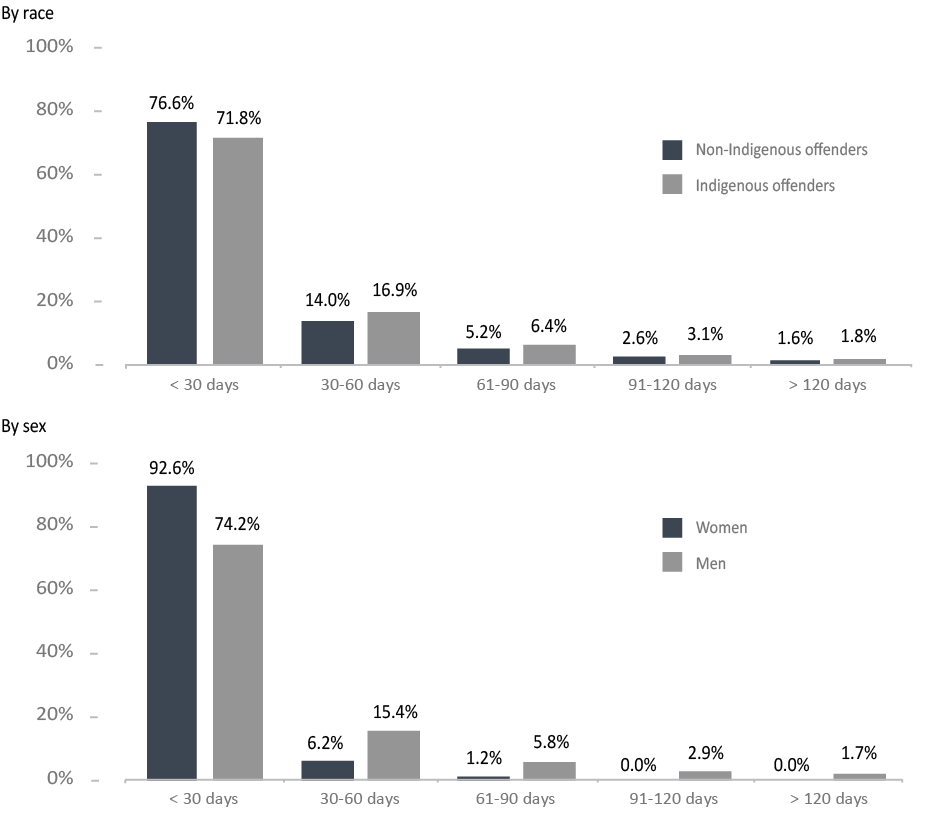
Source: Correctional Service Canada.
- Most (74.7%) placements in administrative segregation ended in less than 30 days, and 15.1% lasted between 30 and 60 days. 1.7% of placements in administrative segregation ended after more than 120 days.
- 92.6% of placements of women in administrative segregation ended in less than 30 days.
- The number of admissions to administrative segregation that resulted in placements lasting more than 120 days in administrative segregation was 1.8% for Indigenous and 1.6% for non-Indigenous offenders.
Notes:
These reports count admissions, not offenders. Offenders admitted multiple times to segregation are counted once for each admission. Offenders segregated under paragraph (f), subsection 44(1) of the Corrections and Conditional Release Act (Disciplinary Segregation) are not included.
Administrative segregation is the involuntary or voluntary separation, when specific legal requirements are met, of an inmate from the general population, other than pursuant to a disciplinary decision. As per subsection 31(3) of the Corrections and Conditional Release Act: The institutional head may order that an inmate be confined in administrative segregation if the institutional head is satisfied that there is no reasonable alternative to administrative segregation and he or she believes on reasonable grounds that (a) the inmate has acted, has attempted to act or intends to act in a manner that jeopardizes the security of the penitentiary or the safety of any person and allowing the inmate to associate with other inmates would jeopardize the security of the penitentiary or the safety of any person; (b) allowing the inmate to associate with other inmates would interfere with an investigation that could lead to a criminal charge or a charge under subsection 41(2) of a serious disciplinary offence; or (c) allowing the inmate to associate with other inmates would jeopardize the inmate's safety.
Length of Stay in Administrative Segregation |
By Gender |
By Race |
Total |
||||||||||
|---|---|---|---|---|---|---|---|---|---|---|---|---|---|
Women |
Men |
Indigenous |
Non- Indigenous |
||||||||||
# |
% |
# |
% |
# |
% |
# |
% |
# |
% |
||||
2018-19 |
|||||||||||||
< 30 days |
150 |
92.6 |
3,901 |
74.2 |
1,497 |
71.8 |
2,554 |
76.6 |
4,051 |
74.7 |
|||
30-60 days |
10 |
6.2 |
810 |
15.4 |
353 |
16.9 |
467 |
14 |
820 |
15.1 |
|||
61-90 days |
2 |
1.2 |
305 |
5.8 |
134 |
6.4 |
173 |
5.2 |
307 |
5.7 |
|||
91-120 days |
0 |
0 |
151 |
2.9 |
64 |
3.1 |
87 |
2.6 |
151 |
2.8 |
|||
> 120 days |
0 |
0 |
92 |
1.7 |
38 |
1.8 |
54 |
1.6 |
92 |
1.7 |
|||
Total |
162 |
100.0 |
5,259 |
100.0 |
2,086 |
100.0 |
3,335 |
100.0 |
5,421 |
100.0 |
|||
Source: Correctional Service Canada.
Notes:
These reports count admissions, not offenders. Offenders admitted multiple times to segregation are counted once for each admission. Offenders segregated under paragraph (f), subsection 44(1) of the Corrections and Conditional Release Act (Disciplinary Segregation) are not included.
Administrative segregation is the involuntary or voluntary separation, when specific legal requirements are met, of an inmate from the general population, other than pursuant to a disciplinary decision. As per subsection 31(3) of the Corrections and Conditional Release Act: The institutional head may order that an inmate be confined in administrative segregation if the institutional head is satisfied that there is no reasonable alternative to administrative segregation and he or she believes on reasonable grounds that (a) the inmate has acted, has attempted to act or intends to act in a manner that jeopardizes the security of the penitentiary or the safety of any person and allowing the inmate to associate with other inmates would jeopardize the security of the penitentiary or the safety of any person; (b) allowing the inmate to associate with other inmates would interfere with an investigation that could lead to a criminal charge or a charge under subsection 41(2) of a serious disciplinary offence; or (c) allowing the inmate to associate with other inmates would jeopardize the inmate's safety.
The number of offender deaths while in custody has increased
Figure C19
The number of deaths in federal and provincial/territorial custody by cause of death
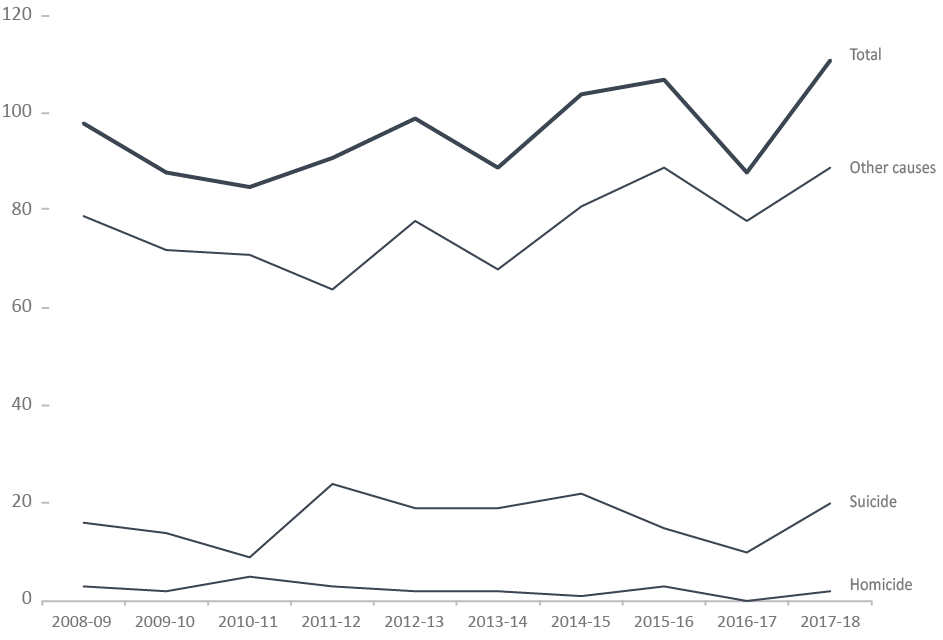
Source: Adult Correctional Services Survey, Canadian Centre for Justice and Community Safety Statistics, Statistics Canada.
- In the ten-year period from 2008-09 to 2017-18, a total of 554 federal offenders and 406 provincial/territorial offenders died while in custody.
- During this time period, suicides accounted for 14.6% of federal offender deaths and 21.4% of provincial offender deaths. The suicide rate was approximately 55 per 100,000 for incarcerated federal offenders, and approximately 36 per 100,000 for incarcerated provincial offenders.* These rates are significantly higher than the 2009 rate of 11.5 suicides per 100,000 people in Canada.
- Between 2008-09 and 2017-18, 3.4% of federal offender deaths and 1.0% of provincial offender deaths were due to homicide. The homicide rate for incarcerated federal offenders was approximately 13.0 per 100,000 and 1.6 per 100,000 for incarcerated provincial offenders.* The federal rate is significantly higher than the national homicide rate of 1.8 per 100,000 people in 2018.
Notes:
Other causes of death include: natural causes, accidental deaths, death as a result of a legal intervention, other causes of death and where cause of death was unknown. Data for Alberta for 2013-14 and onward are now available.
*For the calculation of rates, the total actual in-count numbers between 2008-09 and 2017-18 was used as the denominator.
The data on cause of death are subject to change following an official review or investigation, and should be used/interpreted with caution. The data presented were provided by the Canadian Centre for Justice and Community Safety Statistics at Statistics Canada, and may not reflect the outcome of recent reviews or investigations or cause of death.
Year |
Type of Death |
|||||||
|---|---|---|---|---|---|---|---|---|
Homicide |
Suicide |
Other* |
Total |
|||||
Federal |
# |
% |
# |
% |
# |
% |
# |
|
2008/2009 |
2 |
3.1 |
9 |
13.8 |
54 |
83.1 |
65 |
|
2009/2010 |
1 |
2.0 |
9 |
18.4 |
39 |
79.6 |
49 |
|
2010/2011 |
5 |
10.0 |
4 |
8.0 |
41 |
82.0 |
50 |
|
2011/2012 |
3 |
5.7 |
8 |
15.1 |
42 |
79.2 |
53 |
|
2012/2013 |
1 |
1.8 |
11 |
20.0 |
43 |
78.2 |
55 |
|
2013/2014 |
1 |
2.1 |
9 |
18.8 |
38 |
79.2 |
48 |
|
2014/2015 |
1 |
1.5 |
13 |
19.4 |
53 |
79.1 |
67 |
|
2015/2016 |
3 |
4.6 |
9 |
13.8 |
53 |
81.5 |
65 |
|
2016/2017 |
0 |
0.0 |
3 |
6.4 |
44 |
93.6 |
47 |
|
2017/2018 |
2 |
3.6 |
6 |
10.9 |
47 |
85.5 |
55 |
|
Total |
19 |
3.4 |
81 |
14.6 |
454 |
81.9 |
554 |
|
Provincial |
||||||||
2008/2009 |
1 |
3.0 |
7 |
21.2 |
25 |
75.8 |
33 |
|
2009/2010 |
1 |
2.6 |
5 |
12.8 |
33 |
84.6 |
39 |
|
2010/2011 |
0 |
0.0 |
5 |
14.3 |
30 |
85.7 |
35 |
|
2011/2012 |
0 |
0.0 |
16 |
42.1 |
22 |
57.9 |
38 |
|
2012/2013 |
1 |
2.3 |
8 |
18.2 |
35 |
79.5 |
44 |
|
2013/2014 |
1 |
2.4 |
10 |
24.4 |
30 |
73.2 |
41 |
|
2014/2015 |
0 |
0.0 |
9 |
24.3 |
28 |
75.7 |
37 |
|
2015/2016 |
0 |
0.0 |
6 |
14.3 |
36 |
85.7 |
42 |
|
2016/2017 |
0 |
0.0 |
7 |
17.1 |
34 |
82.9 |
41 |
|
2017/2018 |
0 |
0.0 |
14 |
25.0 |
42 |
75.0 |
56 |
|
Total |
4 |
1.0 |
87 |
21.4 |
315 |
77.6 |
406 |
|
Total Federal and Provincial Offender Deaths |
23 |
2.4 |
168 |
17.5 |
769 |
80.1 |
960 |
|
Source: Adult Correctional Services Survey, Canadian Centre for Justice and Community Safety Statistics, Statistics Canada.
Notes:
*Other causes of death include: natural causes, accidental deaths, death as a result of a legal intervention, other causes of death and where cause of death was unknown.
Data for Alberta for 2013-14 and onward are now available.
The data on cause of death are subject to change following an official review or investigation, and should be used/interpreted with caution. The data presented were provided by the Canadian Centre for Justice and Community Safety Statistics at Statistics Canada and may not reflect the outcome of recent reviews or investigations on cause of death.
The number of escapees has decreased
Figure C20
Number of escapees from federal institutions
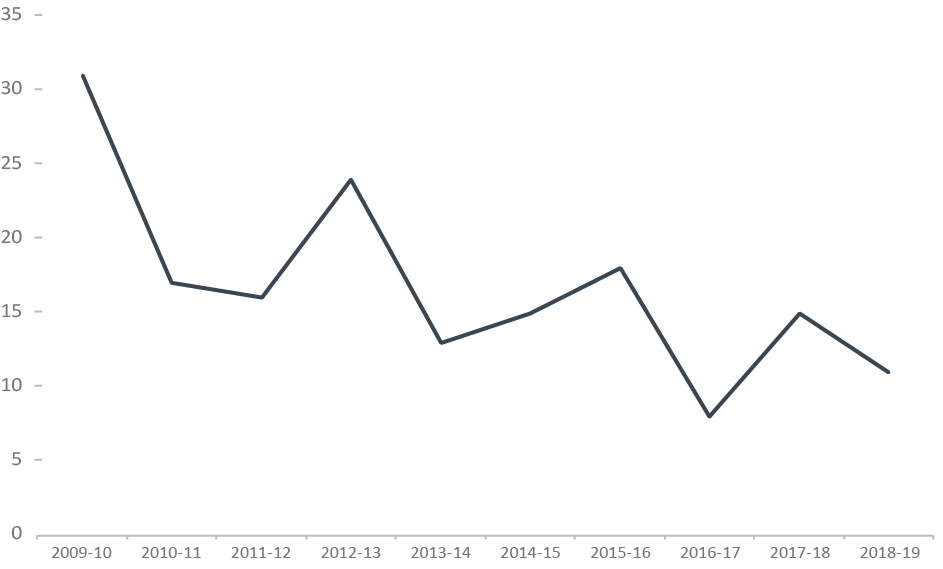
Source: Correctional Service of Canada.
- In 2018-19, there were 11 escape incidents involving a total of 11 offenders. Of these 11 offenders, 9 offenders were recaptured.
- Offenders who escaped from federal institutions in 2018-19 represented 0.1% of the in-custody population.
Notes:
The data represent the number of escape incidents from federal facilities during each fiscal year. An escape can involve more than one offender. These numbers are subject to change further to new information becoming available. A fiscal year runs from April 1 to March 31 of the following year.
Escapes |
2014-15 |
2015-16 |
2016-17 |
2017-18 |
2018-19 |
|
|---|---|---|---|---|---|---|
Total Number of Escape Incidents |
14 |
15 |
8 |
11 |
11 |
|
Total Number of Escapees |
15 |
18 |
8 |
15 |
11 |
Source: Correctional Service of Canada.
Notes:
The data represent the number of escape incidents from federal facilities during each fiscal year. An escape can involve more than one offender. These numbers are subject to change further to new information becoming available. A fiscal year runs from April 1 to March 31 of the following year.
The population of offenders in the community under supervision has increased
Figure C21
In community under supervision population at fiscal year* end
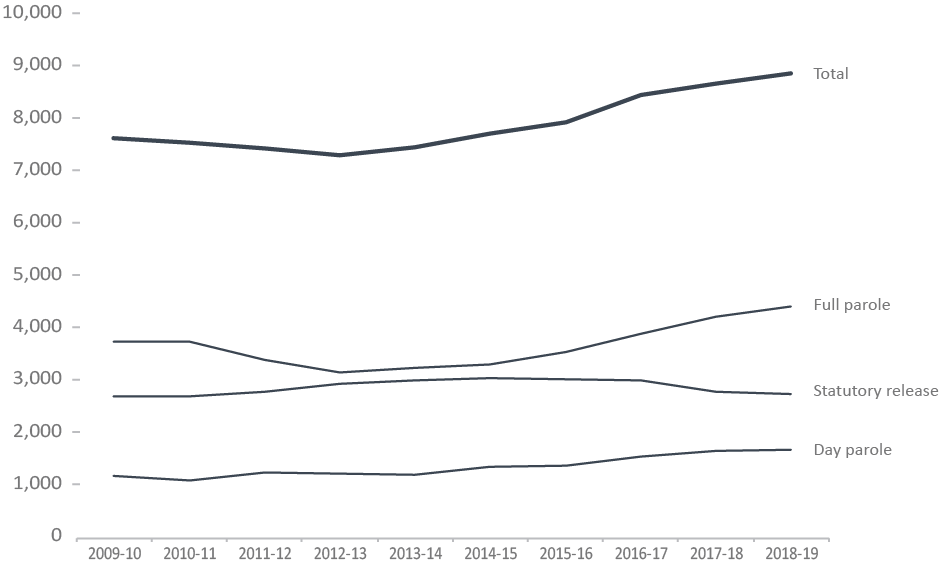
Source: Correctional Service of Canada.
- Over the past five years, the total offender population supervised in the community increased by 15.1%. For the same period, the total number of offenders on full parole increased by 34.0% while the proportion of offenders on statutory release decreased by 10.0%.
- At the end of fiscal year 2018-19, there were 8,154 men and 721 women on active community supervision.
Notes:
*These cases reflect the number of offenders on active supervision at fiscal year-end. A fiscal year runs from April 1 to March 31 of the following year.
The data reflect the offender population in the community under supervision which includes all active offenders on day parole, full parole, statutory release, offenders who are temporarily detained in a non-CSC facility, offenders who are unlawfully at large for less than 90 days, offenders on remand in a non-CSC facility, and offenders supervised and subject to an immigration hold by Canada Border Services Agency.
** The data presented above do not include offenders who were on long-term supervision orders (See Figure/Table E4).
Day parole is a type of conditional release granted by the Parole Board of Canada whereby offenders are permitted to participate in community-based activities in preparation for full parole or statutory release. The conditions require offenders to return nightly to an institution or half-way house unless otherwise authorized by the Parole Board of Canada. Full parole is a type of conditional release granted by the Parole Board of Canada whereby the remainder of the sentence is served under supervision in the community. Statutory release refers to a conditional release that is subject to supervision after the offender has served two-thirds of the sentence.
Year |
Supervision Type of Offenders |
|||||||||||||
|---|---|---|---|---|---|---|---|---|---|---|---|---|---|---|
Day Parole |
Full Parole |
Statutory Release |
Totals |
% change* |
||||||||||
Women |
Men |
Women |
Men |
Women |
Men |
Women |
Men |
Both |
Both |
|||||
2009-10 |
108 |
1,083 |
328 |
3,418 |
93 |
2,602 |
529 |
7,103 |
7,632 |
|||||
2010-11 |
79 |
1,017 |
314 |
3,441 |
109 |
2,598 |
502 |
7,056 |
7,558 |
-1.0 |
||||
2011-12 |
123 |
1,123 |
257 |
3,154 |
127 |
2,661 |
507 |
6,938 |
7,445 |
-1.5 |
||||
2012-13 |
116 |
1,106 |
225 |
2,932 |
136 |
2,801 |
477 |
6,839 |
7,316 |
-1.7 |
||||
2013-14 |
106 |
1,104 |
225 |
3,017 |
153 |
2,858 |
484 |
6,979 |
7,463 |
2.0 |
||||
2014-15 |
115 |
1,236 |
239 |
3,065 |
150 |
2,909 |
504 |
7,210 |
7,714 |
3.4 |
||||
2015-16 |
124 |
1,248 |
273 |
3,276 |
177 |
2,849 |
574 |
7,373 |
7,947 |
3.0 |
||||
2016-17 |
158 |
1,392 |
316 |
3,587 |
154 |
2,856 |
628 |
7,835 |
8,463 |
6.5 |
||||
2017-18 |
197 |
1,462 |
369 |
3,864 |
145 |
2,644 |
711 |
7,970 |
8,681 |
2.6 |
||||
2018-19 |
192 |
1,500 |
370 |
4,059 |
159 |
2,595 |
721 |
8,154 |
8,875 |
2.2 |
||||
Source: Correctional Service of Canada.
Notes:
These cases reflect the number of offenders on active supervision at fiscal year-end. A fiscal year runs from April 1 to March 31 of the following year.
The data reflect the offender population in the community under supervision which includes all active offenders on day parole, full parole, statutory release, offenders who are temporarily detained in a non-CSC facility, offenders who are unlawfully at large for less than 90 days, offenders on remand in a non-CSC facility, and offenders supervised and subject to an immigration hold by Canada Border Services Agency.
The data presented above do not include offenders who were on long-term supervision orders (See Figure/Table E4).
Day parole is a type of conditional release granted by the Parole Board of Canada whereby offenders are permitted to participate in community-based activities in preparation for full parole or statutory release. The conditions require offenders to return nightly to an institution or half-way house unless otherwise authorized by the Parole Board of Canada. Full parole is a type of conditional release granted by the Parole Board of Canada whereby the remainder of the sentence is served under supervision in the community. Statutory release refers to a conditional release that is subject to supervision after the offender has served two-thirds of the sentence.
*Percent change is measured from the previous year.
The provincial/territorial community corrections population has remained stable
Figure C22
Average monthly offender counts
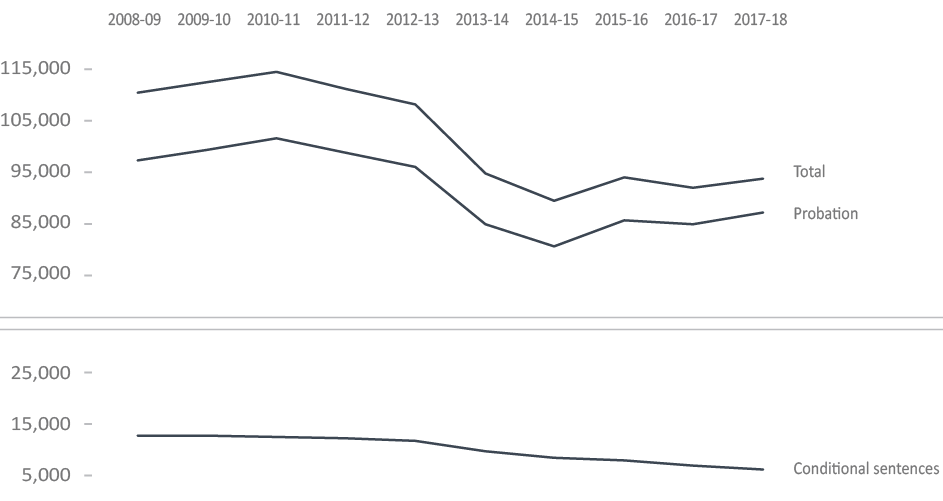
Source: Table 35-10-0154-01, Corrections Key Indicator Report for Adults and Youth, Canadian Centre for Justice and Community Safety Statistics, Statistics Canada.
- Since 2015-16, the provincial/territorial community corrections population has remained stable. In 2017-18, there was a slight increase (1.8%) from 92,227 in 2016-17 to 93,871 in 2017-18.
- Since 2008-09, there has been a gradual decrease (15.2%) in the provincial/territorial community corrections population, down from 110,653 in 2008-09 to 93,871 in 2017-18.
- There has been a gradual decline in the number of offenders on conditional sentence orders over the past decade. It has decreased 50.3% from 13,124 in 2008-09 to 6,529 in 2017-18.
Note:
A conditional sentence is a disposition of the court where the offender serves a term of imprisonment in the community under specified conditions. This type of sentence can only be imposed in cases where the term of imprisonment would be less than two years. Conditional sentences have been a provincial and territorial sentencing option since September 1996.
Year |
Average Monthly Offender Counts on Probation |
Average Monthly Offender Counts on Conditional Sentence |
Total |
|||
|---|---|---|---|---|---|---|
2008-09 |
97,529 |
13,124 |
110,653 |
|||
2009-10 |
99,498 |
13,105 |
112,603 |
|||
2010-11 |
101,825 |
12,969 |
114,794 |
|||
2011-12 |
98,843 |
12,616 |
111,459 |
|||
2012-13 |
96,116 |
12,202 |
108,318 |
|||
2013-14 |
84,905 |
10,077 |
94,982 |
|||
2014-15 |
80,705 |
8,746 |
89,451 |
|||
2015-16 |
85,845 |
8,259 |
94,104 |
|||
2016-17 |
84,978 |
7,249 |
92,227 |
|||
2017-18 |
87,342 |
6,529 |
93,871 |
Source: Table 35-10-0154-01, Corrections Key Indicator Report for Adults and Youth, Canadian Centre for Justice and Community Safety Statistics, Statistics Canada.
Note:
A conditional sentence is a disposition of the court where the offender serves a term of imprisonment in the community under specified conditions. This type of sentence can only be imposed in cases where the term of imprisonment would be less than two years. Conditional sentences have been a provincial and territorial sentencing option since September 1996.
The number of offenders on provincial parole increased
Figure C23
Average monthly count of offenders on provincial parole
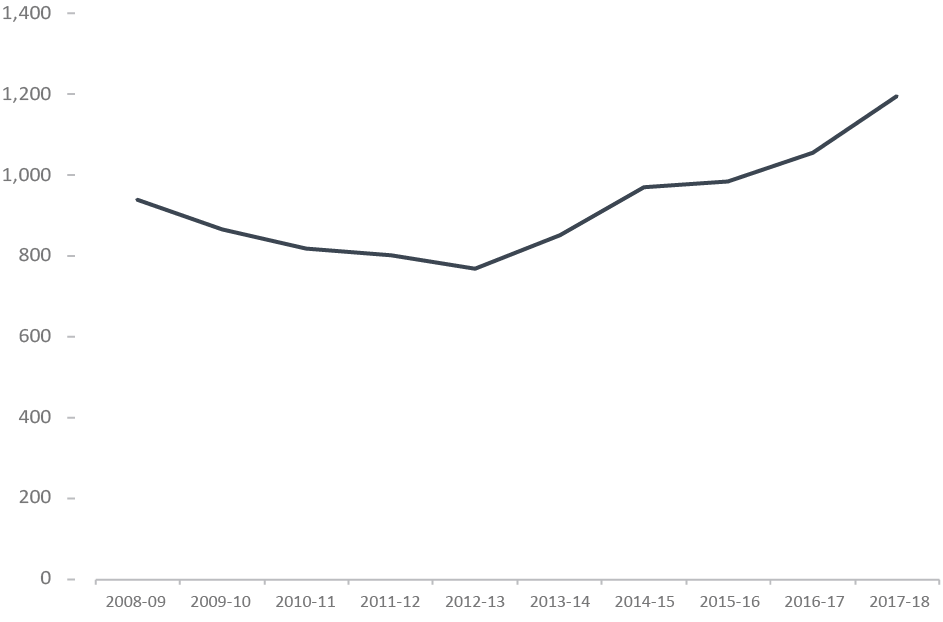
Source: Table 35-10-0154-01, Corrections Key Indicator Report for Adults and Youth, Canadian Centre for Justice and Community Safety Statistics, Statistics Canada.
- The number of offenders on provincial parole increased by 13.1% from 1,058 offenders in 2016-17 to 1,197 in 2017-18.
- Since 2014-15, there has been a 23.1% increase in the number of offenders on provincial parole, up from 972 in 2014-15 to 1,197 in 2017-18.
Note:
Provincial parole boards operate in Quebec and Ontario. On April 1, 2007, the Parole Board of Canada assumed responsibility for parole decisions relating to offenders serving sentences in British Columbia's provincial correctional facilities. The Parole Board of Canada has jurisdiction over granting parole to provincial offenders in the Atlantic and Prairie provinces, British Columbia, and to territorial offenders in Yukon, Nunavut and the Northwest Territories.
Year |
Average Monthly Counts on Provincial Parole |
||||||||
|---|---|---|---|---|---|---|---|---|---|
Provincial Boards |
Parole Board of Canada** |
Total |
% Change |
||||||
Quebec |
Ontario |
British Columbia* |
Total |
||||||
2008-09 |
533 |
217 |
n/a |
750 |
190 |
940 |
|||
2009-10 |
506 |
194 |
n/a |
700 |
168 |
868 |
-7.7 |
||
2010-11 |
482 |
171 |
n/a |
653 |
167 |
820 |
-5.5 |
||
2011-12 |
481 |
179 |
n/a |
660 |
144 |
804 |
-2.0 |
||
2012-13 |
462 |
164 |
n/a |
626 |
143 |
769 |
-4.4 |
||
2013-14 |
527 |
172 |
n/a |
699 |
154 |
853 |
10.9 |
||
2014-15 |
612 |
207 |
n/a |
821 |
151 |
972 |
14.0 |
||
2015-16 |
639 |
207 |
n/a |
846 |
139 |
985 |
1.5 |
||
2016-17 |
701 |
205 |
n/a |
907 |
151 |
1,058 |
7.4 |
||
2017-18 |
792 |
242 |
n/a |
1,034 |
163 |
1,197 |
13.2 |
||
Source: Table 35-10-0154-01, Corrections Key Indicator Report for Adults and Youth, Canadian Centre for Justice and Community Safety Statistics, Statistics Canada.
Notes:
*On April 1, 2007, the Parole Board of Canada assumed responsibility for parole decisions relating to offenders serving sentences in British Columbia's provincial correctional facilities.
**The data represent the number of provincial offenders who are released from custody on the authority of the Parole Board of Canada and supervised by the Correctional Service of Canada.
Provincial parole boards operate in Quebec and Ontario. The Parole Board of Canada has jurisdiction over granting parole to provincial offenders in the Atlantic and Prairie provinces, British Columbia, and to territorial offenders in Yukon, Nunavut and the Northwest Territories.
Section D. Conditional Release
The percentage of offenders released from a federal institution or Healing Lodge at statutory release has decreased
Figure D1
Percentage of offenders released on statutory release*
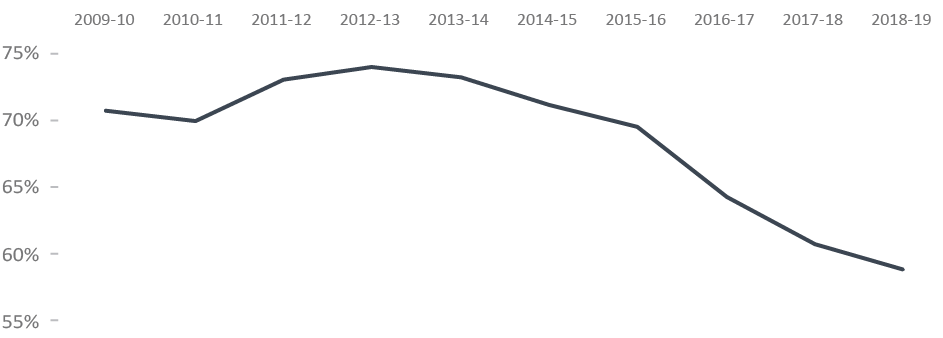
Source: Correctional Service of Canada.
- In fiscal year 2018-19, 59.1% of all releases from federal institutions were at statutory release.
- In fiscal year 2018-19, 70.9% of releases for Indigenous offenders were at statutory release compared to 54.4% of releases for Non-Indigenous offenders.
- Over the past ten years, the percentage of releases at statutory release decreased from 70.9% to 59.1%.
Notes:
*Percentage is calculated based on the number of statutory releases compared to the total releases for each offender group.
The data includes all releases from a federal institution or Healing Lodge in a given fiscal year excluding offenders with quashed sentences, offenders who died in custody, LTSO (Long-Term Supervision Orders) releases, offenders released at warrant expiry and offenders transferred to foreign countries. An offender may be released more than once a year in cases where a previous release was subject to revocation, suspension, temporary detention, or interruption.
Statutory release refers to a conditional release that is subject to supervision after the offender has served two-thirds of the sentence.
A fiscal year runs from April 1 to March 31 of the following year.
Year |
Indigenous |
Non-Indigenous |
Total Offender Population |
|||||||||
|---|---|---|---|---|---|---|---|---|---|---|---|---|
Statutory Release |
Total Releases |
%* |
Statutory Release |
Total Releases |
%* |
Statutory Release |
Total Releases |
%* |
||||
2009-10 |
1,420 |
1,733 |
81.9 |
4,118 |
6,073 |
67.8 |
5,538 |
7,806 |
70.9 |
|||
2010-11 |
1,341 |
1,604 |
83.6 |
3,739 |
5,642 |
66.3 |
5,080 |
7,246 |
70.1 |
|||
2011-12 |
1,476 |
1,778 |
83.0 |
3,825 |
5,462 |
70.0 |
5,301 |
7,240 |
73.2 |
|||
2012-13 |
1,603 |
1,928 |
83.1 |
3,985 |
5,605 |
71.1 |
5,588 |
7,533 |
74.2 |
|||
2013-14 |
1,709 |
2,009 |
85.1 |
3,927 |
5,672 |
69.2 |
5,636 |
7,681 |
73.4 |
|||
2014-15 |
1,724 |
2,043 |
84.4 |
3,648 |
5,489 |
66.5 |
5,372 |
7,532 |
71.3 |
|||
2015-16 |
1,668 |
2,019 |
82.6 |
3,640 |
5,597 |
65.0 |
5,308 |
7,616 |
69.7 |
|||
2016-17 |
1,578 |
2,025 |
77.9 |
3,305 |
5,551 |
59.5 |
4,883 |
7,576 |
64.5 |
|||
2017-18 |
1,520 |
2,042 |
74.4 |
2,899 |
5,206 |
55.7 |
4,419 |
7,248 |
61.0 |
|||
2018-19 |
1,420 |
2,004 |
70.9 |
2,758 |
5,068 |
54.4 |
4,178 |
7,072 |
59.1 |
|||
Source: Correctional Service of Canada.
Notes:
*Percentage is calculated based on the number of statutory releases compared to the total releases for each offender group.
The data includes all releases from a federal institution or Healing Lodge in a given fiscal year excluding offenders with quashed sentences, offenders who died in custody, LTSO (Long-Term Supervision Orders) releases, offenders released at warrant expiry and offenders transferred to foreign countries. An offender may be released more than once a year in cases where a previous release was subject to revocation, suspension, temporary detention, or interruption.
Statutory release refers to a conditional release that is subject to supervision after the offender has served two-thirds of the sentence.
A fiscal year runs from April 1 to March 31 of the following year.
The percentage of offenders released from a federal institution or Healing Lodge on day parole has increased
Figure D2
Percentage of offenders released*
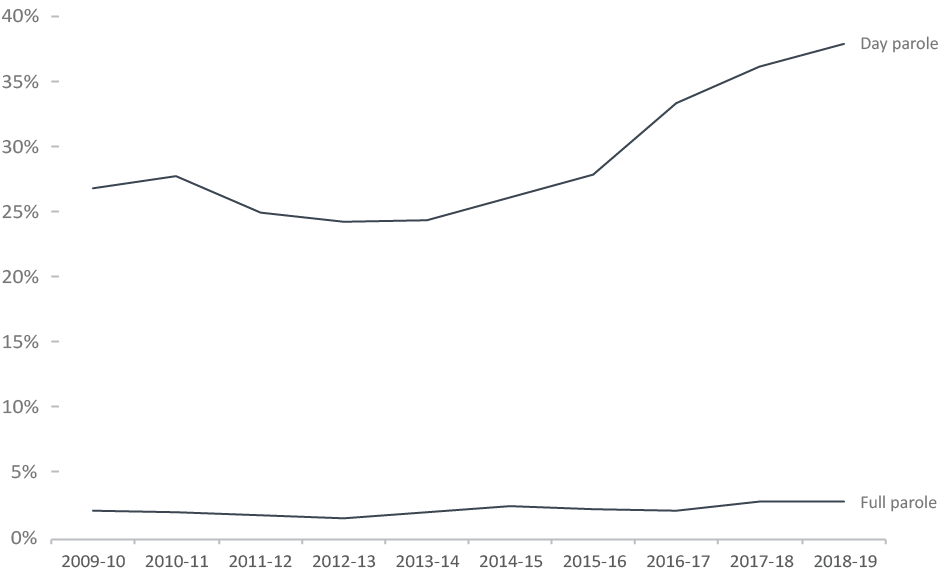
Source: Correctional Service of Canada.
- In fiscal year 2018-19, 38.0% of all releases from federal institutions were on day parole and 2.9% were on full parole.
- In fiscal year 2018-19, 27.4% of releases for Indigenous offenders were on day parole and 1.7% were on full parole compared to 42.2% and 3.4% respectively for Non-Indigenous offenders.
- Over the past ten years, the percentage of releases on day parole increased from 26.9% to 38.0% and the percentage of releases on full parole increased from 2.2% to 2.9%.
Notes:
*Percentage is calculated based on the number of day and full paroles compared to the total releases for each offender group.
The data includes all releases from a federal institution or Healing Lodge in a given fiscal year excluding offenders with quashed sentences, offenders who died in custody, LTSO releases, offenders released at warrant expiry and offenders transferred to foreign countries. An offender may be released more than once a year in cases where a previous release was subject to revocation, suspension, temporary detention, or interruption.
Day parole is a type of conditional release granted by the Parole Board of Canada whereby offenders are permitted to participate in community-based activities in preparation for full parole or statutory release. The conditions require offenders to return nightly to an institution or half-way house unless otherwise authorized by the Parole Board of Canada.
Full parole is a type of conditional release granted by the Parole Board of Canada whereby the remainder of the sentence is served under supervision in the community.
A fiscal year runs from April 1 to March 31 of the following year.
Year |
Indigenous |
Non-Indigenous |
Total Offender Population |
|||||||||
|---|---|---|---|---|---|---|---|---|---|---|---|---|
Day Parole |
Full Parole |
Total Releases |
Day Parole |
Full Parole |
Total Releases |
Day Parole |
Full Parole |
Total Releases |
||||
2009-10 |
# |
301 |
12 |
1,733 |
1,795 |
160 |
6,073 |
2,096 |
172 |
7,806 |
||
% |
17.4 |
0.7 |
29.6 |
2.6 |
26.9 |
2.2 |
||||||
2010-11 |
# |
252 |
11 |
1,604 |
1,766 |
137 |
5,642 |
2,018 |
148 |
7,246 |
||
% |
15.7 |
0.7 |
31.3 |
2.4 |
27.8 |
2.0 |
||||||
2011-12 |
# |
290 |
12 |
1,778 |
1,521 |
116 |
5,462 |
1,811 |
128 |
7,240 |
||
% |
16.3 |
0.7 |
27.8 |
2.1 |
25.0 |
1.8 |
||||||
2012-13 |
# |
318 |
7 |
1,928 |
1,510 |
110 |
5,605 |
1,828 |
117 |
7,533 |
||
% |
16.5 |
0.4 |
26.9 |
2.0 |
24.3 |
1.6 |
||||||
2013-14 |
# |
282 |
18 |
2,009 |
1,600 |
145 |
5,672 |
1,882 |
163 |
7,681 |
||
% |
14.0 |
0.9 |
28.2 |
2.6 |
24.5 |
2.1 |
||||||
2014-15 |
# |
309 |
10 |
2,043 |
1,666 |
175 |
5,489 |
1,975 |
185 |
7,532 |
||
% |
15.1 |
0.5 |
30.4 |
3.2 |
26.2 |
2.5 |
||||||
2015-16 |
# |
337 |
14 |
2,019 |
1,793 |
164 |
5,597 |
2,130 |
178 |
7,616 |
||
% |
16.7 |
0.7 |
32.0 |
2.9 |
28.0 |
2.3 |
||||||
2016-17 |
# |
434 |
13 |
2,025 |
2,093 |
153 |
5,551 |
2,527 |
166 |
7,576 |
||
% |
21.4 |
0.6 |
37.7 |
2.8 |
33.4 |
2.2 |
||||||
2017-18 |
# |
497 |
25 |
2,042 |
2,124 |
183 |
5,206 |
2,621 |
208 |
7,248 |
||
% |
24.3 |
1.2 |
40.8 |
3.5 |
36.2 |
2.9 |
||||||
2018-19 |
# |
549 |
35 |
2,004 |
2,138 |
172 |
5,068 |
2,687 |
207 |
7,072 |
||
% |
27.4 |
1.7 |
42.2 |
3.4 |
38.0 |
2.9 |
||||||
Source: Correctional Service of Canada.
Notes:
The data includes all releases from a federal institution or Healing Lodge in a given fiscal year excluding offenders with quashed sentences, offenders who died in custody, LTSO releases, offenders released at warrant expiry and offenders transferred to foreign countries. An offender may be released more than once a year in cases where a previous release was subject to revocation, suspension, temporary detention, or interruption. Day parole is a type of conditional release granted by the Parole Board of Canada whereby offenders are permitted to participate in community-based activities in preparation for full parole or statutory release. The conditions require offenders to return nightly to an institution or half-way house unless otherwise authorized by the Parole Board of Canada.
Full parole is a type of conditional release granted by the Parole Board of Canada whereby the remainder of the sentence is served under supervision in the community.
A fiscal year runs from April 1 to March 31 of the following year.
Due to rounding, percentages may not add up to 100 percent.
Federal day and full parole grant rates increased
Figure D3
Federal parole grant rate
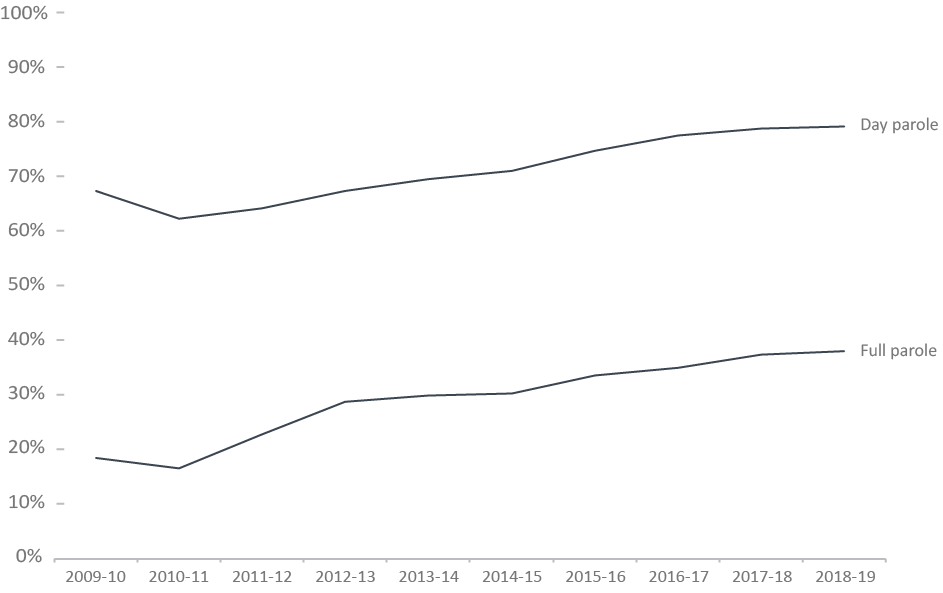
Source: Parole Board of Canada.
- In 2018-19, the federal day parole grant rate increased 0.4 of a percentage point to 79.5% compared to the previous year.
- In 2018-19, the federal full parole grant rate increased 0.7 of a percentage point to 38.2% compared to the previous year.
- Over the last 10 years, women offenders had a much higher grant rate for federal day parole (86.0%) and federal full parole (42.0%) than men offenders (71.1% and 29.3%).
Notes:
The grant rate represents the percentage of pre-release reviews resulting in a grant by the Parole Board of Canada.
Day parole is a type of conditional release granted by the Parole Board of Canada in which offenders are permitted to participate in community-based activities in preparation for full parole or statutory release. The conditions require offenders to return nightly to an institution, half-way house, or other location deemed appropriate for managing their risk, unless otherwise authorized by the Parole Board of Canada. Not all offenders apply for day parole, and some apply more than once before being granted day parole.
Full parole is a type of conditional release granted by the Parole Board of Canada in which the remainder of the sentence is served under supervision in the community. The Parole Board of Canada must review the cases of all offenders for full parole at the time prescribed by legislation, unless the offender advises the Parole Board of Canada in writing that he/she does not wish to be considered for full parole.
On March 28, 2011, Bill C-59 (Abolition of Early Parole Act) eliminated the accelerated parole review (APR) process, affecting first-time non-violent offenders serving sentences for Schedule II and non-Schedule offences, who in 2011-12 were no longer eligible for an APR review. These offenders are now assessed on general reoffending as compared to the APR risk assessment, which considered the risk of committing a violent offence only. To better illustrate historical trends, APR decisions were excluded.
Even though comparisons were made between federal regular day parole and full parole grant rates only, they nevertheless contain an APR residual effect between 2011-12 and 2015-16 as a sufficiently large proportion of the APR-affected population was granted regular federal day parole and full parole, perhaps inflating the grant rates.
Type of Release |
Year |
Granted |
Denied |
Grant Rate (%) |
APR* |
|||||||||
|---|---|---|---|---|---|---|---|---|---|---|---|---|---|---|
Women |
Men |
Women |
Men |
Women |
Men |
Total |
Directed |
Total |
||||||
Day Parole |
2009-10 |
153 |
1,957 |
40 |
967 |
79.3 |
66.9 |
67.7 |
947 |
1,491 |
||||
2010-11 |
136 |
1,854 |
43 |
1,148 |
76.0 |
61.8 |
62.6 |
970 |
1,591 |
|||||
2011-12 |
249 |
2,491 |
65 |
1,442 |
79.3 |
63.3 |
64.5 |
0 |
0 |
|||||
2012-13 |
289 |
2,821 |
73 |
1,415 |
79.8 |
66.6 |
67.6 |
14 |
21 |
|||||
2013-14 |
248 |
2,824 |
52 |
1,274 |
82.7 |
68.9 |
69.8 |
39 |
47 |
|||||
2014-15 |
297 |
3,024 |
52 |
1,281 |
85.1 |
70.2 |
71.4 |
38 |
45 |
|||||
2015-16 |
291 |
3,093 |
52 |
1,078 |
84.8 |
74.2 |
75.0 |
86 |
90 |
|||||
2016-17 |
399 |
3,445 |
48 |
1,041 |
89.3 |
76.8 |
77.9 |
80 |
83 |
|||||
2017-18 |
437 |
3,612 |
30 |
1,039 |
93.6 |
77.7 |
79.1 |
100 |
106 |
|||||
2018-19 |
470 |
3,736 |
28 |
1,055 |
94.4 |
78.0 |
79.5 |
56 |
58 |
|||||
Full Parole |
2009-10 |
32 |
461 |
89 |
2,080 |
26.4 |
18.1 |
18.5 |
1,004 |
1,010 |
||||
2010-11 |
20 |
436 |
88 |
2,204 |
18.5 |
16.5 |
16.6 |
1,046 |
1,059 |
|||||
2011-12 |
77 |
644 |
126 |
2,317 |
37.9 |
21.7 |
22.8 |
0 |
0 |
|||||
2012-13 |
90 |
914 |
143 |
2,327 |
38.6 |
28.2 |
28.9 |
26 |
26 |
|||||
2013-14 |
84 |
904 |
103 |
2,202 |
44.9 |
29.1 |
30.0 |
126 |
142 |
|||||
2014-15 |
87 |
969 |
106 |
2,307 |
45.1 |
29.6 |
30.4 |
119 |
137 |
|||||
2015-16 |
96 |
1,063 |
127 |
2,154 |
43.0 |
33.0 |
33.7 |
166 |
185 |
|||||
2016-17 |
138 |
1,237 |
158 |
2,383 |
46.6 |
34.2 |
35.1 |
122 |
126 |
|||||
2017-18 |
153 |
1,363 |
175 |
2,357 |
46.6 |
36.6 |
37.5 |
161 |
165 |
|||||
2018-19 |
157 |
1,446 |
176 |
2,419 |
47.1 |
37.5 |
38.2 |
66 |
67 |
|||||
Source: Parole Board of Canada.
Notes:
The grant rate represents the percentage of pre-release reviews resulting in a grant by the Parole Board of Canada.
Day parole is a type of conditional release granted by the Parole Board of Canada in which offenders are permitted to participate in community-based activities in preparation for full parole or statutory release. The conditions require offenders to return nightly to an institution, half-way house, or other location deemed appropriate for managing their risk, unless otherwise authorized by the Parole Board of Canada. Not all offenders apply for day parole, and some apply more than once before being granted day parole.
Full parole is a type of conditional release granted by the Parole Board of Canada in which the remainder of the sentence is served under supervision in the community. The Parole Board of Canada must review the cases of all offenders for full parole at the time prescribed by legislation, unless the offender advises the Parole Board of Canada in writing that he/she does not wish to be considered for full parole. Grant rates should be read with caution.
*On March 28, 2011, Bill C-59 (Abolition of Early Parole Act) eliminated the accelerated parole review (APR) process, affecting first-time non-violent offenders serving sentences for Schedule II and non-Schedule offences, who in 2011-12 were no longer eligible for an APR review. These offenders are now assessed on general reoffending as compared to the APR risk assessment, which considered the risk of committing a violent offence only. To better illustrate historical trends, APR decisions were excluded. However, the information on APR (the number of paroles directed and the total number of APR decisions) is presented in a separate section of the table. Grant rates should be read with caution. Even though comparisons were made between federal regular day parole and full parole grant rates only, they nevertheless contain an APR residual effect between 2011-12 and 2015-16 as a sufficiently large proportion of the APR-affected population were granted regular federal day parole and full parole, perhaps inflating the grant rates.
*As a result of court challenges, the Pacific Region (in 2012) and the Quebec Region (in 2013) have been processing active APR cases for offenders sentenced or convicted prior to the abolition of APR. Following the Canada (Attorney General) v. Whaling decision on March 20, 2014, the accelerated parole review process was reinstated across all regions for offenders sentenced prior to the abolition of APR.
Federal day and full parole grant rates for Indigenous offenders increased
Figure D4
Federal parole grant rate

Source: Parole Board of Canada.
- In 2018-19, the federal day parole grant rate increased for Indigenous offenders (to 76.6%; +2.6%) and decreased by 0.1 of a percentage point for non-Indigenous offenders to 80.4% compared to 2017-18.
- In 2018-19, the federal full parole grant rate increased for Indigenous offenders (to 27.9%; +5.2%) and for non-Indigenous offenders (to 40.8%; +0.1%) compared to 2017-18.
- Over the last 10 years, lower federal day and full parole grant rates were reported for Indigenous offenders (67.8%; 20.3%) than for non-Indigenous offenders (73.4%; 32.2%).
Notes:
The grant rate represents the percentage of pre-release reviews resulting in a grant by the Parole Board of Canada.
Day parole is a type of conditional release granted by the Parole Board of Canada in which offenders are permitted to participate in community-based activities in preparation for full parole or statutory release. The conditions require offenders to return nightly to an institution, half-way house, or other location deemed appropriate for managing their risk, unless otherwise authorized by the Parole Board of Canada. Not all offenders apply for day parole, and some apply more than once before being granted day parole.
Full parole is a type of conditional release granted by the Parole Board of Canada in which the remainder of the sentence is served under supervision in the community. The Parole Board of Canada must review the cases of all offenders for full parole at the time prescribed by legislation, unless the offender advises the Parole Board of Canada in writing that he/she does not wish to be considered for full parole.
On March 28, 2011, Bill C-59 (Abolition of Early Parole Act) eliminated the accelerated parole review (APR) process, affecting first-time non-violent offenders serving sentences for schedule II and non-scheduled offences, who in 2011-12 were no longer eligible for an APR review. These offenders are now assessed on general reoffending as compared to the APR risk assessment, which considered the risk of committing a violent offence only. To better illustrate historical trends, APR were excluded. Grant rates should be read with caution. Even though comparisons were made between federal regular day parole and full parole grant rates only, they nevertheless contain an APR residual effect between 2011-12 and 2015-16 as a sufficiently large proportion of the APR-affected population were granted regular federal day parole and full parole, perhaps inflating the grant rates.
Type of Release |
Year |
Granted |
Denied |
Grant Rate (%) |
Total |
|||||||
|---|---|---|---|---|---|---|---|---|---|---|---|---|
Indigenous |
Non-Ind. |
Indigenous |
Non-Ind. |
Indigenous |
Non-Ind. |
Granted/Denied |
Grant Rate (%) |
|||||
Day Parole |
2009-10 |
410 |
1,700 |
217 |
790 |
65.4 |
68.3 |
3,117 |
67.7 |
|||
2010-11 |
376 |
1,614 |
290 |
901 |
56.5 |
64.2 |
3,181 |
62.6 |
||||
2011-12 |
475 |
2,265 |
350 |
1,157 |
57.6 |
66.2 |
4,247 |
64.5 |
||||
2012-13 |
565 |
2,545 |
322 |
1,166 |
63.7 |
68.6 |
4,598 |
67.6 |
||||
2013-14 |
526 |
2,546 |
307 |
1,019 |
63.1 |
71.4 |
4,398 |
69.8 |
||||
2014-15 |
567 |
2,754 |
268 |
1,065 |
67.9 |
72.1 |
4,654 |
71.4 |
||||
2015-16 |
606 |
2,778 |
264 |
866 |
69.7 |
76.2 |
4,514 |
75.0 |
||||
2016-17 |
715 |
3,129 |
258 |
831 |
73.5 |
79.0 |
4,933 |
77.9 |
||||
2017-18 |
818 |
3,231 |
288 |
781 |
74.0 |
80.5 |
5,118 |
79.1 |
||||
2018-19 |
937 |
3,269 |
286 |
797 |
76.6 |
80.4 |
5,289 |
79.5 |
||||
Full Parole |
2009-10 |
50 |
443 |
420 |
1,749 |
10.6 |
20.2 |
2,662 |
18.5 |
|||
2010-11 |
71 |
385 |
480 |
1,812 |
12.9 |
17.5 |
2,748 |
16.6 |
||||
2011-12 |
76 |
645 |
473 |
1,970 |
13.8 |
24.7 |
3,164 |
22.8 |
||||
2012-13 |
103 |
901 |
475 |
1,995 |
17.8 |
31.1 |
3,474 |
28.9 |
||||
2013-14 |
124 |
864 |
425 |
1,880 |
22.6 |
31.5 |
3,293 |
30.0 |
||||
2014-15 |
108 |
948 |
452 |
1,961 |
19.3 |
32.6 |
3,469 |
30.4 |
||||
2015-16 |
136 |
1,023 |
435 |
1,846 |
23.8 |
35.7 |
3,440 |
33.7 |
||||
2016-17 |
155 |
1,220 |
469 |
2,072 |
24.8 |
37.1 |
3,916 |
35.1 |
||||
2017-18 |
168 |
1,348 |
572 |
1,960 |
22.7 |
40.7 |
4,048 |
37.5 |
||||
2018-19 |
235 |
1,372 |
607 |
1,988 |
27.9 |
40.8 |
4,202 |
38.2 |
||||
Source: Parole Board of Canada.
Notes:
The grant rate represents the percentage of pre-release reviews resulting in a grant by the Parole Board of Canada.
Day parole is a type of conditional release granted by the Parole Board of Canada in which offenders are permitted to participate in community-based activities in preparation for full parole or statutory release. The conditions require offenders to return nightly to an institution, half-way house, or other location deemed appropriate for managing their risk, unless otherwise authorized by the Parole Board of Canada. Not all offenders apply for day parole, and some apply more than once before being granted day parole.
Full parole is a type of conditional release granted by the Parole Board of Canada in which the remainder of the sentence is served under supervision in the community. The Parole Board of Canada must review the cases of all offenders for full parole at the time prescribed by legislation, unless the offender advises the Parole Board of Canada in writing that he/she does not wish to be considered for full parole.
On March 28, 2011, Bill C-59 (Abolition of Early Parole Act) eliminated the accelerated parole review (APR) process, affecting first-time non-violent offenders serving sentences for schedule II and non-scheduled offences, who in 2011-12 were no longer eligible for an APR review. These offenders are now assessed on general reoffending as compared to the APR risk assessment, which considered the risk of committing a violent offence only. To better illustrate historical trends, APR were excluded. Grant rates should be read with caution. Even though comparisons were made between federal regular day parole and full parole grant rates only, they nevertheless contain an APR residual effect between 2011-12 and 2015-16 as a sufficiently large proportion of the APR-affected population were granted regular federal day parole and full parole, perhaps inflating the grant rates.
The number of federal Elder-Assisted parole hearings increased
Figure D5
Federal Elder-Assisted parole hearings

Source: Parole Board of Canada.
- The number of federal Elder-Assisted parole hearings increased by 6.2% in 2018-19, following a 12.2% increase in 2017-18 (from 603 in 2016-17 to 677 in 2017-18, to 719 in 2018-19). The increase is associated with the in-reach conducted by the Board with Indigenous offenders.
- In 2018-19, 41.8% (681) of all federal parole hearings with Indigenous offenders, and 0.8% (38) of all federal parole hearings for offenders who did not self-identify as Indigenous were Elder-Assisted Hearings.
Notes:
The presence of an Elder is an alternative approach to the traditional parole hearing, and was introduced by the Parole Board of Canada to ensure that conditional release hearings are sensitive to Indigenous cultural values and traditions. This type of hearing is available to both Indigenous and non-Indigenous offenders.
The term "Elder" also refers to a Cultural Advisor as defined in section 11.1.1.5 of the Decision-Making Policy Manual.
Year |
Elder-Assisted Hearings |
|||||||||||
|---|---|---|---|---|---|---|---|---|---|---|---|---|
Indigenous Offenders |
Non-Indigenous Offenders |
All Offenders |
||||||||||
Total Hearings |
With an Elder |
Total Hearings |
With an Elder |
Total Hearings |
With an Elder |
|||||||
# |
# |
% |
# |
# |
% |
# |
# |
% |
||||
2009-10 |
1,215 |
363 |
29.9 |
4,393 |
54 |
1.2 |
5,608 |
417 |
7.4 |
|||
2010-11 |
1,234 |
440 |
35.7 |
4,266 |
49 |
1.1 |
5,500 |
489 |
8.9 |
|||
2011-12 |
1,275 |
431 |
33.8 |
4,590 |
38 |
0.8 |
5,865 |
469 |
8.0 |
|||
2012-13 |
1,313 |
423 |
32.2 |
4,631 |
46 |
1.0 |
5,944 |
469 |
7.9 |
|||
2013-14 |
930 |
347 |
37.3 |
3,658 |
29 |
0.8 |
4,588 |
376 |
8.2 |
|||
2014-15 |
889 |
360 |
40.5 |
3,827 |
43 |
1.1 |
4,716 |
403 |
8.5 |
|||
2015-16 |
961 |
374 |
38.9 |
3,969 |
30 |
0.8 |
4,930 |
404 |
8.2 |
|||
2016-17 |
1,297 |
554 |
42.7 |
4,496 |
49 |
1.1 |
5,793 |
603 |
10.4 |
|||
2017-18 |
1,539 |
635 |
41.3 |
4,848 |
42 |
0.9 |
6,387 |
677 |
10.6 |
|||
2018-19 |
1,630 |
681 |
41.8 |
4,932 |
38 |
0.8 |
6,562 |
719 |
11.0 |
|||
Source: Parole Board of Canada.
Notes:
The presence of an Elder is an alternative approach to the traditional parole hearing, and was introduced by the Parole Board of Canada to ensure that conditional release hearings are sensitive to Indigenous cultural values and traditions. This type of hearing is available to both Indigenous and non-Indigenous offenders.
The term "Elder" also refers to a Cultural Advisor as defined in section 11.1.1.5 of the Decision-Making Policy Manual.
Proportion of sentence served prior to being released on parole decreased for women
Figure D6
Percentage of sentence served
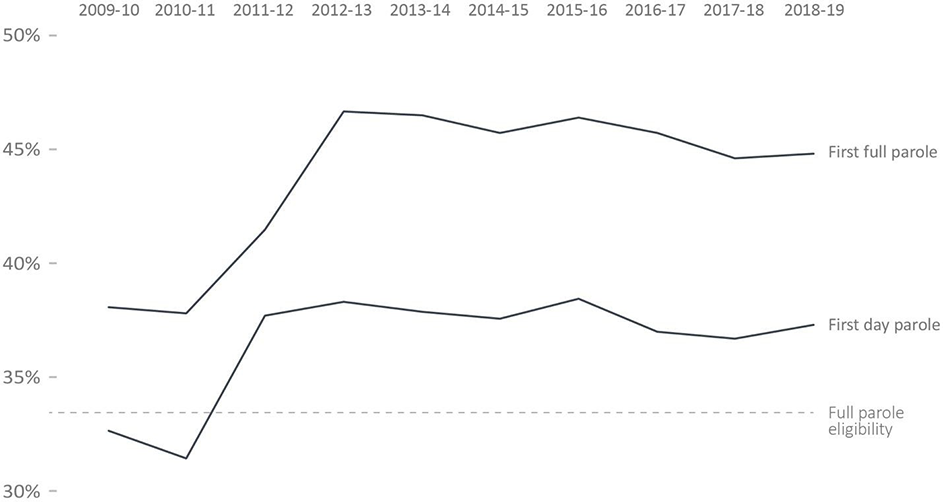
Source: Parole Board of Canada.
- In 2018-19, the average proportion of sentence served before the first federal day parole release for offenders serving determinate sentences increased negligibly (0.6 of a percentage point to 37.4%) from the previous year.
- The proportion of sentence served prior to first federal full parole release for offenders serving determinate sentences increased 0.2 of a percentage point (to 44.9%) in 2018-19 when compared to the previous year.
- In 2018-19, men offenders served higher proportions of their sentences before being released on their first federal day parole and full parole (38.0%; 45.3%) than women offenders (32.6%; 41.8%).
- In 2018-19, women offenders and men offenders served an average of 3.1 and 4.8 percentage points more of their sentences before their first federal day parole release and 5.7 and 6.8 percentage points more of their sentences before their first federal full parole release compared to 2009-10.
Notes:
Timing of parole in the sentence refers to the percentage of the sentence served at the time the first day parole or full parole starts during the sentence. In most cases a full parole is preceded by a day parole. These calculations are based on sentences under federal jurisdiction, excluding life sentences and indeterminate sentences. Offenders (other than those serving life or indeterminate sentences or subject to judicial determination) normally become eligible for full parole after serving 1/3 of their sentence or seven years, whichever is less. Eligibility for day parole is normally at six months before full parole eligibility.
The increases in the average proportion of time served after 2010-11 are in part due to the effect of Bill C-59 and were driven primarily by offenders serving sentences for Schedule II and non-Schedule offences (some of whom were former APR-eligible offenders).
Year |
Type of Supervision |
||||||
|---|---|---|---|---|---|---|---|
First Federal Day Parole |
First Federal Full Parole |
||||||
Women |
Men |
Total |
Women |
Men |
Total |
||
Percentage of Sentence Served (%) |
|||||||
2009-10 |
29.5 |
33.2 |
32.8 |
36.1 |
38.5 |
38.2 |
|
2010-11 |
29.2 |
31.8 |
31.6 |
36.6 |
38.1 |
37.9 |
|
2011-12 |
35.0 |
38.1 |
37.8 |
40.3 |
41.7 |
41.6 |
|
2012-13 |
38.9 |
38.3 |
38.4 |
45.6 |
46.9 |
46.7 |
|
2013-14 |
34.9 |
38.3 |
38.0 |
44.2 |
46.8 |
46.6 |
|
2014-15 |
35.3 |
37.9 |
37.7 |
44.9 |
45.9 |
45.8 |
|
2015-16 |
36.9 |
38.7 |
38.5 |
45.2 |
46.6 |
46.5 |
|
2016-17 |
33.6 |
37.5 |
37.1 |
43.5 |
46.1 |
45.8 |
|
2017-18 |
33.4 |
37.2 |
36.8 |
42.5 |
45.0 |
44.7 |
|
2018-19 |
32.6 |
38.0 |
37.4 |
41.8 |
45.3 |
44.9 |
|
Source: Parole Board of Canada.
Notes:
Timing of parole in the sentence refers to the percentage of the sentence served at the time the first day parole or full parole starts during the sentence. In most cases a full parole is preceded by a day parole. These calculations are based on sentences under federal jurisdiction, excluding life sentences and indeterminate sentences. Offenders (other than those serving life or indeterminate sentences or subject to judicial determination) normally become eligible for full parole after serving 1/3 of their sentence or seven years, whichever is less. Eligibility for day parole is normally at six months before full parole eligibility.
The increases in the average proportion of time served after 2010-11 are in part due to the effect of Bill C-59 and were driven primarily by offenders serving sentences for Schedule II and non-Schedule offences (some of whom were former APR-eligible offenders).
Indigenous offenders serve a higher proportion of their sentences before being released on parole
Figure D7
Percentage of sentence served in custody before first federal parole
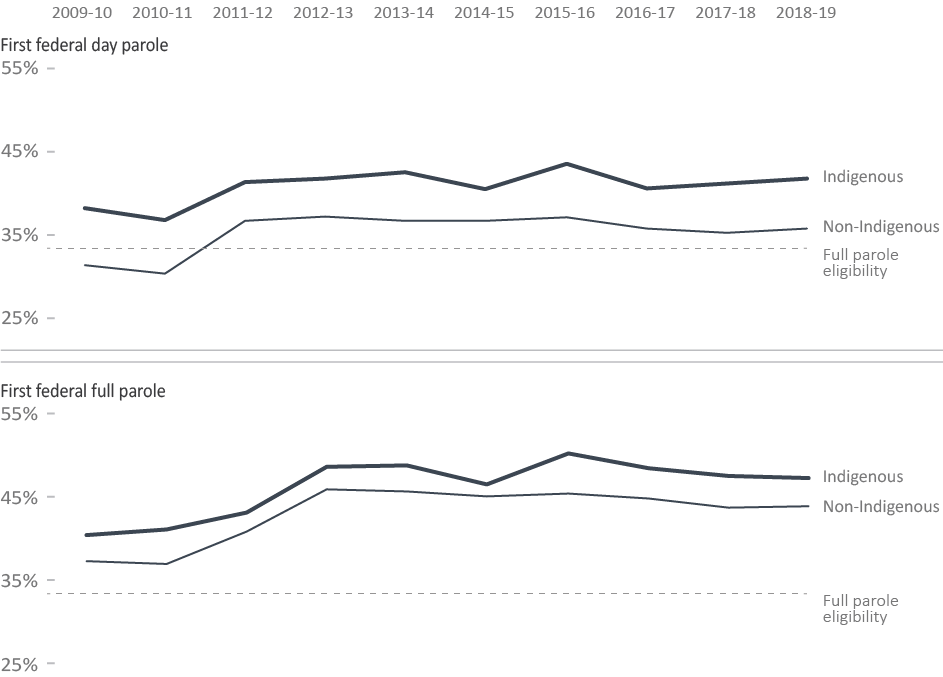
Source: Parole Board of Canada.
- In 2018-19, Indigenous offenders served higher proportions of their sentences before being released on their first federal day parole (42.2%) and full parole (47.8%, a decrease of 0.3 of a percentage point compared to 2017-18), than non-Indigenous offenders (36.2%; 44.5%).
- Over the last ten years, Indigenous offenders served higher proportions of their sentences before their first federal day parole and full parole release (41.2%; 46.8%), than non-Indigenous offenders (35.7%; 43.5%).
Notes:
Timing of parole in the sentence refers to the percentage of the sentence served at the time the first day parole or full parole starts during the sentence. In most cases a full parole is preceded by a day parole.
These calculations are based on sentences under federal jurisdiction, excluding life sentences and indeterminate sentences.
Offenders (other than those serving life or indeterminate sentences or subject to judicial determination) normally become eligible for full parole after serving 1/3 of their sentence or seven years, whichever is less. Eligibility for day parole is normally at six months before full parole eligibility.
The increases in the average proportion of time served after 2010-11 are in part due to the effect of Bill C-59 and were driven primarily by offenders serving sentences for Schedule II and non-Schedule offences (some of whom were former APR-eligible offenders).
Year |
Type of Supervision |
||||||
First Federal Day Parole |
First Federal Full Parole |
||||||
Indigenous |
Non- Indigenous |
Total |
Indigenous |
Non- Indigenous |
Total |
||
Percentage of Sentence Served (%) |
|||||||
2009-10 |
38.7 |
31.8 |
32.8 |
41.0 |
37.9 |
38.2 |
|
2010-11 |
37.2 |
30.8 |
31.6 |
41.6 |
37.5 |
37.9 |
|
2011-12 |
41.7 |
37.1 |
37.8 |
43.7 |
41.4 |
41.6 |
|
2012-13 |
42.2 |
37.6 |
38.4 |
49.2 |
46.5 |
46.7 |
|
2013-14 |
42.9 |
37.1 |
38.0 |
49.3 |
46.2 |
46.6 |
|
2014-15 |
40.9 |
37.1 |
37.7 |
47.1 |
45.6 |
45.8 |
|
2015-16 |
44.0 |
37.5 |
38.5 |
50.8 |
46.0 |
46.5 |
|
2016-17 |
41.0 |
36.2 |
37.1 |
49.0 |
45.4 |
45.8 |
|
2017-18 |
41.6 |
35.7 |
36.8 |
48.1 |
44.3 |
44.7 |
|
2018-19 |
42.2 |
36.2 |
37.4 |
47.8 |
44.5 |
44.9 |
|
Source: Parole Board of Canada.
Notes:
Timing of parole in the sentence refers to the percentage of the sentence served at the time the first day parole or full parole starts during the sentence. In most cases a full parole is preceded by a day parole.
These calculations are based on sentences under federal jurisdiction, excluding life sentences and indeterminate sentences.
Offenders (other than those serving life or indeterminate sentences or subject to judicial determination) normally become eligible for full parole after serving 1/3 of their sentence or seven years, whichever is less. Eligibility for day parole is normally at six months before full parole eligibility.
The increases in the average proportion of time served after 2010-11 are in part due to the effect of Bill C-59 and were driven primarily by offenders serving sentences for Schedule II and non-Schedule offences (some of whom were former APR-eligible offenders).
The successful completion rate of federal day parole supervision periods remained stable
Figure D8
Day parole outcomes – 10-year trend
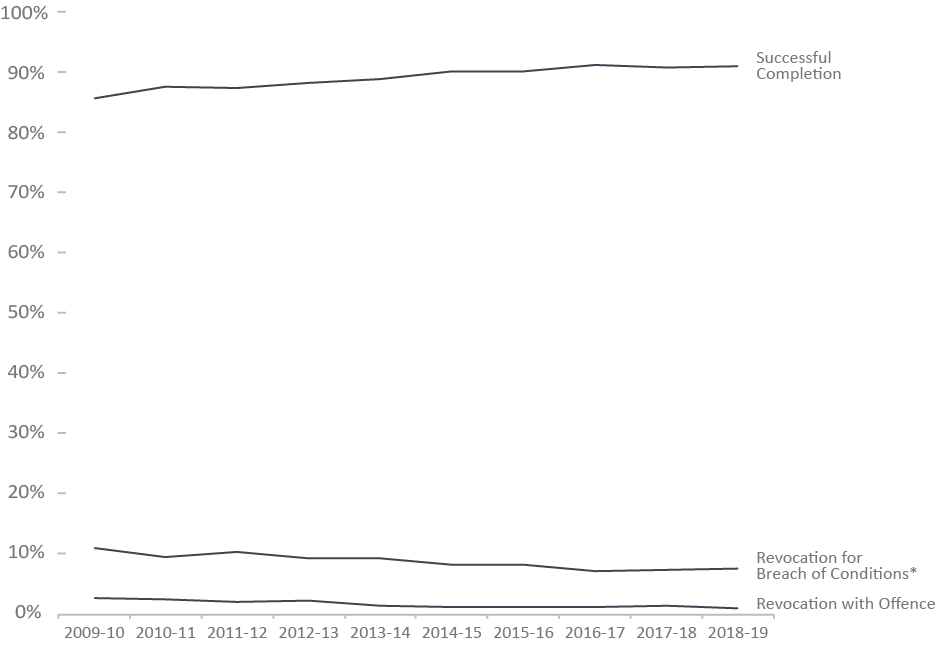
Source: Parole Board of Canada.
- In the last 10 years, the successful completion rate of federal day parole supervision periods has been over 85%.
- In 2018-19, the successful completion rate of federal day parole supervision periods remained relatively stable (91.4%; +0.3%) compared to 2017-18.
- During the five-year period (between 2014-15 and 2018-19), the successful completion rate of federal regular day parole supervision periods was on average 6.3 percentage points lower than the rate of federal APR day parole supervision periods (91.0% and 97.3%, respectively).
- The rate of violent reoffending of federal day parole supervision periods has been very low in the last five years, averaging 0.2%.
Notes:
*Revocation for Breach of Conditions includes revocation with outstanding charges.
A day parole supervision period is considered successful if it was completed without a return to prison for a breach of conditions or for a new offence.
Federal Day Parole Outcomes |
2014-15 |
2015-16 |
2016-17 |
2017-18 |
2018-19 |
|||||
# |
% |
# |
% |
# |
% |
# |
% |
# |
% |
|
Successful Completion |
||||||||||
Regular |
2,784 |
90.4 |
2,982 |
90.5 |
3,172 |
91.5 |
3,467 |
91.0 |
3,619 |
91.3 |
Accelerated |
36 |
100.0 |
38 |
100.0 |
86 |
97.7 |
84 |
93.3 |
75 |
98.7 |
Total |
2,820 |
90.5 |
3,020 |
90.6 |
3,258 |
91.7 |
3,551 |
91.1 |
3,694 |
91.4 |
Revocation for Breach of Conditions* |
||||||||||
Regular |
260 |
8.4 |
272 |
8.3 |
249 |
7.2 |
284 |
7.5 |
304 |
7.7 |
Accelerated |
0 |
0.0 |
0 |
0.0 |
2 |
2.3 |
6 |
6.7 |
1 |
1.3 |
Total |
260 |
8.3 |
272 |
8.2 |
251 |
7.1 |
290 |
7.4 |
305 |
7.5 |
Revocation with Non-Violent Offence |
||||||||||
Regular |
35 |
1.1 |
32 |
1.0 |
37 |
1.1 |
53 |
1.4 |
37 |
0.9 |
Accelerated |
0 |
0.0 |
0 |
0.0 |
0 |
0.0 |
0 |
0.0 |
0 |
0.0 |
Total |
35 |
1.1 |
32 |
1.0 |
37 |
1.0 |
53 |
1.4 |
37 |
0.9 |
Revocation with Violent Offence** |
||||||||||
Regular |
1 |
0.0 |
9 |
0.3 |
7 |
0.2 |
6 |
0.2 |
5 |
0.1 |
Accelerated |
0 |
0.0 |
0 |
0.0 |
0 |
0.0 |
0 |
0.0 |
0 |
0.0 |
Total |
1 |
0.0 |
9 |
0.3 |
7 |
0.2 |
6 |
0.2 |
5 |
0.1 |
Total |
||||||||||
Regular |
3,080 |
98.8 |
3,295 |
98.9 |
3,465 |
97.5 |
3,810 |
97.7 |
3,965 |
98.1 |
Accelerated |
36 |
1.2 |
38 |
1.1 |
88 |
2.5 |
90 |
2.3 |
76 |
1.9 |
Total |
3,116 |
100.0 |
3,333 |
100.0 |
3,553 |
100.0 |
3,900 |
100.0 |
4,041 |
100.0 |
Source: Parole Board of Canada.
Notes:
*Revocation for Breach of Conditions includes revocation with outstanding charges.
**Violent offences include murder and Schedule I offences (listed in the Corrections and Conditional Release Act) such as assaults, sexual offences, arson, abduction, robbery and some weapon offences.
A day parole supervision period is considered successful if it was completed without a return to prison for a breach of conditions or for a new offence.
The successful completion rate of federal full parole supervision periods decreased
Figure D9
Full parole outcomes* – 10-year trend
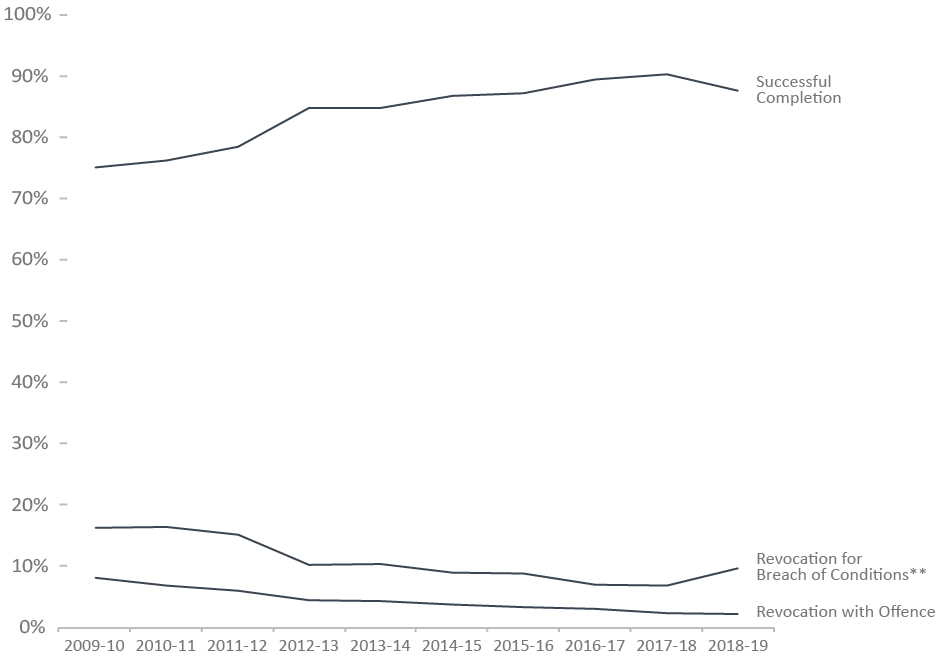
Source: Parole Board of Canada.
- In 2018-19, the successful completion rate of federal full parole supervision periods for offenders serving determinate sentences decreased 2.6 percentage points (to 87.8%) compared to 2017-18.
- During the five-year period (between 2014-15 and 2018-19), the successful completion rate of federal regular full parole supervision periods was on average slightly lower (-0.9 of a percentage point) than the rate of federal APR full parole supervision periods (88.4% and 89.3%, respectively).
- The rate of violent reoffending on federal full parole supervision periods has been relatively low in the last five years, averaging 0.4%.
Notes:
*Excludes offenders serving indeterminate sentences because they do not have a warrant expiry date and can only successfully complete full parole upon [their] death.
**Revocation for Breach of Conditions includes revocation with outstanding charges.
A full parole supervision period is considered successful if it was completed without a return to prison for a breach of conditions or for a new offence.
Federal Full Parole Outcomes* |
2014-15 |
2015-16 |
2016-17 |
2017-18 |
2018-19 |
|||||
# |
% |
# |
% |
# |
% |
# |
% |
# |
% |
|
Successful Completion |
||||||||||
Regular |
734 |
86.9 |
757 |
87.5 |
846 |
89.7 |
968 |
90.6 |
1,054 |
87.0 |
Accelerated |
97 |
87.4 |
95 |
86.4 |
89 |
88.1 |
102 |
88.7 |
118 |
95.2 |
Total |
831 |
86.9 |
852 |
87.4 |
935 |
89.6 |
1,070 |
90.4 |
1,172 |
87.8 |
Revocation for Breach of Conditions** |
||||||||||
Regular |
77 |
9.1 |
76 |
8.8 |
65 |
6.9 |
75 |
7.0 |
126 |
10.4 |
Accelerated |
11 |
9.9 |
12 |
10.9 |
10 |
9.9 |
8 |
7.0 |
5 |
4.0 |
Total |
88 |
9.2 |
88 |
9.0 |
75 |
7.2 |
83 |
7.0 |
131 |
9.8 |
Revocation with Non-Violent Offence |
||||||||||
Regular |
33 |
3.9 |
25 |
2.9 |
27 |
2.9 |
21 |
2.0 |
26 |
2.1 |
Accelerated |
3 |
2.7 |
3 |
2.7 |
1 |
1.0 |
5 |
4.3 |
1 |
0.8 |
Total |
36 |
3.8 |
28 |
2.9 |
28 |
2.7 |
26 |
2.2 |
27 |
2.0 |
Revocation with Violent Offence*** |
||||||||||
Regular |
1 |
0.1 |
7 |
0.8 |
5 |
0.5 |
5 |
0.5 |
5 |
0.4 |
Accelerated |
0 |
0.0 |
0 |
0.0 |
1 |
1.0 |
0 |
0.0 |
0 |
0.0 |
Total |
1 |
0.1 |
7 |
0.7 |
6 |
0.6 |
5 |
0.4 |
5 |
0.4 |
Total |
||||||||||
Regular |
845 |
88.4 |
865 |
88.7 |
943 |
90.3 |
1,069 |
90.3 |
1,211 |
90.7 |
Accelerated |
111 |
11.6 |
110 |
11.3 |
101 |
9.7 |
115 |
9.7 |
124 |
9.3 |
Total |
956 |
100.0 |
975 |
100.0 |
1,044 |
100.0 |
1,184 |
100.0 |
1,335 |
100.0 |
Source: Parole Board of Canada.
Notes:
*Excludes offenders serving indeterminate sentences because they do not have a warrant expiry date and can only successfully complete full parole upon [their] death.
**Revocation for Breach of Conditions includes revocation with outstanding charges.
***Violent offences include murder and Schedule I offences (listed in the Corrections and Conditional Release Act) such as assaults, sexual offences, arson, abduction, robbery and some weapon offences.
A full parole supervision period is considered successful if it was completed without a return to prison for a breach of conditions or for a new offence.
The successful completion rate of statutory release supervision periods remained stable
Figure D10
Statutory release outcomes – 10-year trend
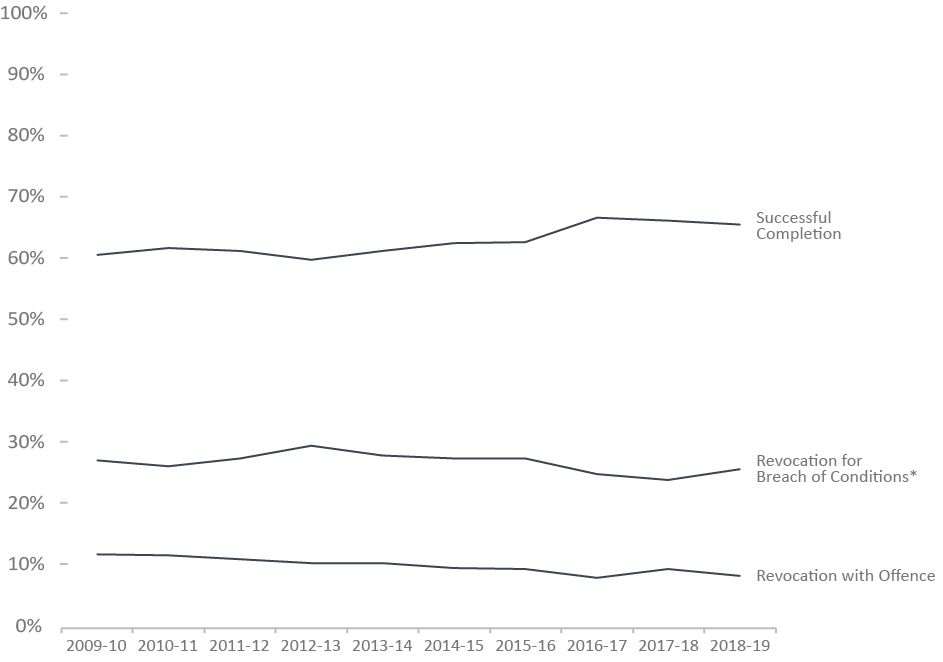
Source: Parole Board of Canada.
- In 2018-19, the successful completion rate of statutory release supervision periods remained relatively stable (65.7%; -0.6%) compared to 2017-18.
- Over the last five years, the revocation with violent offence rates were, on average, nine times higher for offenders on statutory release than for offenders on federal day parole and 3.5 times higher than for offenders on federal full parole.
- The rate of revocation with a violent offence of statutory release supervision periods has been declining in the last five years, averaging 1.4%.
Notes:
*Revocation for Breach of Conditions includes revocation with outstanding charges.
A statutory release supervision period is considered successful if it was completed without a return to prison for a breach of conditions or for a new offence.
An offender serving a determinate sentence, if he/she is not detained, will be subject to statutory release after serving 2/3 of his/her sentence if he/she is not on full parole at that time. On statutory release, an offender is subject to supervision until the end of his/her sentence.
Statutory Release Outcomes |
2014-15 |
2015-16 |
2016-17 |
2017-18 |
2018-19 |
|||||
# |
% |
# |
% |
# |
% |
# |
% |
# |
% |
|
Successful Completion |
3,756 |
62.7 |
3,779 |
62.8 |
3,781 |
66.8 |
3,572 |
66.3 |
3,262 |
65.7 |
Revocation for Breach of Conditions* |
1,648 |
27.5 |
1,663 |
27.6 |
1,412 |
25.0 |
1,299 |
24.1 |
1,279 |
25.8 |
Revocation with Non-Violent Offence |
491 |
8.2 |
485 |
8.1 |
382 |
6.8 |
445 |
8.3 |
366 |
7.4 |
Revocation with Violent Offence** |
91 |
1.5 |
95 |
1.6 |
83 |
1.5 |
70 |
1.3 |
56 |
1.1 |
Total |
5,986 |
100.0 |
6,022 |
100.0 |
5,658 |
100.0 |
5,386 |
100.0 |
4,963 |
100.0 |
Source: Parole Board of Canada.
Notes:
*Revocation for Breach of Conditions includes revocation with outstanding charges.
**Violent offences include murder and Schedule I offences (listed in the Corrections and Conditional Release Act) such as assaults, sexual offences, arson, abduction, robbery and some weapon offences.
A statutory release supervision period is considered successful if it was completed without a return to prison for a breach of conditions or for a new offence.
An offender serving a determinate sentence, if he/she is not detained, will be subject to statutory release after serving 2/3 of his/her sentence if he/she is not on full parole at that time. On statutory release, an offender is subject to supervision until the end of his/her sentence.
Over the last ten years, the rates of conviction for violent offences for offenders on federal conditional release has declined
Figure D11
Rate of conviction for violent offences* per 1,000 supervised offenders**
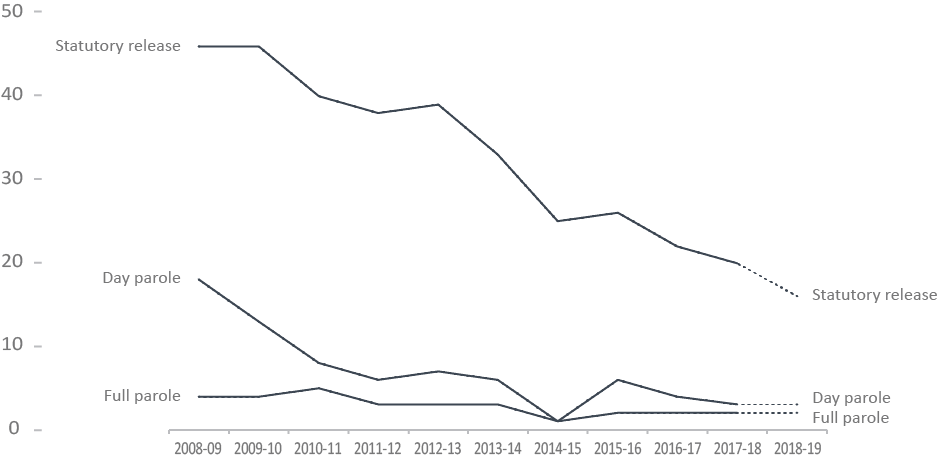
Source: Parole Board of Canada.
- Over the last ten years (between 2008-09 and 2017-18), the number of convictions for a violent offence for offenders on federal conditional release decreased 57% (from 192 in 2008-09 to 83 in 2017-18). Day parolees averaged 10 convictions for violent offences annually and full parolees, 11 convictions, compared to 116 by offenders on statutory release.
- Over the last ten years (between 2008-09 and 2017-18), convictions for violent offences on statutory release accounted for 85% of all convictions by offenders on federal conditional release.
- When comparing the rates of conviction for violent offences per 1,000 supervised offenders (between 2008-09 and 2017-18), offenders on statutory release were 11.6 times more likely to commit a violent offence during their supervision periods than offenders on full parole, and 4.7 times more likely to commit a violent offence than offenders on day parole.
Notes:
*Violent offences include murder and Schedule I offences (listed in the Corrections and Conditional Release Act) such as assaults, sexual offences, arson, abduction, robbery and some weapon offences.
**Supervised offenders include offenders who are on parole, statutory release, those temporarily detained in federal institutions, and those who are unlawfully at large.
Day and full parole include those offenders serving determinate and indeterminate sentences.
The dotted line between 2017-18 and 2018-19 is intended to signify that due to delays in the court process, the numbers for 2018-19 under-represent the actual number of convictions, as verdicts may have not been reached by year-end.
Year |
# of Convictions for Violent Offences*** |
Rates per 1,000 Supervised Offenders* |
||||||
Day Parole |
Full Parole |
Statutory Release |
Total |
Day Parole |
Full Parole |
Statutory Release |
||
2008-09 |
22 |
17 |
153 |
192 |
18 |
4 |
46 |
|
2009-10 |
17 |
16 |
149 |
182 |
13 |
4 |
46 |
|
2010-11 |
10 |
19 |
129 |
158 |
8 |
5 |
40 |
|
2011-12 |
8 |
10 |
135 |
153 |
6 |
3 |
38 |
|
2012-13 |
9 |
11 |
136 |
156 |
7 |
3 |
39 |
|
2013-14 |
7 |
10 |
119 |
136 |
6 |
3 |
33 |
|
2014-15 |
1 |
4 |
91 |
96 |
1 |
1 |
25 |
|
2015-16 |
9 |
9 |
95 |
113 |
6 |
2 |
26 |
|
2016-17 |
7 |
9 |
83 |
99 |
4 |
2 |
22 |
|
2017-18 |
6 |
7 |
70 |
83 |
3 |
2 |
20 |
|
2018-19** |
5 |
8 |
56 |
69 |
3 |
2 |
16 |
|
Source: Parole Board of Canada.
Notes:
*Supervised offenders include offenders who are on parole, statutory release, those temporarily detained in federal institutions, and those who are unlawfully at large.
**Due to delays in the court processes, the numbers for 2018-19 under-represent the actual number of convictions, as verdicts may not have been reached by year-end.
Day and full parole include those offenders serving determinate and indeterminate sentences.
***Violent offences include murder and Schedule I offences (listed in the Corrections and Conditional Release Act) such as assaults, sexual offences, arson, abduction, robbery and some weapon offences.
The number of offenders granted temporary absences remain stable
Figure D12
Number of offenders
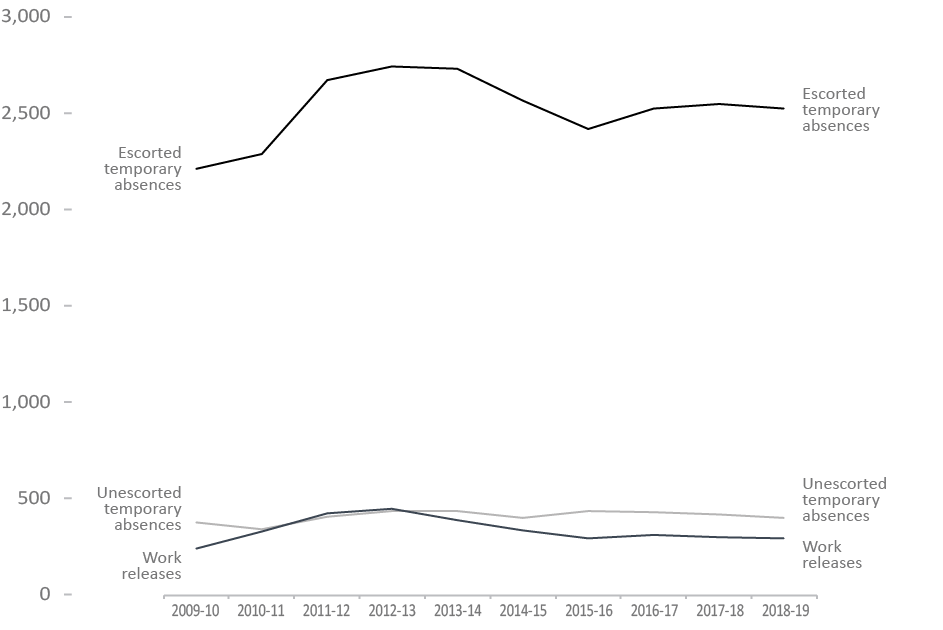
Source: Correctional Service of Canada.
- There was a small decrease in the number of offenders receiving escorted temporary absences, from 2,556 in 2017-18 to 2,536 in 2018-19. There was a small decrease in the number of offenders receiving unescorted temporary absences, from 428 in 2017-18 to 411 in 2018-19.
- The number of offenders receiving work releases has decreased by 2.9%, from 313 in 2017-18 to 304 in 2018-19.
- For the past 10 years, the average successful completion rates for escorted temporary absences was 99.5%, 98.8% for unescorted temporary absences and 94.8% for work releases.
Notes:
A temporary absence is permission given to an eligible offender to be away from the normal place of confinement for medical, administrative, community service, family contact, personal development for rehabilitative purposes, or compassionate reasons, including parental responsibilities.
A work release is a structured program of release of specified duration for work or community service outside the penitentiary, under the supervision of a staff member or other authorized person or organization.
These numbers depict the number of offenders who received at least one temporary absence permit (excluding those for medical purposes) or at least one work release. An offender may be granted more than one temporary absence permit or work release over a period of time.
Year |
Temporary Absences |
Work Releases |
|||||||
Escorted |
Unescorted |
||||||||
# of Offenders |
# of Permits |
# of Offenders |
# of Permits |
# of Offenders |
# of Permits |
||||
2009-10 |
2,222 |
35,815 |
388 |
3,295 |
254 |
1,063 |
|||
2010-11 |
2,301 |
40,072 |
353 |
3,117 |
339 |
1,343 |
|||
2011-12 |
2,685 |
44,399 |
418 |
3,891 |
435 |
875 |
|||
2012-13 |
2,753 |
47,814 |
448 |
3,709 |
455 |
815 |
|||
2013-14 |
2,740 |
49,502 |
447 |
4,004 |
400 |
643 |
|||
2014-15 |
2,574 |
49,633 |
411 |
3,563 |
345 |
489 |
|||
2015-16 |
2,430 |
47,065 |
445 |
4,077 |
304 |
418 |
|||
2016-17 |
2,537 |
48,568 |
442 |
3,778 |
323 |
481 |
|||
2017-18 |
2,556 |
50,518 |
428 |
3,167 |
313 |
444 |
|||
2018-19 |
2,536 |
56,124 |
411 |
2,830 |
304 |
436 |
|||
Source: Correctional Service of Canada.
Notes:
A temporary absence is permission given to an eligible offender to be away from the normal place of confinement for medical, administrative, community service, family contact, personal development for rehabilitative purposes, or compassionate reasons, including parental responsibilities.
A work release is a structured program of release of specified duration for work or community service outside the penitentiary, under the supervision of a staff member or other authorized person or organization.
These numbers depict the number of offenders who received at least one temporary absence permit (excluding those for medical purposes) or at least one work release. An offender may be granted more than one temporary absence permit or work release over a period of time.
Section E. Statistics on Special Applications of Criminal Justice
The number of initial detention reviews decreased
Figure E1
Number of initial detention reviews
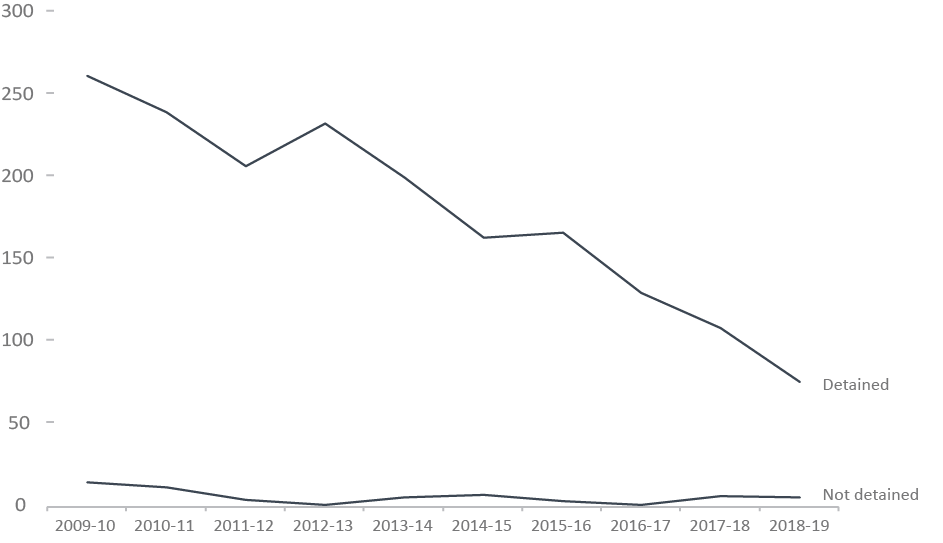
Source: Parole Board of Canada.
- In 2018-19, the number of referrals for detention decreased by 28.5% to 85 (from 119) when compared to 2017-18.
- The number of offenders detained as a result of a detention review decreased to 77 (-30%) compared to the previous year, while their proportion decreased to 90.6%. Eight offenders were released on statutory release following a detention review in 2018-19.
- Averaged over the last five years, the detention rate for Indigenous offenders was 93.5% compared to 95.5% for non-Indigenous offenders. Twenty Indigenous offenders and 17 non-Indigenous offenders were released on statutory release in the last five years.
- In 2018-19, Indigenous offenders accounted for 29.6% of federal incarcerated offenders serving determinate sentences while they accounted for 50.5% of offenders referred for detention and 49.4% of offenders detained.
Notes:
According to the Corrections and Conditional Release Act, an offender entitled to statutory release after serving two-thirds of the sentence may be held in custody until warrant expiry if it is established that the offender is likely to commit, before the expiry of his/her sentence, an offence causing death or serious harm, a serious drug offence or a sex offence involving a child.
Year |
Outcome of Initial Detention Reviews |
|||||||||||||
Detained |
Statutory Release |
Total |
Total |
|||||||||||
Ind.* |
Non- Ind.** |
Total |
% |
Ind.* |
Non- Ind.** |
Total |
% |
Ind.* |
Non- Ind.** |
|||||
2004-05 |
72 |
153 |
225 |
91.1 |
6 |
16 |
22 |
8.9 |
78 |
169 |
247 |
|||
2005-06 |
75 |
158 |
233 |
89.3 |
11 |
17 |
28 |
10.7 |
86 |
175 |
261 |
|||
2006-07 |
67 |
155 |
222 |
88.8 |
4 |
24 |
28 |
11.2 |
71 |
179 |
250 |
|||
2007-08 |
92 |
155 |
247 |
93.2 |
7 |
11 |
18 |
6.8 |
99 |
166 |
265 |
|||
2008-09 |
109 |
147 |
256 |
95.9 |
5 |
6 |
11 |
4.1 |
114 |
153 |
267 |
|||
2009-10 |
99 |
162 |
261 |
93.9 |
2 |
15 |
17 |
6.1 |
101 |
177 |
278 |
|||
2010-11 |
113 |
126 |
239 |
94.5 |
5 |
9 |
14 |
5.5 |
118 |
135 |
253 |
|||
2011-12 |
89 |
118 |
207 |
96.7 |
3 |
4 |
7 |
3.3 |
92 |
122 |
214 |
|||
2012-13 |
91 |
141 |
232 |
98.3 |
4 |
0 |
4 |
1.7 |
95 |
141 |
236 |
|||
2013-14 |
87 |
113 |
200 |
96.2 |
4 |
4 |
8 |
3.8 |
91 |
117 |
208 |
|||
2014-15 |
70 |
94 |
164 |
94.3 |
5 |
5 |
10 |
5.7 |
75 |
99 |
174 |
|||
2015-16 |
73 |
94 |
167 |
96.5 |
2 |
4 |
6 |
3.5 |
75 |
98 |
173 |
|||
2016-17 |
55 |
76 |
131 |
97.0 |
2 |
2 |
4 |
3.0 |
57 |
78 |
135 |
|||
2017-18 |
50 |
60 |
110 |
92.4 |
6 |
3 |
9 |
7.6 |
56 |
63 |
119 |
|||
2018-19 |
38 |
39 |
77 |
90.6 |
5 |
3 |
8 |
9.4 |
43 |
42 |
85 |
|||
Total |
1,180 |
1,791 |
2,971 |
96.5 |
71 |
123 |
194 |
6.3 |
1,251 |
1,914 |
3,080 |
|||
Source: Parole Board of Canada.
Notes:
*Ind. is short form for Indigenous.
**non-Ind. is short form for non-Indigenous.
According to the Corrections and Conditional Release Act, an offender entitled to statutory release after serving two-thirds of the sentence may be held in custody until warrant expiry if it is established that the offender is likely to commit, before the expiry of his/her sentence, an offence causing death or serious harm, a serious drug offence or a sex offence involving a child.
76% of judicial review hearings result in earlier parole eligibility
Figure E2
Judicial review hearings at the end of the fiscal year (2018-19)
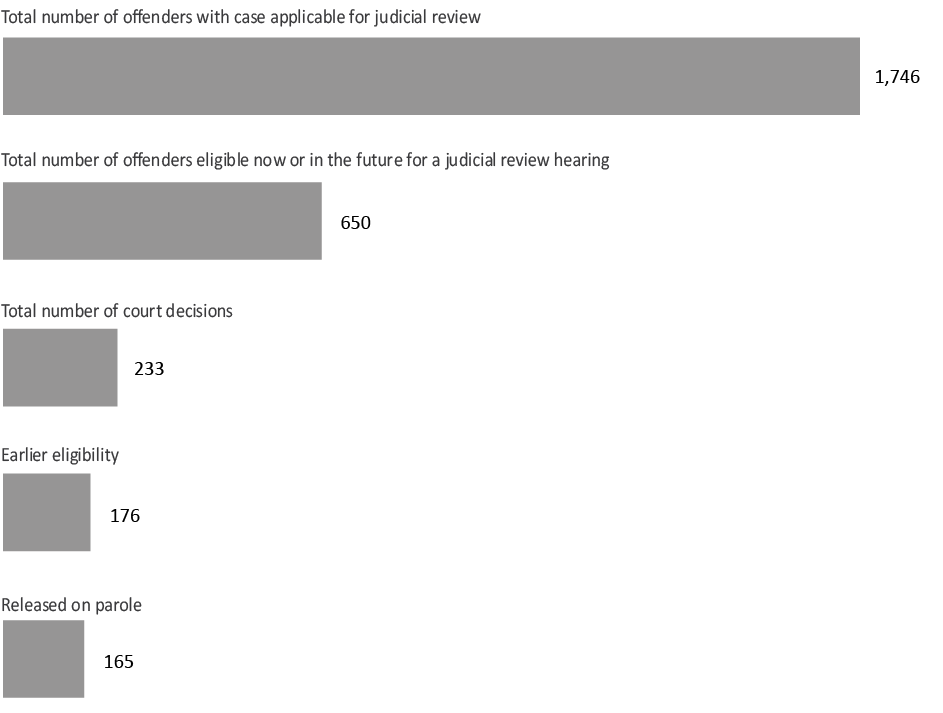
Source: Correctional Service of Canada.
- Since the first judicial review hearing in 1987, there have been a total of 233 court decisions.
- Of these cases, 75.5% of the court decisions resulted in a reduction of the period that must be served before parole eligibility.
- Of the 650 offenders eligible to apply for a judicial review, 272 have already served 15 years of their sentence, whereas 378 have not.
- Of the 176 offenders who had their parole eligibility date moved closer, 172 had reached their revised Day Parole eligibility date. Of these offenders, 165 were released on parole, and 117 were being actively supervised in the community.*
- A higher percentage of second degree (83.3%) than first degree (74.6%) murder cases have resulted in a reduction of the period required to be served before parole eligibility.
Notes:
*Of the 48 offenders who were no longer under active supervision, five were in custody, 36 were deceased, six were deported, and one was unlawfully at large.
Judicial review is an application to the court for a reduction in the time required to be served before being eligible for parole. Judicial review procedures apply to offenders who have been sentenced to imprisonment for life without eligibility for parole until more than fifteen years of their sentence has been served. Offenders can apply when they have served at least 15 years of their sentence.
Judicial reviews are conducted in the province where the conviction took place.
Province/Territory of Judicial Review |
Parole Ineligibility Reduced by Court |
Reduction Denied by Court |
Total |
||||||
1st Degree Murder |
2nd Degree Murder |
1st Degree Murder |
2nd Degree Murder |
1st Degree Murder |
2nd Degree Murder |
||||
Northwest Territories |
0 |
0 |
0 |
0 |
0 |
0 |
|||
Nunavut |
0 |
0 |
0 |
0 |
0 |
0 |
|||
Yukon Territories |
0 |
0 |
0 |
0 |
0 |
0 |
|||
Newfoundland & Labrador |
0 |
0 |
0 |
0 |
0 |
0 |
|||
Prince Edward Island |
0 |
0 |
0 |
0 |
0 |
0 |
|||
Nova Scotia |
1 |
1 |
1 |
0 |
2 |
1 |
|||
New Brunswick |
1 |
0 |
0 |
0 |
1 |
0 |
|||
Quebec |
74 |
15 |
6 |
2 |
80 |
17 |
|||
Ontario |
23 |
0 |
29 |
1 |
52 |
1 |
|||
Manitoba |
8 |
3 |
1 |
0 |
9 |
3 |
|||
Saskatchewan |
7 |
0 |
3 |
0 |
10 |
0 |
|||
Alberta |
19 |
0 |
7 |
1 |
26 |
1 |
|||
British Columbia |
23 |
1 |
6 |
0 |
29 |
1 |
|||
Sub-total |
156 |
20 |
53 |
4 |
209 |
24 |
|||
Total |
176 |
57 |
233 |
||||||
Source: Correctional Service of Canada.
Notes:
These numbers represent total decisions at the end of fiscal year 2018-19.
Judicial reviews are conducted in the province where the conviction took place.
The number of dangerous offender designations
Figure E3
Number of dangerous offenders* designated- 10-year trend
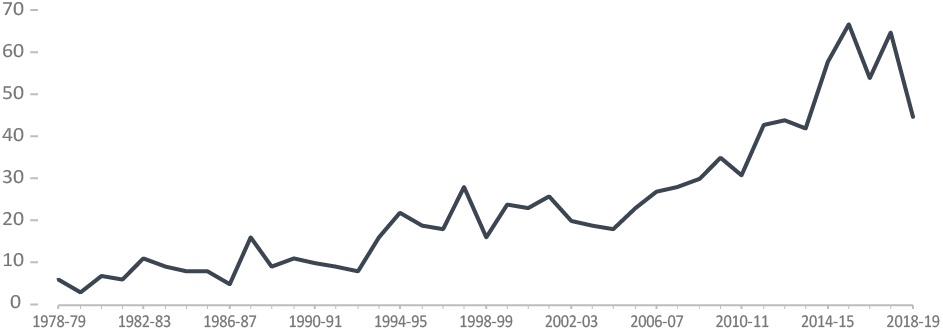
Source: Correctional Service of Canada.
- At the end of fiscal year 2018-19, there have been 967 offenders designated as Dangerous Offenders (DOs) since 1978. Of these, 67.6% had at least one current conviction for a sexual offence.
- At the end of fiscal year 2018-19, there were 826 DOs under the responsibility of Correctional Service Canada, and of those, 79.3% had indeterminate sentences.
- Of these 826 DOs, 726 were in custody (representing 5.1% of the total in-custody population) and 100 were in the community under supervision.
- There were ten women offenders with a Dangerous Offender designation.
- Indigenous offenders accounted for 35.5% of DOs and 25.2% of the total offender population.
Notes:
*A Dangerous Offender (DO) is an individual given an indeterminate or a determinate sentence on the basis of a particularly violent crime or pattern of serious violent offences where it is judged that the offender's behaviour is unlikely to be inhibited by normal standards of behavioural restraint (see section 753 of the Criminal Code of Canada).
The number of Dangerous Offenders designated per year does not include overturned decisions.
Offenders who have died since receiving designations are no longer classified as "active"; however, they are still represented in the above graph, which depicts the total number of offenders "designated". Dangerous Offender legislation came into effect in Canada on October 15, 1977, replacing the Habitual Offender and Dangerous Sexual Offender provisions that were abolished.
In addition to the DOs, there were 14 Dangerous Sexual Offenders and 3 offenders with an Habitual Offender designation under the responsibility of Correctional Service Canada at the end of fiscal 2018-19.
Determinate sentence for Dangerous Offenders must be a minimum punishment of imprisonment for a term of two years — and have an order that the offender be subject to long-term supervision for a period that does not exceed 10 years.
Province/Territory of Designation |
All Designations (Designated Since 1978) |
Active Dangerous Offenders |
||||
# of Indeterminate Offenders |
# of Determinate Offenders |
Total |
||||
Newfoundland & Labrador |
14 |
8 |
1 |
9 |
||
Nova Scotia |
25 |
16 |
2 |
18 |
||
Prince Edward Island |
0 |
0 |
0 |
0 |
||
New Brunswick |
8 |
4 |
0 |
4 |
||
Quebec |
126 |
92 |
22 |
114 |
||
Ontario |
411 |
271 |
81 |
352 |
||
Manitoba |
29 |
25 |
2 |
27 |
||
Saskatchewan |
104 |
58 |
36 |
94 |
||
Alberta |
65 |
52 |
3 |
55 |
||
British Columbia |
165 |
116 |
18 |
134 |
||
Yukon Territories |
6 |
1 |
4 |
5 |
||
Northwest Territories |
11 |
11 |
0 |
11 |
||
Nunavut |
3 |
1 |
2 |
3 |
||
Total |
967 |
655 |
171 |
826 |
||
Source: Correctional Service of Canada.
Notes:
Numbers presented are as of end of fiscal year 2018-19.
The number of Dangerous Offenders declared per year does not include overturned decisions.
Offenders who have died since receiving designations are no longer classified as "active"; however, they are still represented in the total number of offenders "designated".
Most long-term supervision orders are for a 10-year period
Figure E4
Number of Long-term Supervision Orders imposed
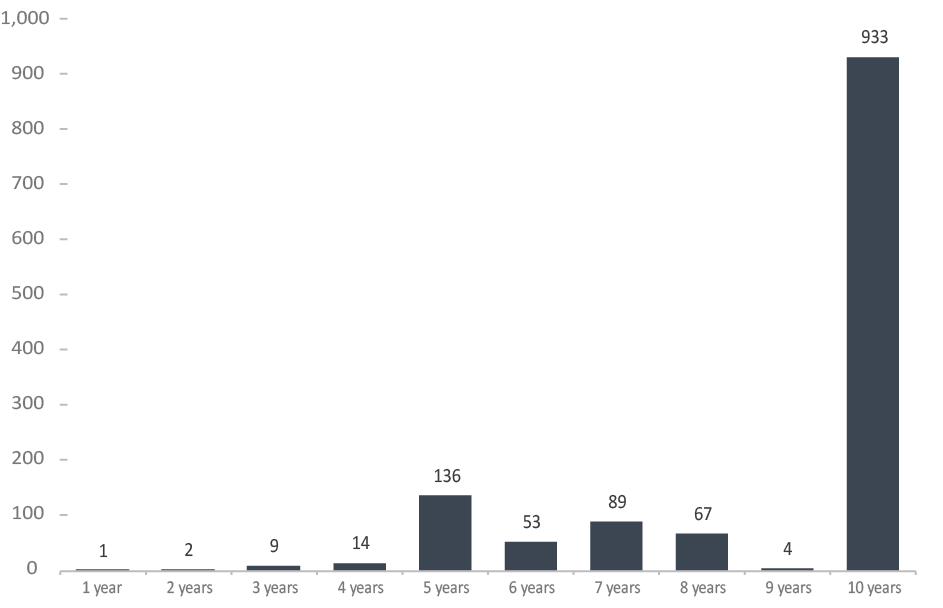
Source: Correctional Service of Canada.
- At the end of fiscal year 2018-19, the courts had imposed 1,308 long-term supervision orders. Of these, 71.3% were for a period of 10 years.
- At the end of fiscal year 2018-19, there were 915 offenders with long-term supervision orders under the responsibility of Correctional Service Canada, and of these, 581 (63.5%) had at least one current conviction for a sexual offence.
- There were 18 women with long-term supervision orders under the responsibility of Correctional Service Canada.
- There were 440 offenders being supervised in the community on their long-term supervision order at the end of the fiscal year 2018-19. Of these, 387 offenders were supervised in the community, six offenders were temporarily detained, 43 offenders were on remand, three offenders were unlawfully at large for less than 90 days and one offender was supervised and subject to an immigration hold by Canada Border Services Agency.
Notes:
Long-Term Supervision Order (LTSO) legislation, which came into effect in Canada on August 1, 1997, allows the court to impose a sentence of two years or more for the predicate offence and order that the offender be supervised in the community for a further period not exceeding 10 years.
Eighty-six offenders under these provisions have died, and 245 offenders have completed their long-term supervision period.
Remand is the temporary detention of a person while awaiting trial, sentencing or the commencement of a custodial disposition.
Province or Territory of Order |
Length of Supervision Order (Years) |
Current Status 2018-19 |
|||||||||||||||||||
1 |
2 |
3 |
4 |
5 |
6 |
7 |
8 |
9 |
10 |
Total |
Incarcerated |
DP, FP or SR* |
LTSO period |
LTSO** interrupted |
Total |
||||||
Sentencing Province |
|||||||||||||||||||||
Newfoundland & Labrador |
0 |
0 |
0 |
0 |
0 |
0 |
0 |
1 |
0 |
11 |
12 |
3 |
0 |
6 |
0 |
9 |
|||||
Nova Scotia |
0 |
0 |
0 |
0 |
5 |
0 |
1 |
3 |
0 |
13 |
22 |
5 |
1 |
6 |
1 |
13 |
|||||
Prince Edward Island |
0 |
0 |
0 |
0 |
1 |
0 |
0 |
0 |
0 |
1 |
2 |
0 |
0 |
0 |
0 |
0 |
|||||
New Brunswick |
0 |
0 |
1 |
0 |
2 |
0 |
0 |
1 |
0 |
8 |
12 |
3 |
0 |
1 |
3 |
7 |
|||||
Quebec |
1 |
1 |
7 |
4 |
70 |
20 |
43 |
15 |
2 |
279 |
442 |
116 |
17 |
148 |
31 |
312 |
|||||
Ontario |
0 |
0 |
1 |
7 |
20 |
14 |
21 |
26 |
0 |
290 |
379 |
76 |
16 |
150 |
35 |
277 |
|||||
Manitoba |
0 |
0 |
0 |
0 |
1 |
2 |
3 |
1 |
0 |
38 |
45 |
9 |
0 |
8 |
8 |
25 |
|||||
Saskatchewan |
0 |
1 |
0 |
1 |
11 |
9 |
13 |
12 |
2 |
80 |
129 |
42 |
10 |
32 |
18 |
102 |
|||||
Alberta |
0 |
0 |
0 |
0 |
8 |
1 |
0 |
1 |
0 |
69 |
79 |
14 |
2 |
26 |
7 |
49 |
|||||
British Columbia |
0 |
0 |
0 |
2 |
14 |
4 |
5 |
6 |
0 |
123 |
154 |
30 |
11 |
49 |
7 |
97 |
|||||
Yukon Territories |
0 |
0 |
0 |
0 |
1 |
0 |
3 |
0 |
0 |
16 |
20 |
7 |
0 |
8 |
0 |
15 |
|||||
Northwest Territories |
0 |
0 |
0 |
0 |
1 |
1 |
0 |
0 |
0 |
2 |
4 |
0 |
0 |
2 |
1 |
3 |
|||||
Nunavut |
0 |
0 |
0 |
0 |
2 |
2 |
0 |
1 |
0 |
3 |
8 |
0 |
0 |
4 |
2 |
6 |
|||||
Total |
1 |
2 |
9 |
14 |
136 |
53 |
89 |
67 |
4 |
933 |
1,308 |
305 |
57 |
440 |
113 |
915 |
|||||
Source: Correctional Service of Canada.
Notes:
*This category includes offenders whose current status is either supervised on day parole (DP), full parole (FP) or statutory release (SR).
**This category includes offenders convicted of a new offence while on the supervision portion of an LTSO. When this occurs, the LTSO supervision period is interrupted until the offender has served the new sentence to its warrant expiry date. At that time, the LTSO supervision period resumes where it left off. From the 113, 92 offenders were in custody, 18 were supervised in the community on statutory release and three offenders were unlawfully at large.
Long-Term Supervision Order (LTSO) legislation, which came into effect in Canada on August 1, 1997, allows the court to impose a sentence of two years or more for the predicate offence and order that the offender be supervised in the community for a further period not exceeding 10 years.
Eighty-six offenders under these provisions have died, and 245 offenders have completed their long-term supervision period.
The number of record suspension applications received has decreased
Figure E5
Number of record suspension and pardon applications received*
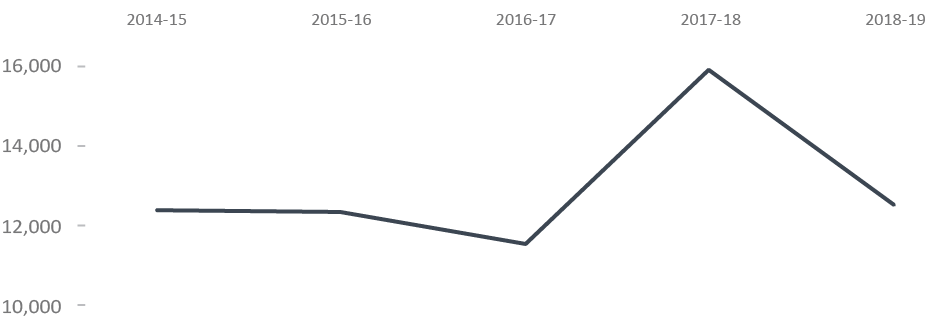
Source: Parole Board of Canada.
- In 2018-19, the Board received 7,364 record suspension applications and accepted 5,420 applications for processing. The Board also received 6,462 pardon applications and accepted 5,249 pardon applications for processing. The acceptance rate was 77%.
- In 2018-19, the Board rendered 4,444 pardon decisions, granting a pardon in 99% of cases and denying a pardon in 1% of cases.
- In 2018-19, the Board made 6,253 record suspension decisions; 96% of record suspensions were ordered and 4% were refused.
- Since 1970, when the pardon/record suspension process began, 535,615 pardons/record suspensions have been granted/issued and ordered.
Notes:
*Refers to pardon applications processed for residents of Ontario and British Columbia following the reversal of the amendments to the CRA (Canada Revenue Agency) by Supreme Court decisions in those provinces.
On March 13, 2012, Bill C-10 amended the CRA by replacing the term "pardon" with the term "record suspension". The Record Suspension and Clemency program involves the review of record suspension applications, the ordering of record suspensions and the making of clemency recommendations. The amendments to the CRA increased the waiting periods for a record suspension to five years for all summary convictions and to ten years for all indictable offences. Individuals convicted of sexual offences against minors (with certain exceptions) and those who have been convicted of more than three indictable offences, each with a sentence of two or more years, became ineligible for a record suspension.
Record Suspension Applications Processed |
2014-15 |
2015-16 |
2016-17 |
2017-18 |
2018-19 |
Received |
12,415 |
12,384 |
11,563 |
9,461 |
7,364 |
Accepted |
9,071 |
8,917 |
8,191 |
7,1671 |
5,420 |
% Accepted |
73.1% |
72.0% |
70.8% |
75.8% |
73.6% |
Record Suspensions |
|||||
Ordered |
8,422 |
8,428 |
8,340 |
7,038 |
6,026 |
Refused |
726 |
525 |
439 |
142 |
227 |
Total Ordered/Refused |
9,148 |
8,953 |
8,779 |
7,180 |
6,253 |
% Ordered |
92.1% |
94.1% |
95.0% |
98.0% |
96.4% |
Pardon Applications Processed |
|||||
Received |
-- |
-- |
-- |
5,2002 |
6,4622 |
Accepted |
-- |
-- |
-- |
4,4292 |
5,2492 |
% Accepted |
-- |
-- |
-- |
85.2% |
81.2% |
Pardons |
|||||
Granted |
5,625 |
1,628 |
3,740 |
222 |
2,630 |
Issued |
-- |
-- |
-- |
1,734 |
1,772 |
Denied |
681 |
349 |
125 |
133 |
42 |
Total Granted/Issued/Denied |
6,3063 |
1,9773 |
3,8653 |
2,0892 |
4,4442 |
% Granted |
89.2% |
82.3% |
96.8% |
93.6% |
99.1% |
Pardon/Record Suspension Revocations/Cessations |
|||||
Revocations4 |
438 |
670 |
501 |
85 |
58 |
Cessations |
578 |
636 |
776 |
692 |
527 |
Total Revocations/Cessations |
1,016 |
1,306 |
1,277 |
777 |
585 |
Cumulative # Granted/Issued and Ordered5 |
494,057 |
504,113 |
516,193 |
525,187 |
535,615 |
Cumulative # Revocations/Cessations5 |
23,337 |
24,643 |
25,920 |
26,697 |
27,282 |
Source: Parole Board of Canada.
Notes:
1Includes 638 record suspension applications that were discontinued and reclassified as pardon applications for residents of Ontario and British Columbia following the reversal of the amendments to the CRA by Supreme Court decisions in those provinces. 2Refers to pardon applications processed for residents of Ontario and British Columbia following the reversal of the amendments to the CRA by Supreme Court decisions in those provinces. 3Refers to pardon applications received on or before March 12, 2012 (C-10). 4Revocations fluctuate due to resource re-allocation to deal with backlogs. 5Cumulative data reflects activity since 1970, when the pardon process was established under the Criminal Records Act. On June 29, 2010, Bill C-23A amended the CRA by extending the ineligibility periods for certain applications for pardon. Additionally, the bill resulted in significant changes to program operations. The process was modified to include additional inquiries and new, more exhaustive investigations by staff for some applications and required additional review time by Board members. New concepts of merit and disrepute to the administration of justice form part of the statute. As a result of these new changes, application processing time increased. On March 13, 2012, Bill C-10 amended the CRA by replacing the term "pardon" with the term "record suspension". The Record Suspension and Clemency program involves the review of record suspension applications, the ordering of record suspensions and the making of clemency recommendations. The amendments to the CRA increased the waiting periods for a record suspension to five years for all summary convictions and to ten years for all indictable offences. Individuals convicted of sexual offences against minors (with certain exceptions) and those who have been convicted of more than three indictable offences, each with a sentence of two or more years, became ineligible for a record suspension.
Section F. Victims of Crime
Victimization rates for theft of personal property and assault decreased in 2014
Figure F1
Rate of victimization per 1,000 population
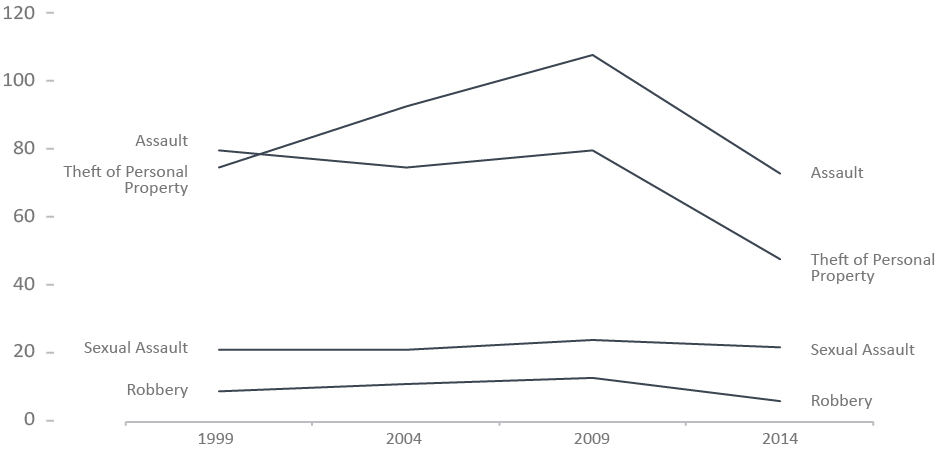
Source: General Social Survey, Statistics Canada, 1999, 2004, 2009 and 2014.
- Victimization rates for theft of personal property were lower in 2014 than in previous years.
- Victimization rates for assault were lower in 2014 than in previous years.
- Since 1999, the rates of victimization for sexual assault have remained stable.
Notes:
The General Social Survey is administered every five years by Statistics Canada. Updated data were not available during the preparation of this report. It is anticipated that updated data will be available in 2020.
Assault data includes incidents of spousal violence. In previous editions of this document, the victimization data excluded incidents of spousal violence.
Rates are based on 1,000 population, 15 years of age and older, across the 10 provinces.
Type of Incident |
Year |
||||
1999 |
2004 |
2009 |
2014 |
||
Theft of Personal Property |
75 |
93 |
108 |
73 |
|
Sexual Assault |
21 |
21 |
24 |
22 |
|
Robbery |
9 |
11 |
13 |
6 |
|
Assault* |
80 |
75 |
80 |
48 |
|
Source: General Social Survey, Statistics Canada, 1999, 2004, 2009 and 2014.
Notes:
The General Social Survey is administered every five years by Statistics Canada. Updated data were not available during the preparation of this report. It is anticipated that updated data will be available in 2020.
*Assault data includes incidents of spousal violence. In previous editions of this document, the victimization data excluded incidents of spousal violence.
Rates are based on 1,000 population, 15 years of age and older, across the 10 provinces.
The majority of victims of violent crime are under age 30
Figure F2
Percentage of victims of violent crime by age group (2012)
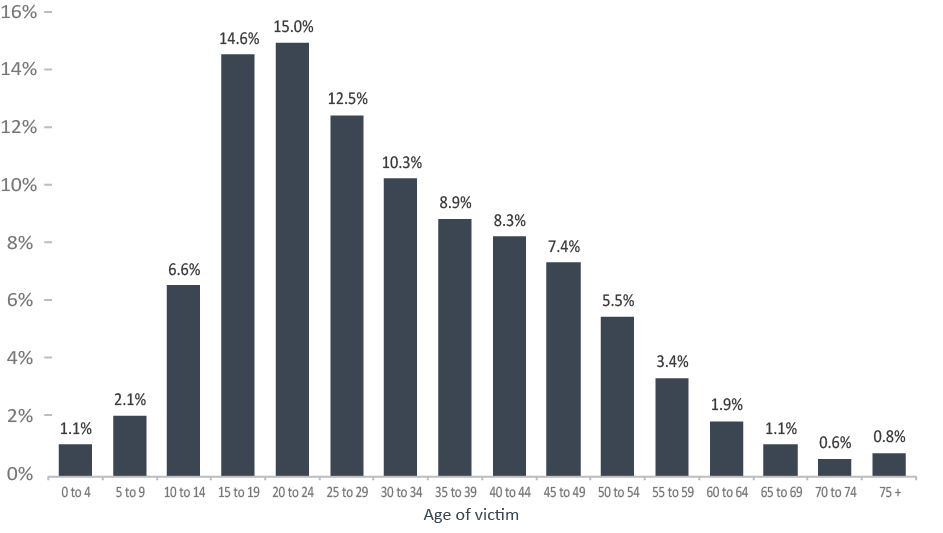
Source: Incident-based Uniform Crime Reporting Survey, Canadian Centre for Justice and Community Safety Statistics, Statistics Canada.
- More than half (51.9%) of all victims of violent crime reported in 2012 were under the age of 30, whereas 36.9% of the Canadian population is under the age of 30.*
- Women aged 15 to 39 were more likely than men of that age to be victims of crime.
- Canadians aged 65 and older, who account for 14.1% of the general population,* represent 2.4% of victims of crime.
Notes:
Updated data were not available during the preparation of this report.
*Population estimates are as of July 1, 2010.
The data excludes traffic violations, victims whose age is above 89, victims whose age is unknown and victims whose gender is unknown.
Due to rounding, totals may not add up to 100 percent.
Age of Victim |
Men |
Women |
Total |
||||||
# |
% |
# |
% |
# |
% |
||||
0 to 4 years |
1,761 |
1.0 |
2,053 |
1.1 |
3,814 |
1.1 |
|||
5 to 9 years |
3,803 |
2.2 |
3,724 |
2.0 |
7,527 |
2.1 |
|||
10 to 14 years |
11,716 |
6.7 |
12,109 |
6.5 |
23,825 |
6.6 |
|||
15 to 19 years |
25,294 |
14.4 |
27,674 |
14.9 |
52,968 |
14.6 |
|||
20 to 24 years |
24,712 |
14.1 |
29,380 |
15.8 |
54,092 |
15.0 |
|||
25 to 29 years |
21,477 |
12.2 |
23,897 |
12.9 |
45,374 |
12.5 |
|||
30 to 34 years |
17,282 |
9.8 |
20,001 |
10.8 |
37,283 |
10.3 |
|||
35 to 39 years |
14,829 |
8.4 |
17,403 |
9.4 |
32,232 |
8.9 |
|||
40 to 44 years |
14,607 |
8.3 |
15,456 |
8.3 |
30,063 |
8.3 |
|||
45 to 49 years |
13,568 |
7.7 |
13,038 |
7.0 |
26,606 |
7.4 |
|||
50 to 54 years |
10,965 |
6.2 |
9,051 |
4.9 |
20,016 |
5.5 |
|||
55 to 59 years |
6,983 |
4.0 |
5,149 |
2.8 |
12,132 |
3.4 |
|||
60 to 64 years |
4,081 |
2.3 |
2,792 |
1.5 |
6,873 |
1.9 |
|||
65 to 69 years |
2,321 |
1.3 |
1,605 |
0.9 |
3,926 |
1.1 |
|||
70 to 74 years |
1,128 |
0.6 |
977 |
0.5 |
2,105 |
0.6 |
|||
75 and over |
1,228 |
0.7 |
1,507 |
0.8 |
2,735 |
0.8 |
|||
Total |
175,755 |
100.0 |
185,816 |
100.0 |
361,571 |
100.0 |
|||
Source: Incident-based Uniform Crime Reporting Survey, Canadian Centre for Justice and Community Safety Statistics, Statistics Canada.
Notes:
Updated data were not available during the preparation of this report.
The data excludes traffic violations, victims whose age is above 89, victims whose age is unknown and victims whose gender is unknown.
Due to rounding, totals may not add up to 100 percent.
The majority of victims receiving services are victims of violent crime
Figure F3
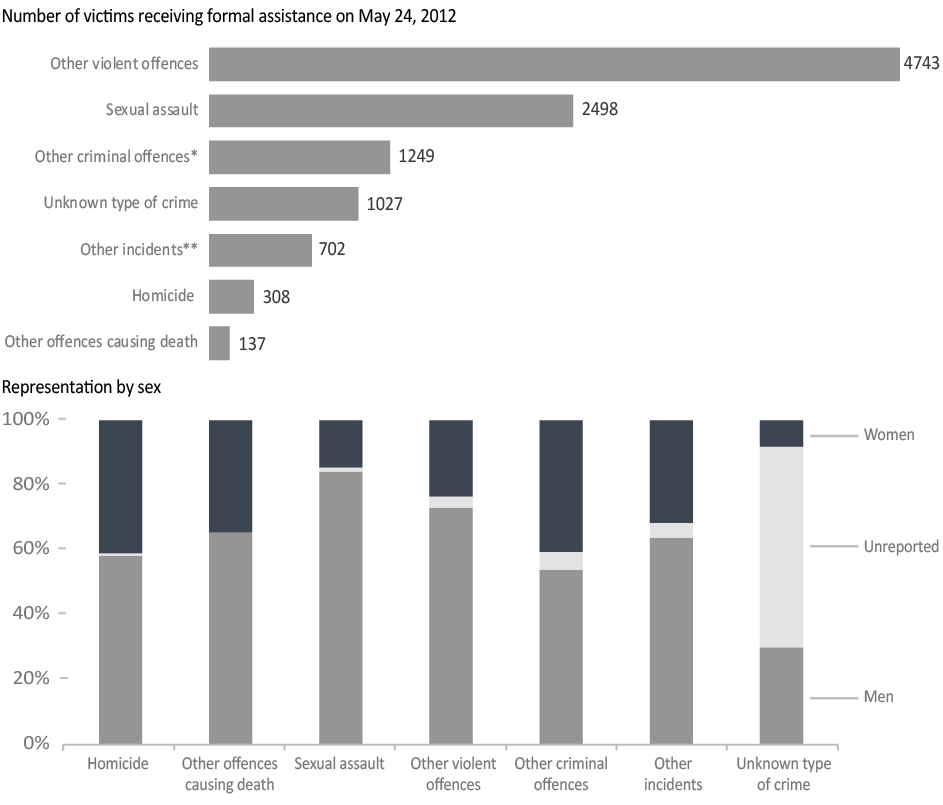
Sources: Victim Services in Canada, 2011/2012; Canadian Centre for Justice and Community Safety Statistics, Statistics Canada.
- On May 24, 2012, the Victim Services Survey snapshot day, 10,664 victims received formal assistance from a victim service office. This represents an increase of 12.7% from 9,462 on May 27, 2010. Of the 9,637 where the crime was known, the majority, 79.8% were victims of a violent crime.
- Of the 9,709 cases in which gender of the victim was noted, women accounted for 74.9% of the victims who received formal assistance from a victim service office, and men represented 25.1%.
- Of the 6,959 women who received formal assistance where the type of crime was known, 83.8% were victims of violent crime. A total of 2,105 women (30.2%) were victims of sexual assault.
- Of the 2,359 men who received formal assistance where the type of crime was known, 69.2% were victims of violent crime. A total of 356 men (15.1%) were victims of sexual assault.
Notes:
Updated data were not available during the preparation of this report.
Victim services are defined as agencies that provide direct services to primary or secondary victims of crime, and that are funded in whole or in part by a ministry responsible for justice matters. Survey respondents included 684 victim service providers.
Type of Crime |
Gender of Victim |
||||||||
Women |
Men |
Not Reported |
Total |
||||||
Snapshot on May 27, 2010 |
# |
% |
# |
% |
# |
% |
# |
% |
|
Homicide |
154 |
2.4 |
70 |
3.3 |
3 |
0.5 |
227 |
2.5 |
|
Other offences causing death |
95 |
1.5 |
77 |
3.7 |
8 |
1.4 |
180 |
2.0 |
|
Sexual assault |
1,922 |
30.0 |
379 |
18.1 |
160 |
28.3 |
2,461 |
27.1 |
|
Other violent offences |
3,323 |
51.8 |
917 |
43.8 |
262 |
46.4 |
4,502 |
49.6 |
|
Other criminal offences* |
496 |
7.7 |
357 |
17.0 |
73 |
12.9 |
926 |
10.2 |
|
Other incidents** |
421 |
6.6 |
295 |
14.1 |
59 |
10.4 |
775 |
8.5 |
|
Total without unknown |
6,411 |
100.0 |
2,095 |
100.0 |
565 |
100.0 |
9,071 |
100.0 |
|
Unknown type of crime |
197 |
— |
81 |
— |
113 |
— |
391 |
— |
|
Total |
6,608 |
2,176 |
678 |
9,462 |
|||||
Snapshot on May 24, 2012 |
|||||||||
Homicide |
179 |
2.6 |
126 |
5.3 |
3 |
0.9 |
308 |
3.2 |
|
Other offences causing death |
90 |
1.3 |
47 |
2.0 |
0 |
0.0 |
137 |
1.4 |
|
Sexual assault |
2,105 |
30.2 |
356 |
15.1 |
37 |
11.6 |
2,498 |
25.9 |
|
Other violent offences |
3,461 |
49.7 |
1,103 |
46.8 |
179 |
56.1 |
4,743 |
49.2 |
|
Other criminal offences* |
676 |
9.7 |
507 |
21.5 |
66 |
20.7 |
1,249 |
13.0 |
|
Other incidents** |
448 |
6.4 |
220 |
9.3 |
34 |
10.7 |
702 |
7.3 |
|
Total without unknown |
6,959 |
100.0 |
2,359 |
100.0 |
319 |
100.0 |
9,637 |
100.0 |
|
Unknown type of crime |
310 |
— |
81 |
— |
636 |
— |
1,027 |
— |
|
Total |
7,269 |
2,440 |
955 |
10,664 |
|||||
Sources: Victim Services in Canada, 2011/2012; Canadian Centre for Justice and Community Safety Statistics, Statistics Canada.
Notes:
Updated data were not available during the preparation of this report.
*Other criminal offences include arson, property crimes, traffic offences, and other Criminal Code offences.
**Other incidents include those of a non-criminal nature as well as those that are still under investigation to determine if they are criminal offences.
Victim services are defined as agencies that provide direct services to primary or secondary victims of crime, and that are funded in whole or in part by a ministry responsible for justice matters. Survey respondents included 684 victim service providers.
The number of victims registered with the federal correctional system has increased
Figure F4
Number of registered victims*
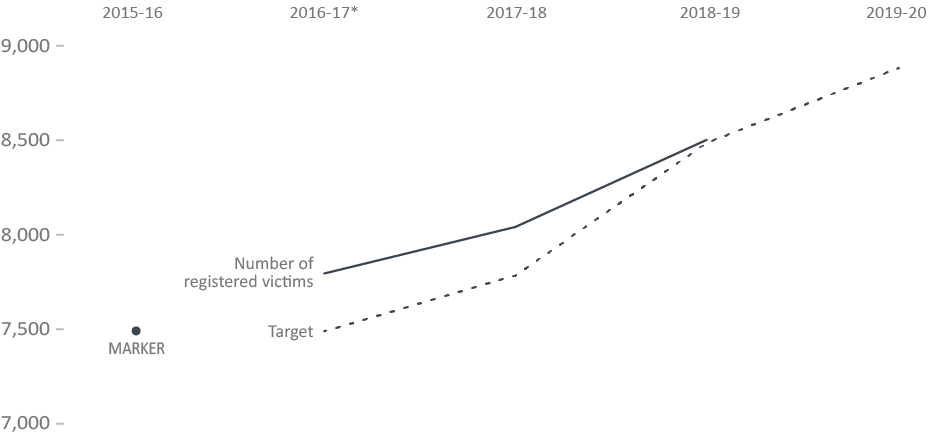
Source: Correctional Service of Canada.
- Since 2017-18, the number of victims registered with the federal correctional system has increased by 5.8%, from 8,053 to 8,517 in 2018-19.
- In 2017-18 and 2018-19, the number of registered victims with the federal correctional system surpassed the target. In 2017-18, the number of registered victims recorded was 253 above the target. In 2018-19, the number of registered victims recorded was 17 above the target.
- The estimated number of registered victims is expected to increase 4.5% from 8,517 in 2018-19 to 8,900 in 2019-20.
Notes:
*Indicator new as of the 2016-17 reporting cycle; therefore, data not available from 2013-14 to 2015-16.
A 'marker' was set for the new 2016-17 indicator, estimating the number of registered victims. This was done because CSC was changing from management of victim files within OMS, offender file based, to the newly built Victims Application Module (VAM), victim file based and no data was available until year end due to data migration. When Victim Services used OMS as its database, the prior indicator could not account for victims who were registered for more than one offender. Since the move to VAM, CSC can accurately capture the number of registered victims. For example, in the old system (OMS), one victim who was registered for six offenders would have counted as six registered victims; whereas in the new system (VAM), one registered victim who is registered for six offenders is accurately counted as one registered victim.
Year |
Target |
Number of Registered Victims |
Marker |
2015-16 |
N/A |
N/A |
7,500 |
2016-17* |
7,500 Marker** |
7,806*** |
- - |
2017-18 |
7,800 |
8,053 |
- - |
2018-19 |
8,500 |
8,517 |
- - |
2019-20 |
8,900 |
- - |
- - |
Source: Correctional Service of Canada.
Notes:
*Indicator new as of the 2016-17 reporting cycle; therefore, data not available from 2013-14 to 2015-16.
**A 'marker' was set for the new 2016-17 indicator, estimating the number of registered victims. This was done because CSC Services was changing from management of victim files within OMS, offender file based, to the newly built Victims Application Module (VAM), victim file based and no data was available until year end due to data migration.
***When Victim Services used OMS as its database, the prior indicator could not account for victims who were registered for more than one offender. Since the move to VAM, CSC can accurately capture the number of registered victims. For example, in the old system (OMS), one victim who was registered for six offenders would have counted as six registered victims; whereas in the new system (VAM), one registered victim who is registered for six offenders is accurately counted as one registered victim.
- - data not available.
74% of registered victims were victims of an offence causing death
Figure F5
Offences of victimization* (2015-16)
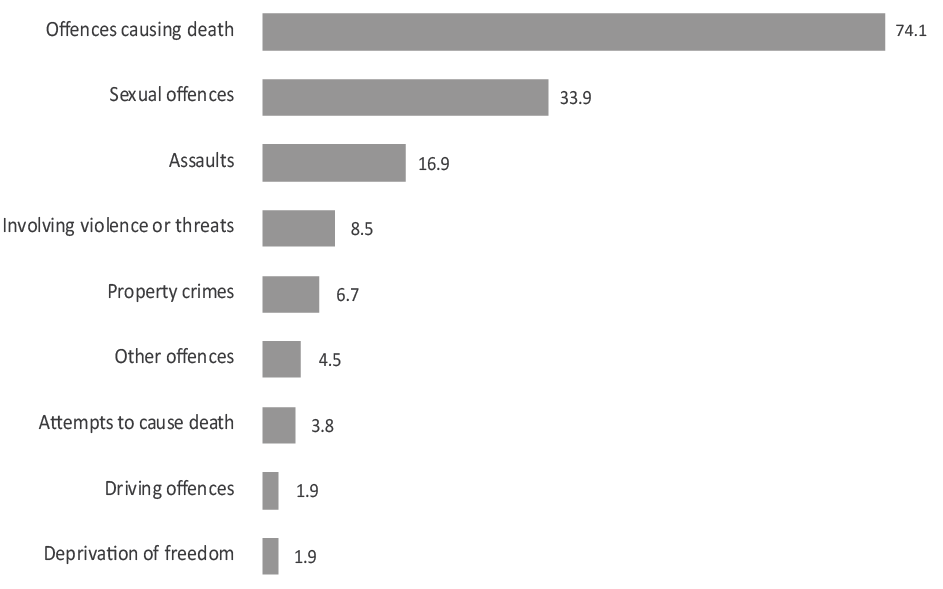
Source: Correctional Service of Canada.
- Of the 8,303 registered victims, 74.1% (6,151) were victims of an offence that caused death.**
- Victims of sexual offences (2,817) accounted for 33.9% of the registered victims.
- Victims of assault (1,401) and victims of offences involving violence or threats (706) accounted for 16.9% and 8.5% of the registered victims.
Notes:
In 2016, CSC implemented the new Victims Application Module (VAM). Following some implementation and development challenges, CSC has worked towards greater stabilization of the VAM system. This caused a delay in the creation of a new reporting mechanism. For this reason, CSC is unable to report beyond the number of registered victims and is working to develop a new reporting mechanism for VAM.
In order to register to receive information under sections 26 and 142 of the Corrections and Conditional Release Act (CCRA), a person must meet the definition of a victim that appears in section 2, or subsections 26(3) or 142(3) of the Act. Victims can register with the Correctional Service of Canada or the Parole Board of Canada by completing a Victims Request for Information form, though a signed letter of request can be considered as meeting this requirement.
*Some victims were harmed by more than one offence; therefore, the number of Offences of Victimization are higher than the actual number of Registered Victims. The percentages represent the number of registered victims who were harmed by that offence.
**Under the CCRA, a person is a victim of a crime if: they are a spouse, conjugal partner, relative of, or person legally responsible for, a victim who has died.
Type of Offence** That Harmed Victim* |
2011-12 |
2012-13 |
2013-14 |
2014-15 |
2015-16 |
|||||
# |
% |
# |
% |
# |
% |
# |
% |
# |
% |
|
Offences Causing Death*** |
4,056 |
55.4 |
4,292 |
56.6 |
4,533 |
57.8 |
5,432 |
68.5 |
6,151 |
74.1 |
Sexual Offences |
2,114 |
28.9 |
2,169 |
28.6 |
2,237 |
28.5 |
2,493 |
31.4 |
2,817 |
33.9 |
Assaults |
998 |
13.6 |
965 |
12.7 |
941 |
12.0 |
1,178 |
14.9 |
1,401 |
16.9 |
Involving Violence or Threats |
707 |
9.7 |
710 |
9.4 |
720 |
9.2 |
849 |
10.7 |
706 |
8.5 |
Property Crimes |
534 |
7.3 |
551 |
7.3 |
541 |
6.9 |
617 |
7.8 |
558 |
6.7 |
Other Offences |
452 |
6.2 |
441 |
5.8 |
475 |
6.1 |
583 |
7.4 |
377 |
4.5 |
Deprivation of Freedom |
272 |
3.7 |
281 |
3.7 |
249 |
3.2 |
330 |
4.2 |
157 |
1.9 |
Attempts to Cause Death |
241 |
3.3 |
246 |
3.2 |
283 |
3.6 |
299 |
3.8 |
318 |
3.8 |
Driving Offences |
125 |
1.7 |
152 |
2.0 |
153 |
2.0 |
163 |
2.1 |
157 |
1.9 |
Offence Not Recorded |
6 |
0.1 |
4 |
0.1 |
9 |
0.1 |
85 |
1.1 |
0 |
0.0 |
Total Number of Victims** |
7,322 |
7,585 |
7,838 |
7,929 |
8,303 |
|||||
Source: Correctional Service of Canada.
Notes:
In 2016, CSC implemented the new Victims Application Module (VAM). Following some implementation and development challenges, CSC has worked towards greater stabilization of the VAM system. This caused a delay in the creation of a new reporting mechanism. For this reason, CSC is unable to report beyond the number of registered victims and is working to develop a new reporting mechanism for VAM.
*In order to register to receive information under sections 26 and 142 of the Corrections and Conditional Release Act (CCRA), a person must meet the definition of a victim that appears in section 2, or subsections 26(3) or 142(3) of the Act. Victims can register with the Correctional Service of Canada or the Parole Board of Canada by completing a Victims Request for Information form, though a signed letter of request can be considered as meeting this requirement.
**Some victims were harmed by more than one offence; therefore, the number of Offences of Victimization are higher than the actual number of Registered Victims. The percentages represent the number of registered victims who were harmed by that offence.
***Under the CCRA, a person is a victim of a crime if: they are a spouse, conjugal partner, relative of, or person legally responsible for, a victim who has died.
51% of notifications to registered victims were temporary absences
Figure F6
Frequency of type of information disclosed (2015-16)
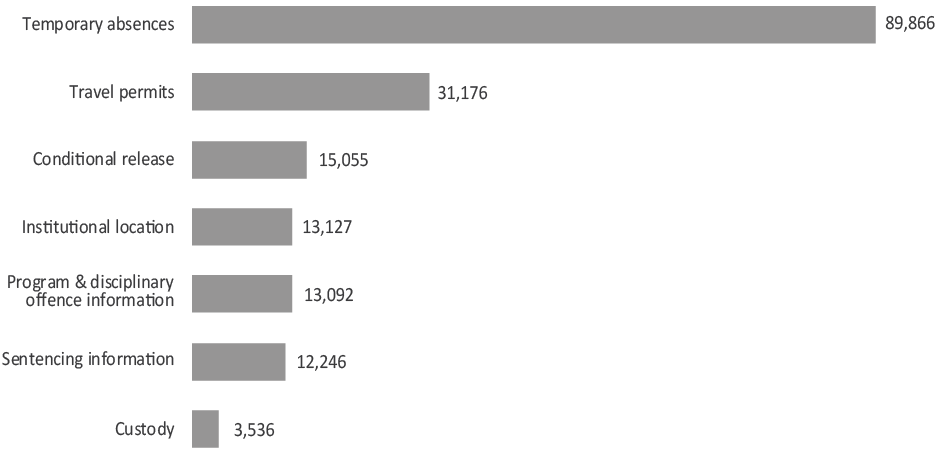
Source: Correctional Service Canada.
- In 2015-16, information on Temporary Absences (50.5%) and Travel Permits (17.5%) were the most frequent pieces of information about offenders that were provided during a notification to registered victims. There has been a 44.6% increase in the number of pieces of information provided to registered victims during notifications from 123,136 in 2011-12 to 178,098 in 2015-16.
Notes:
In 2016, CSC implemented the new Victims Application Module (VAM). Following some implementation and development challenges, CSC has worked towards greater stabilization of the VAM system. This caused a delay in the creation of a new reporting mechanism. For this reason, CSC is unable to report beyond the number of registered victims and is working to develop a new reporting mechanism for VAM.
Temporary absence information includes information on unescorted and escorted temporary absences and work release. Conditional release information includes information regarding day and full parole, statutory release, suspensions, detention, and long-term supervision orders. Sentencing information includes information on the offender's sentence, offender information, warrant expiry date, judicial review, and public domain. Disclosure means a type of information identified in section 26 of the Corrections and Conditional Release Act (CCRA) that has been disclosed to a registered victim during a notification. As of December 2, 2011, as per Bill S6, Correctional Service Canada now provides information to some victims who are not registered which requires providing information to family members of murdered victims where the offender is still eligible to apply for Judicial Review including when the offender does not apply for a Judicial Review within the allotted time period, as well as the next date the offender can apply. Notification to unregistered victims are excluded for the data.
In order to register to receive information under sections 26 and 142 of the CCRA, a person must meet the definition of a victim that appears in section 2, or subsections 26(3) or 142(3) of the Act. Victims can register with the Correctional Service of Canada or the Parole Board of Canada by completing a Victims Request for Information form, though a signed letter of request can be considered as meeting this requirement.
Information disclosed to victim |
2011-12 |
2012-13 |
2013-14 |
2014-15 |
2015-16 |
Temporary Absences |
75,848 |
93,609 |
100,934 |
96,131 |
89,866 |
Travel Permits |
10,877 |
28,763 |
34,294 |
34,501 |
31,176 |
Institutional Location |
6,859 |
14,434 |
17,495 |
16,242 |
13,127 |
Program & Disciplinary Offence Information |
-- |
11,208 |
14,826 |
16,790 |
13,092 |
Conditional Release |
10,870 |
11,803 |
12,318 |
13,253 |
15,055 |
Sentencing Information |
16,268 |
12,813 |
10,333 |
10,792 |
12,246 |
Custody |
2,414 |
2,569 |
2,476 |
2,423 |
3,536 |
Total |
123,136 |
175,199 |
192,676 |
190,132 |
178,098 |
Source: Correctional Service Canada.
Notes:
In 2016, CSC implemented the new Victims Application Module (VAM). Following some implementation and development challenges, CSC has worked towards greater stabilization of the VAM system. This caused a delay in the creation of a new reporting mechanism. For this reason, CSC is unable to report beyond the number of registered victims and is working to develop a new reporting mechanism for VAM.
Temporary Absence information includes information on unescorted and escorted temporary absences and work release. Conditional Release information includes information regarding day and full parole, statutory release, suspensions, detention, and long-term supervision orders. Sentencing information includes information on the offender's sentence, offender information, warrant expiry date, judicial review, and public domain.
Disclosure means a type of information identified in section 26 of the Corrections and Conditional Release Act (CCRA) that has been disclosed to a registered victim during a notification.
As of December 2, 2011, as per Bill S6, Correctional Service Canada now provides information to some victims who are not registered which requires providing information to family members of murdered victims where the offender is still eligible to apply for Judicial Review including when the offender does not apply for a Judicial Review within the allotted time period, as well as the next date the offender can apply. Notification to unregistered victims are excluded for the data.
In order to register to receive information under section 26 and 142 of the CCRA, a person must meet the definition of a victim that appears in section 2 or subsection 26(3) or 142(3) of the Act. Victims can register with the Correctional Service of Canada or the Parole Board of Canada by completing a Victims Request for Information form, though a signed letter of request can be considered as meeting this requirement.
Parole Board of Canada contacts with victims has increased
Figure F7
Total number of PBC contacts with victims
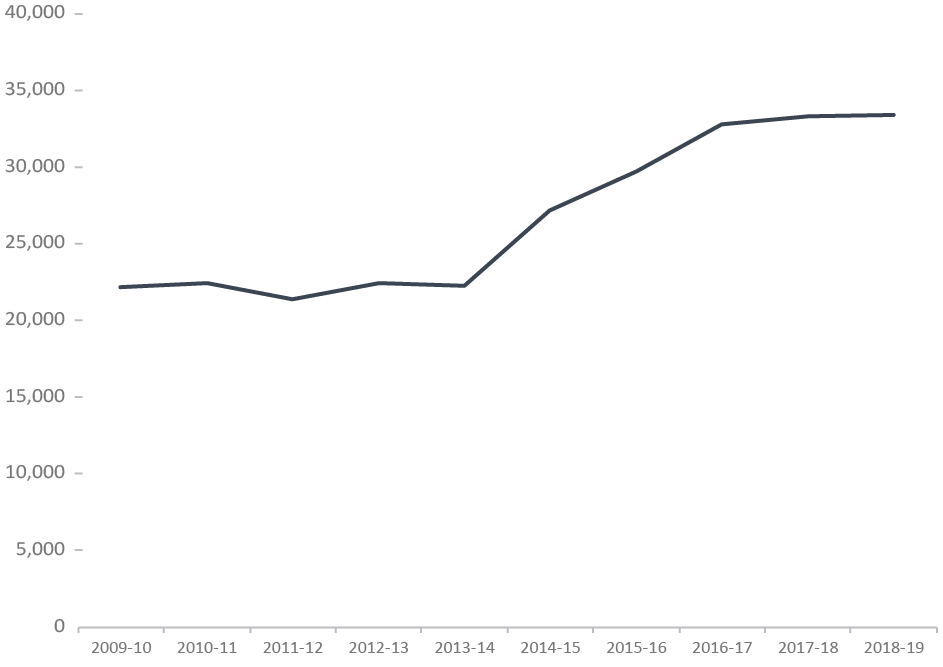
Source: Parole Board of Canada.
- In 2018-19, PBC reported 33,408 contacts* with victims, 38 more contacts compared to the previous year.
- In the last 10 years, the number of PBC contacts with victims increased by 51% (11,227 more contacts).
Note:
*A victim contact refers to each time the Parole Board of Canada has contact with a victim by mail, fax, or by telephone.
Year |
Total Number of Contacts* |
2009-10 |
22,181 |
2010-11 |
22,483 |
2011-12 |
21,449 |
2012-13 |
22,475 |
2013-14 |
22,323 |
2014-15 |
27,191 |
2015-16 |
29,771 |
2016-17 |
32,786 |
2017-18 |
33,370 |
2018-19 |
33,408 |
Source: Parole Board of Canada.
Note:
*A victim contact refers to each time the Parole Board of Canada has contact with a victim by mail, fax, or by telephone.
Victims presenting a statement at PBC hearings
Figure F8
Total number of victim presentations vs. the number of hearings with victim presentations
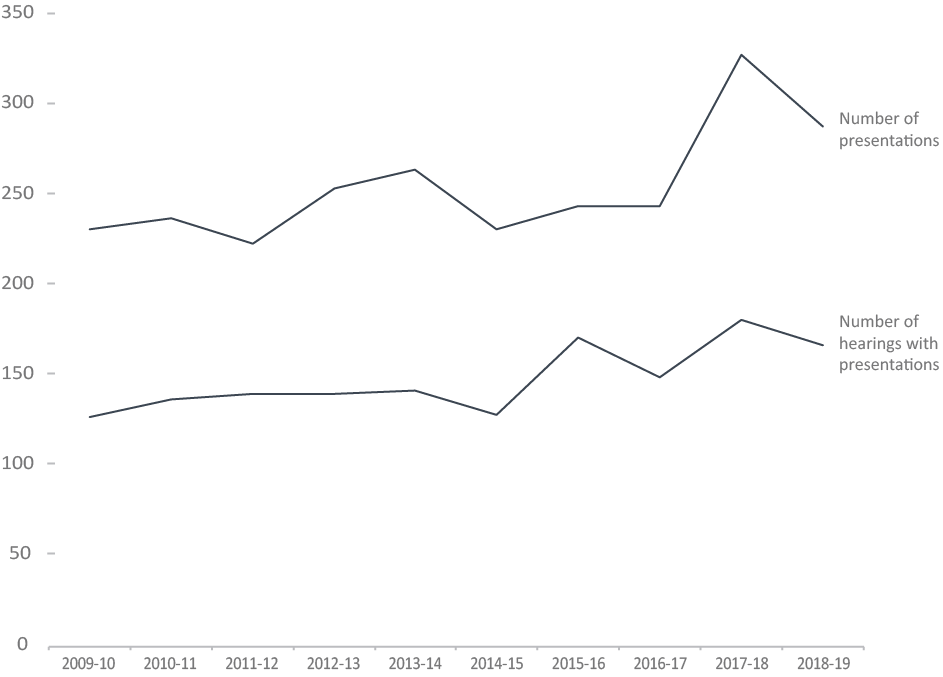
Source: Parole Board of Canada.
- In 2018-19, victims made 288 presentations (-12% or -40 from 2017-18) at 167 hearings (-8% or -14 from 2017-18).
- In the last 10 years, the number of victims who present a statement at hearings has been fluctuating. The highest number (328) was recorded in 2017-18. In 2018-19, the number of victims who present a statement at hearings increased by 25% (57 more presentations) compared to 2009-10.
- Between 2009-10 and 2018-19, the majority of presentations were done in person (89%) followed by presentations via video conferencing or teleconferencing (7%) and pre-recorded presentations (audiotape or videotape/DVD) (4%).
- The major offence of victimization for victims making presentations in 2018-19 was most likely to have been murder (51%), sexual assault (13%), and manslaughter (10%).
Year |
Number of Hearings with Presentations |
Number of Presentations |
2009-10 |
127 |
231 |
2010-11 |
137 |
237 |
2011-12 |
140 |
223 |
2012-13 |
140 |
254 |
2013-14 |
142 |
264 |
2014-15 |
128 |
231 |
2015-16 |
171 |
244 |
2016-17 |
149 |
244 |
2017-18 |
181 |
328 |
2018-19 |
167 |
288 |
Source: Parole Board of Canada.
Victims requesting access to the decision registry
Figure F9
Total number of requests for access to the decision registry vs. requests for access made by victims
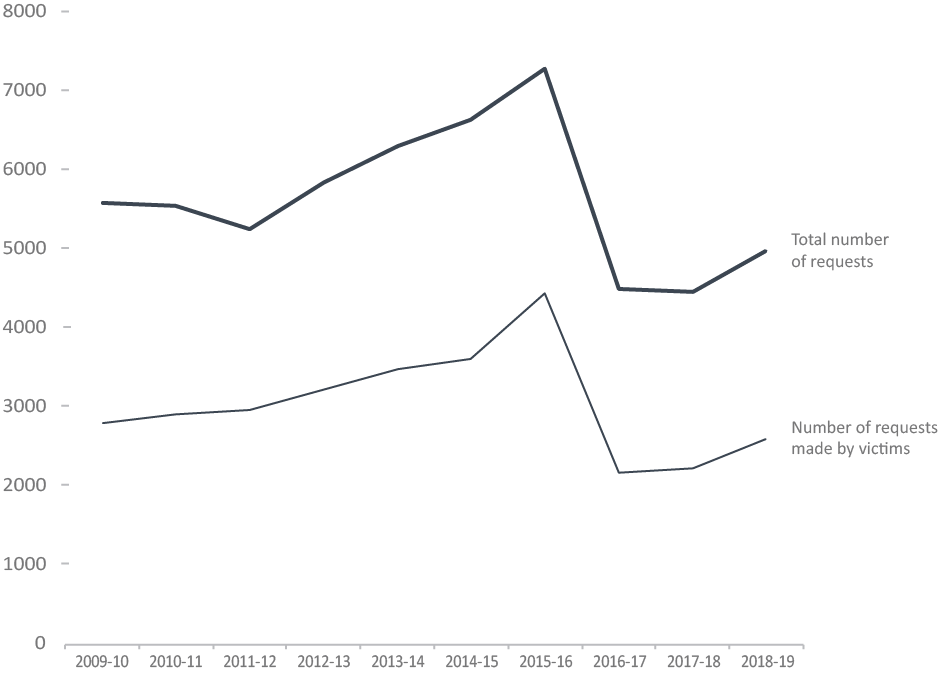
Source: Parole Board of Canada.
- Although from 2015-16 to 2016-17 there was a substantial decrease (-51.1%) in the number of requests for access to the decision registry* made by victims, for the following two years the number of requests increased, from 2,169 in 2016-17 to 2,227 (+2.7%) in 2017-18, and from 2,227 in 2017-18 to 2,601 (+16.8%) in 2018-19.
- When averaged over the last ten years (between 2009-10 and 2018-19), 53.9% of request for access to the decision registry were made by victims.
Notes:
Victims also include victims' agents and victims' organizations.
*Since November 1, 1992, the Corrections and Conditional Release Act (CCRA) requires the Parole Board of Canada (PBC) to maintain a registry of its decisions along with the reasons for those decisions. Anyone may request, in writing, a copy of these decisions.
Year |
Request made by victims* |
Total number of requests |
|
# |
% |
||
2009-10 |
2,803 |
50.1 |
5,591 |
2010-11 |
2,914 |
52.5 |
5,550 |
2011-12 |
2,970 |
56.5 |
5,252 |
2012-13 |
3,214 |
55.0 |
5,848 |
2013-14 |
3,474 |
55.1 |
6,309 |
2014-15 |
3,608 |
54.3 |
6,640 |
2015-16 |
4,436 |
61.0 |
7,276 |
2016-17 |
2,169 |
48.2 |
4,502 |
2017-18 |
2,227 |
49.9 |
4,467 |
2018-19 |
2,601 |
52.4 |
4,967 |
Source: Parole Board of Canada.
Note:
*Also include victims' agents and victims' organizations.
- Date modified: